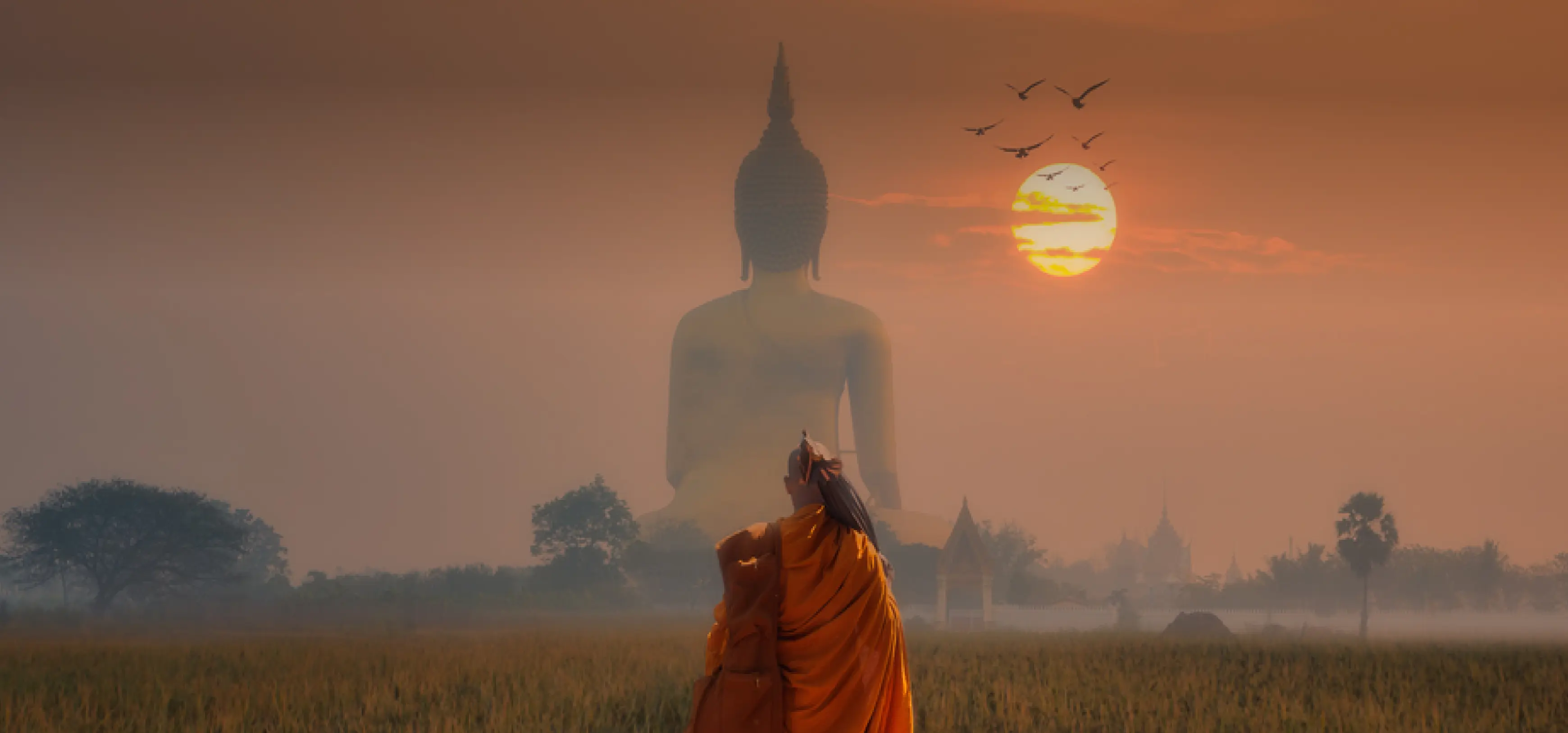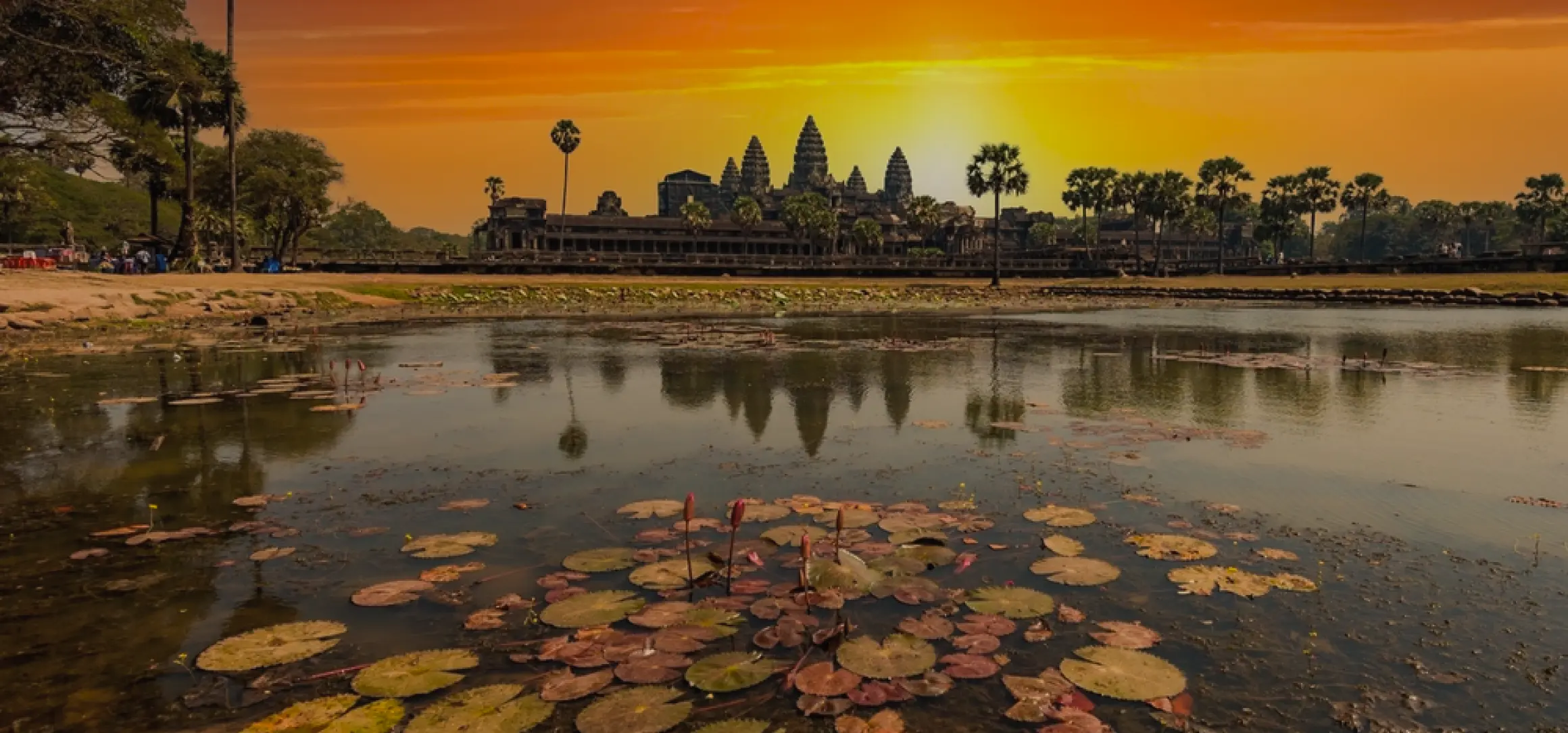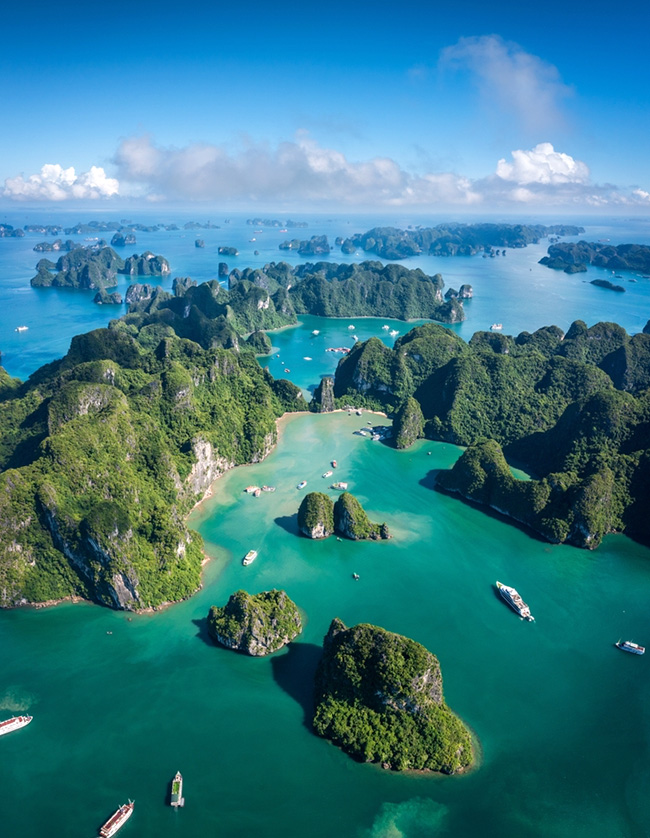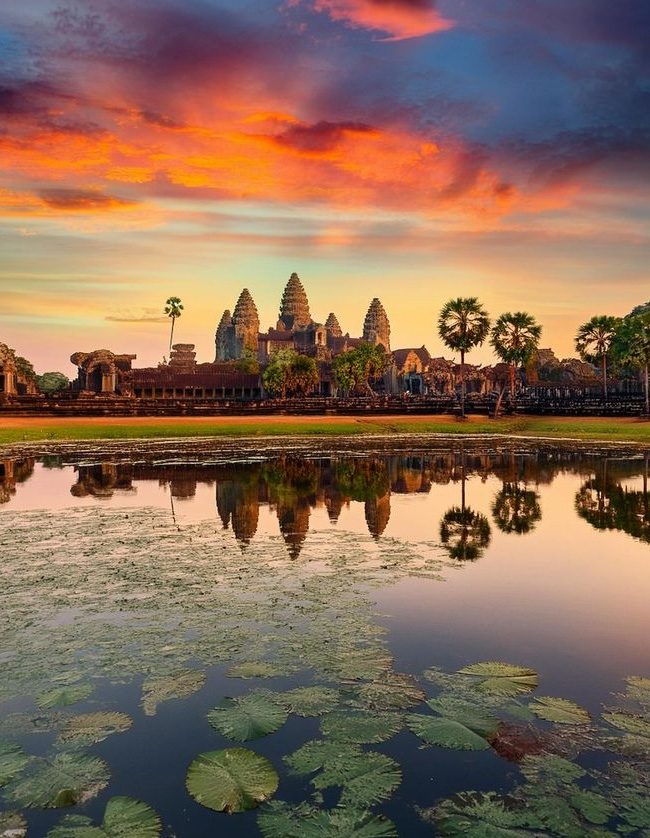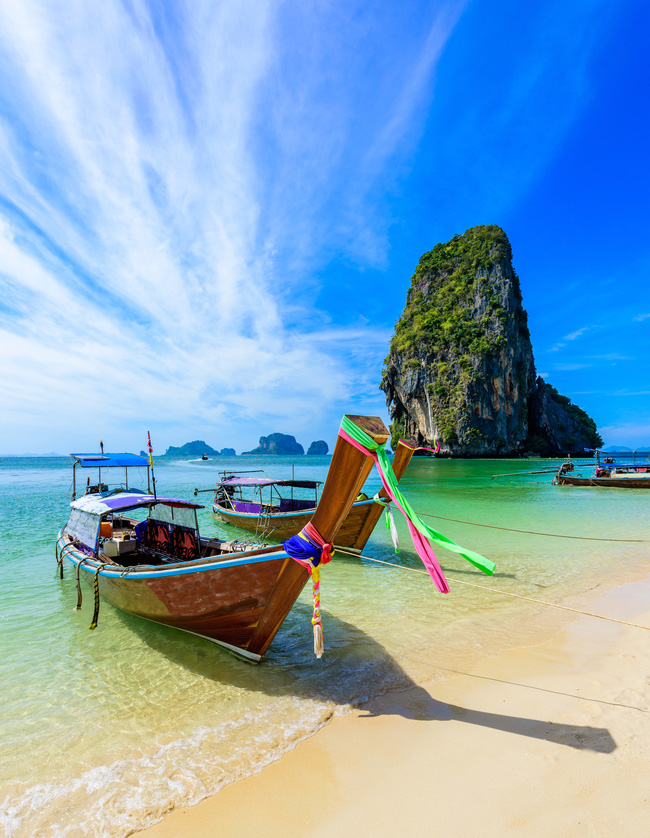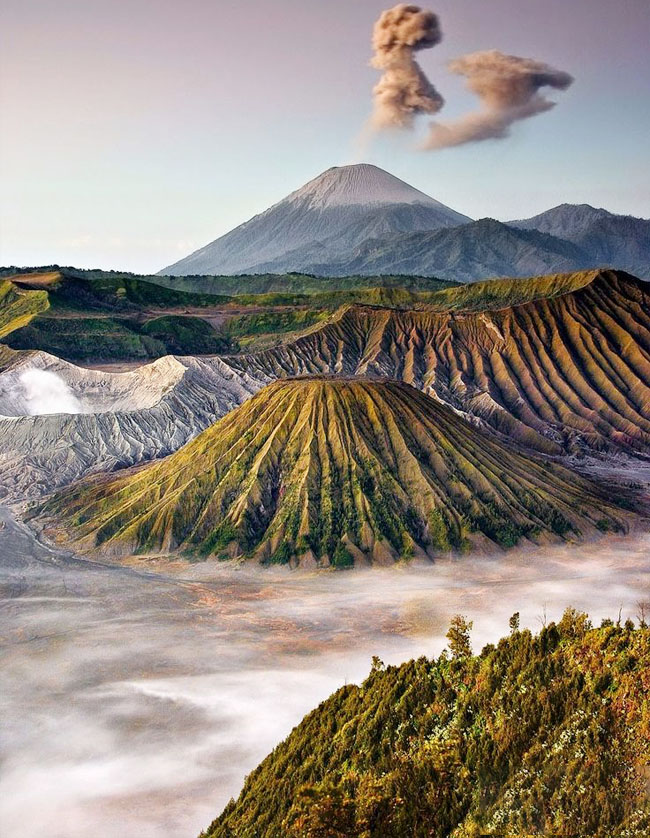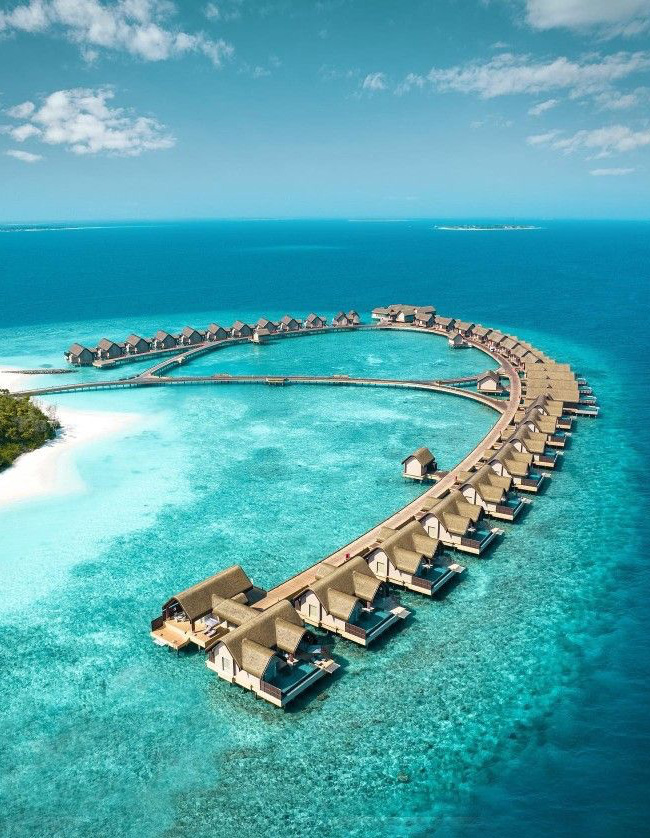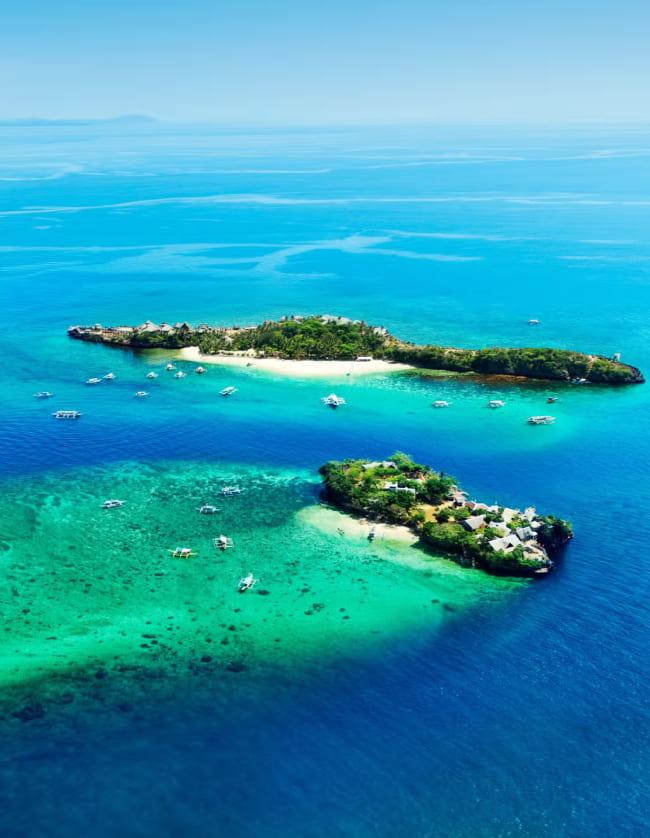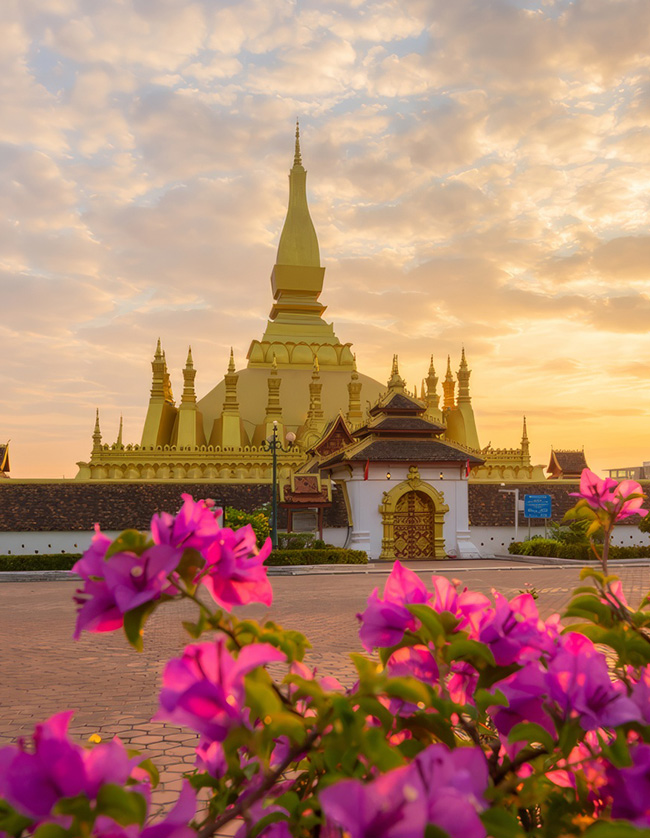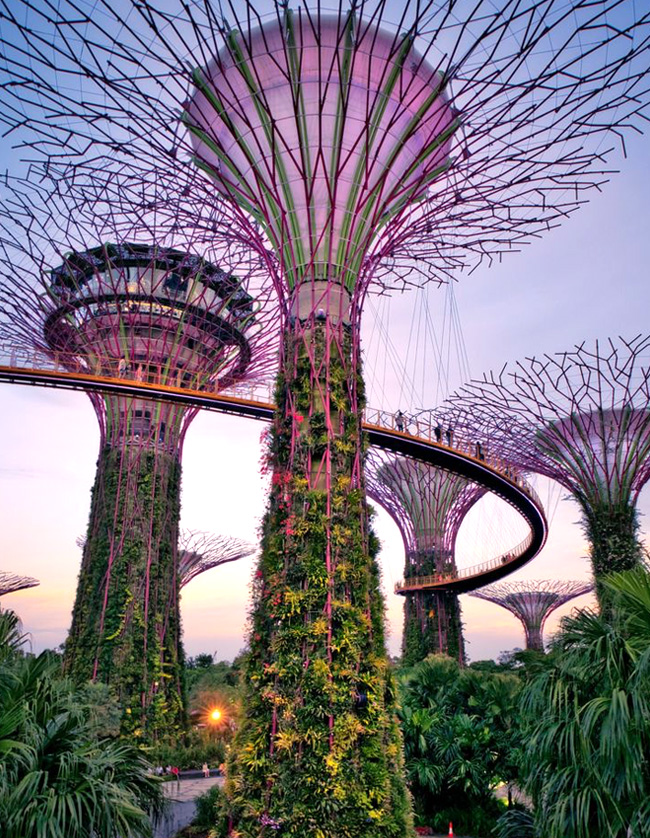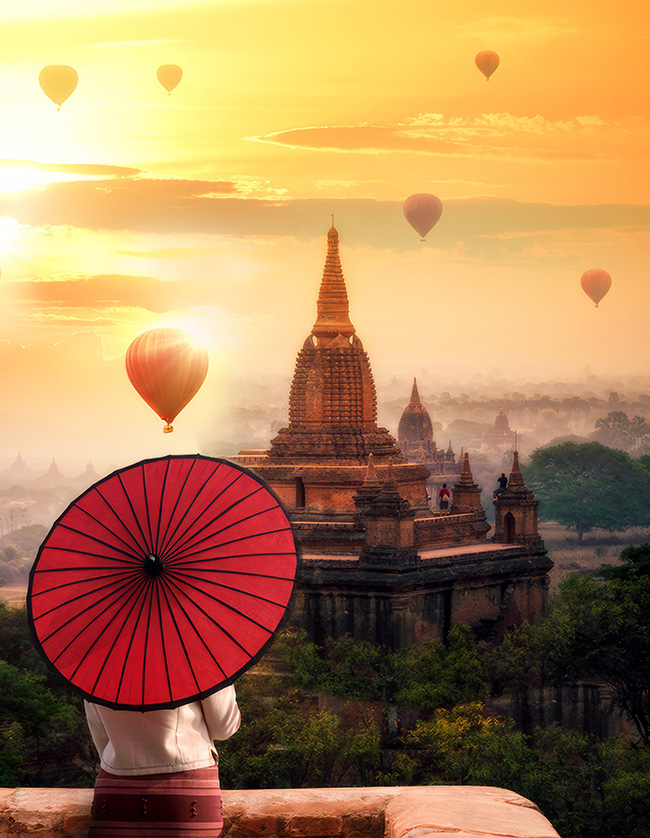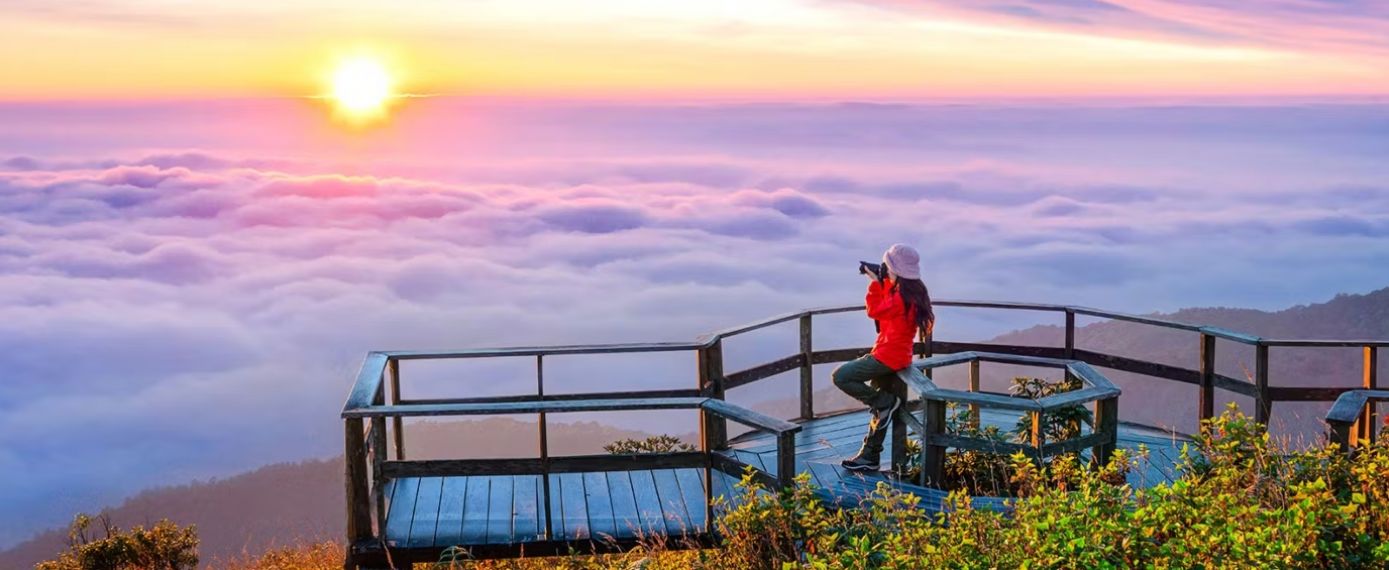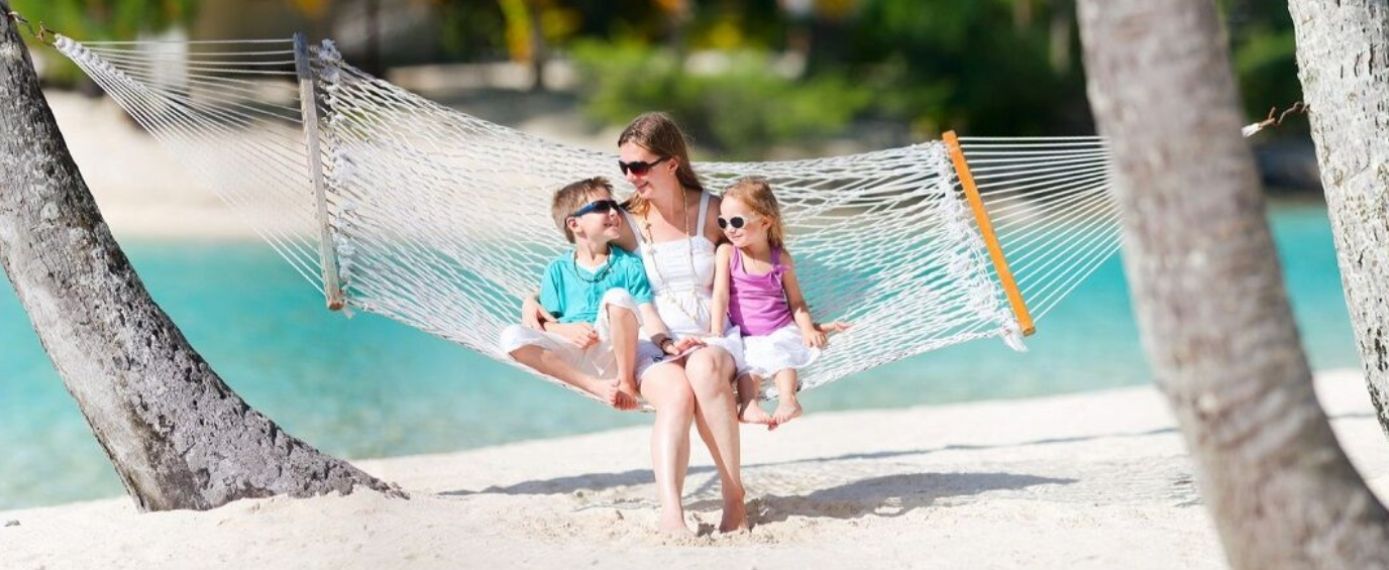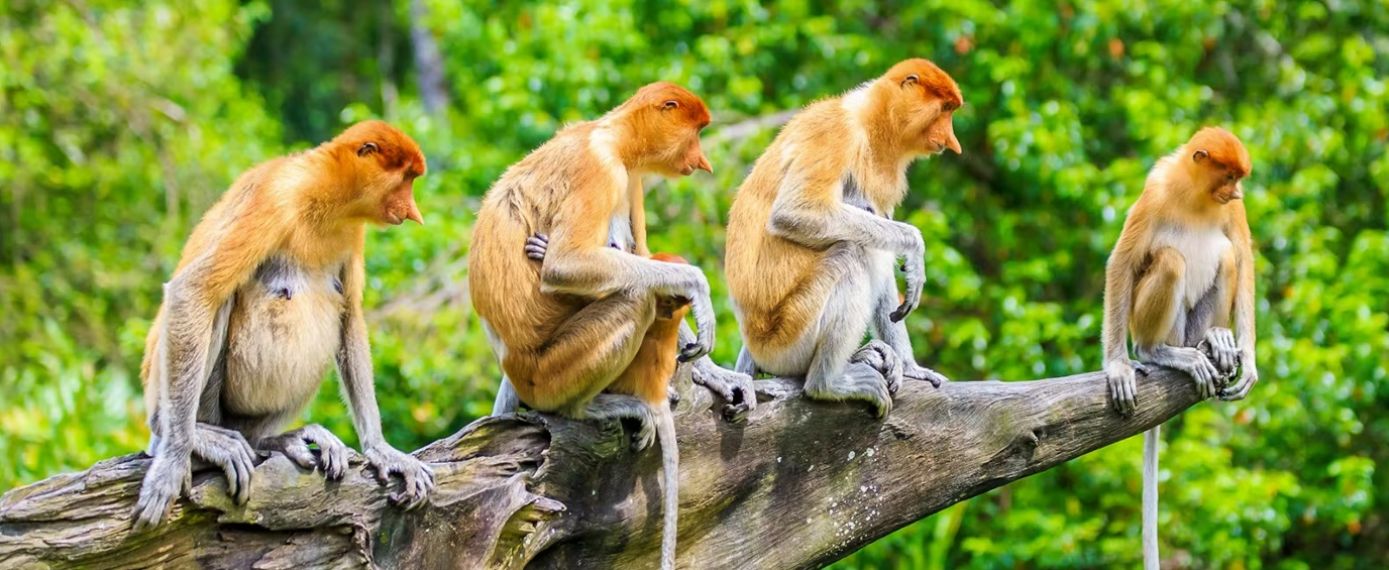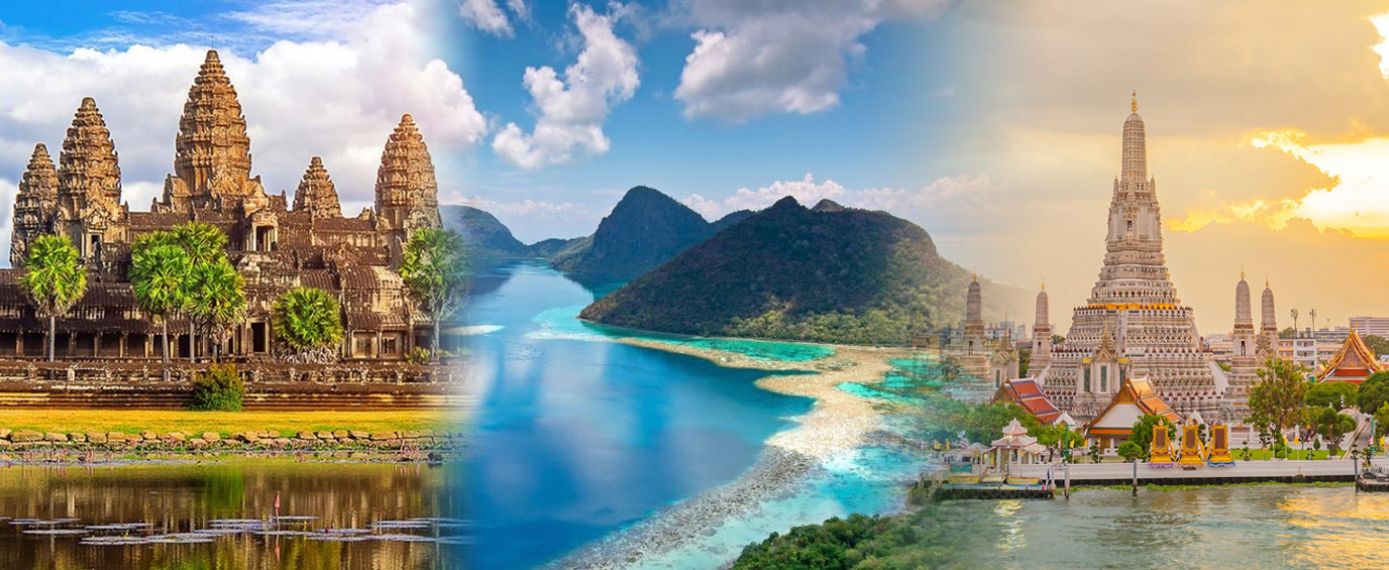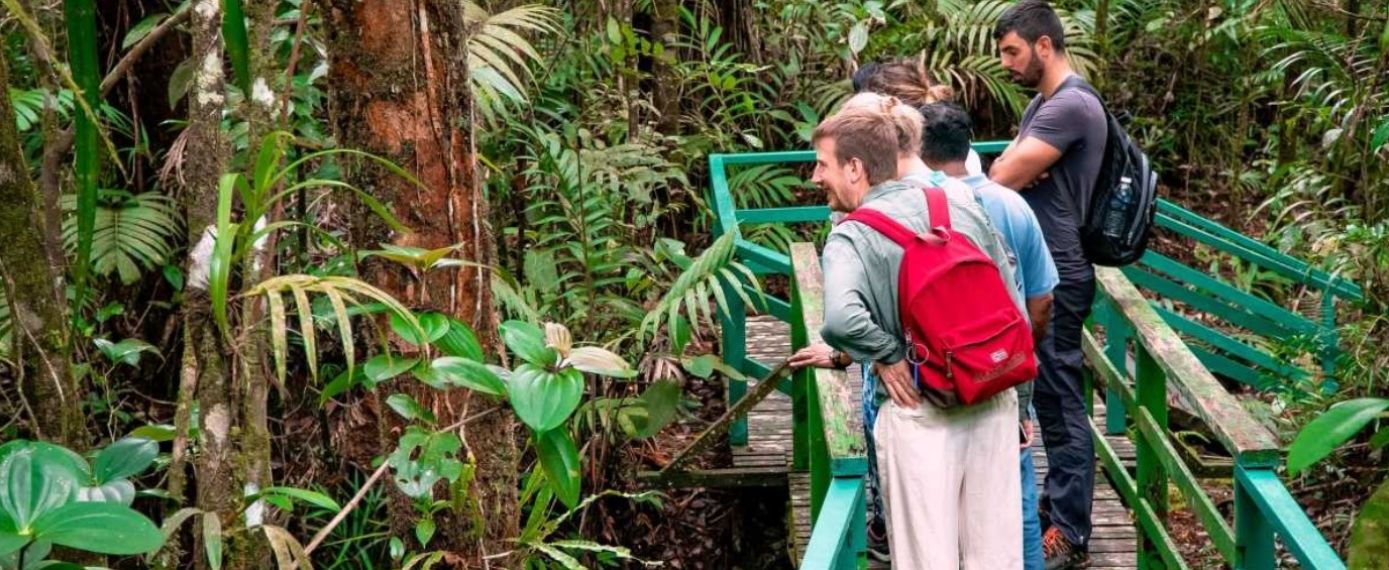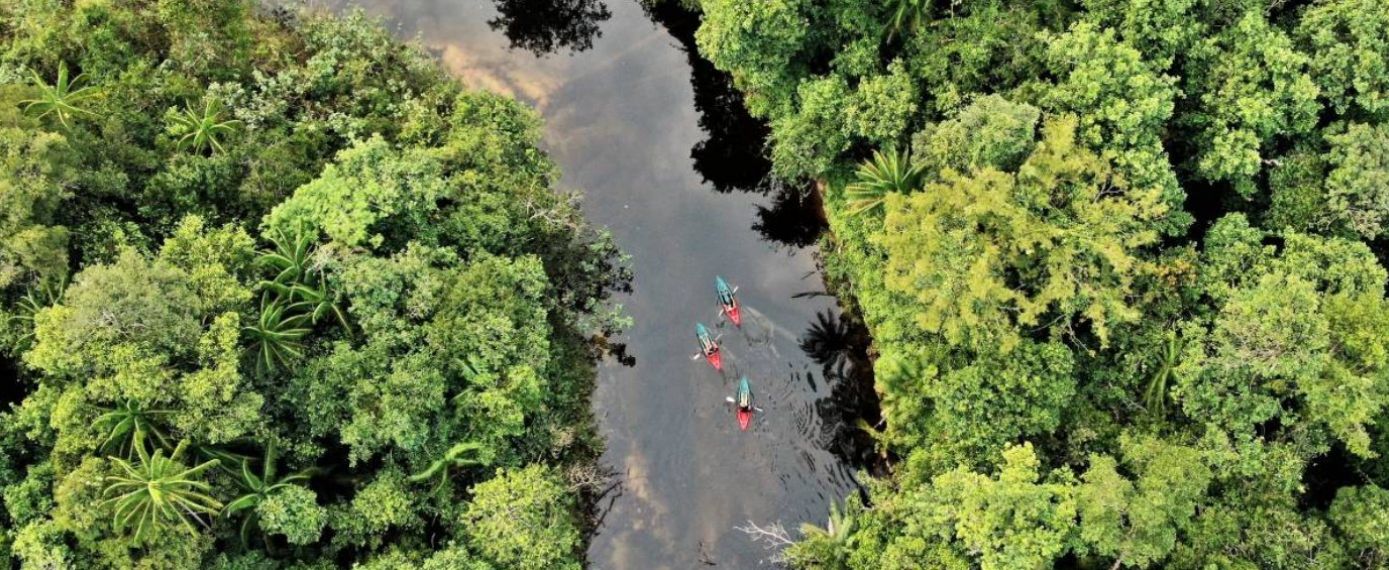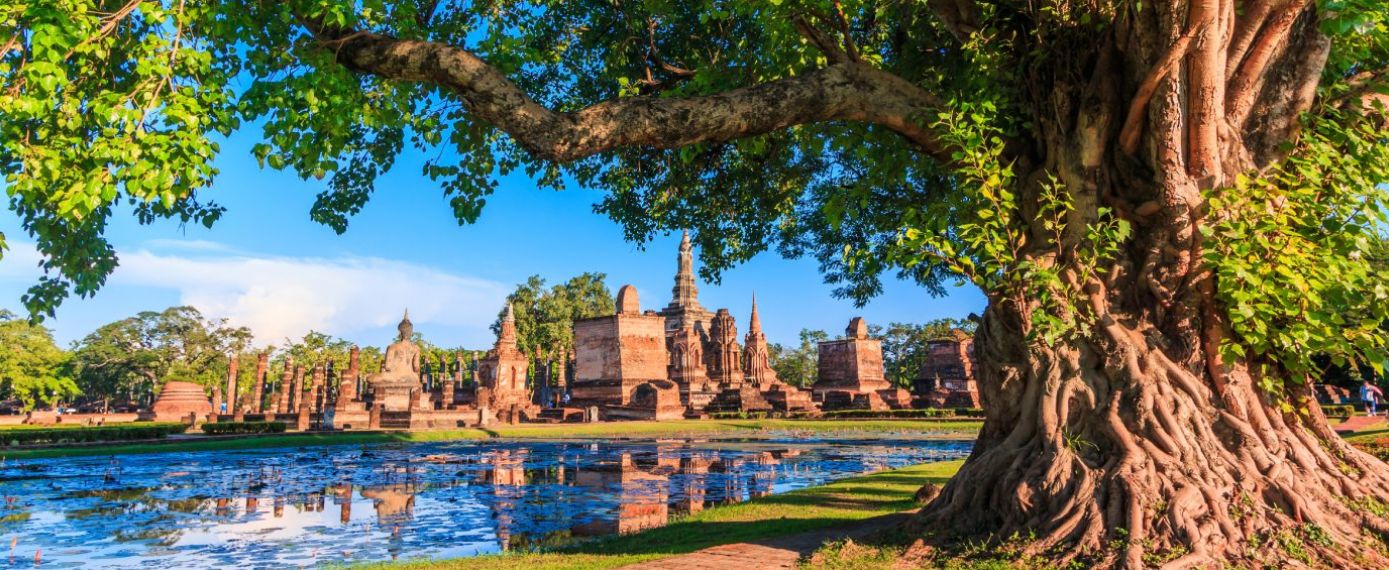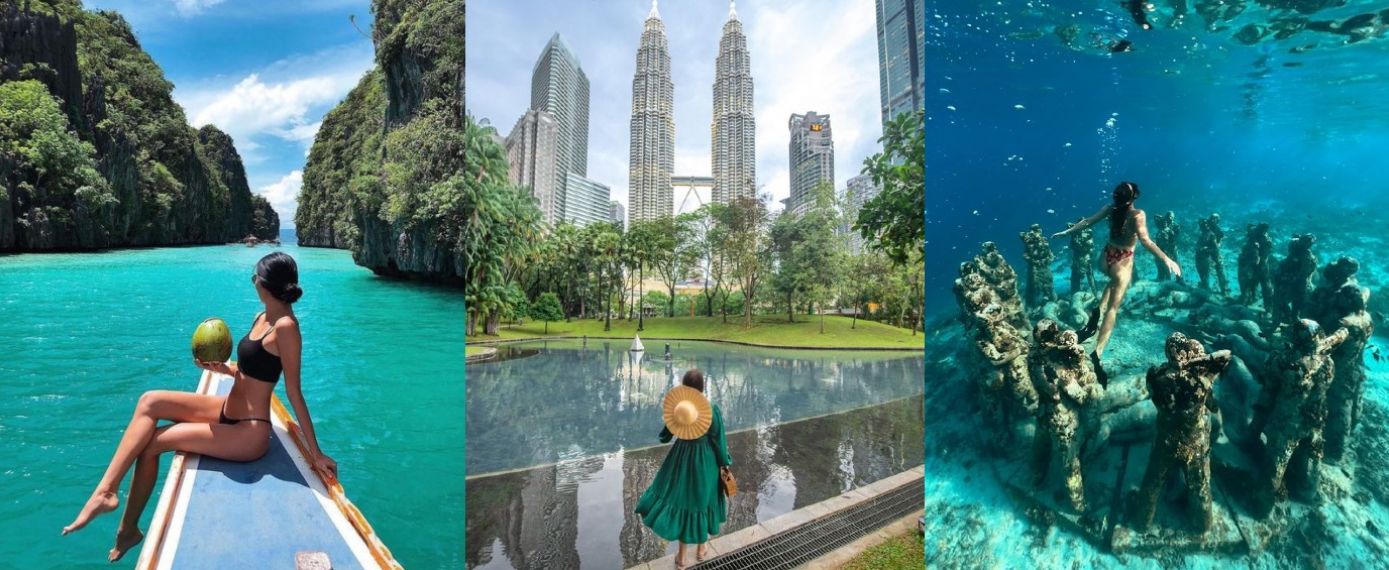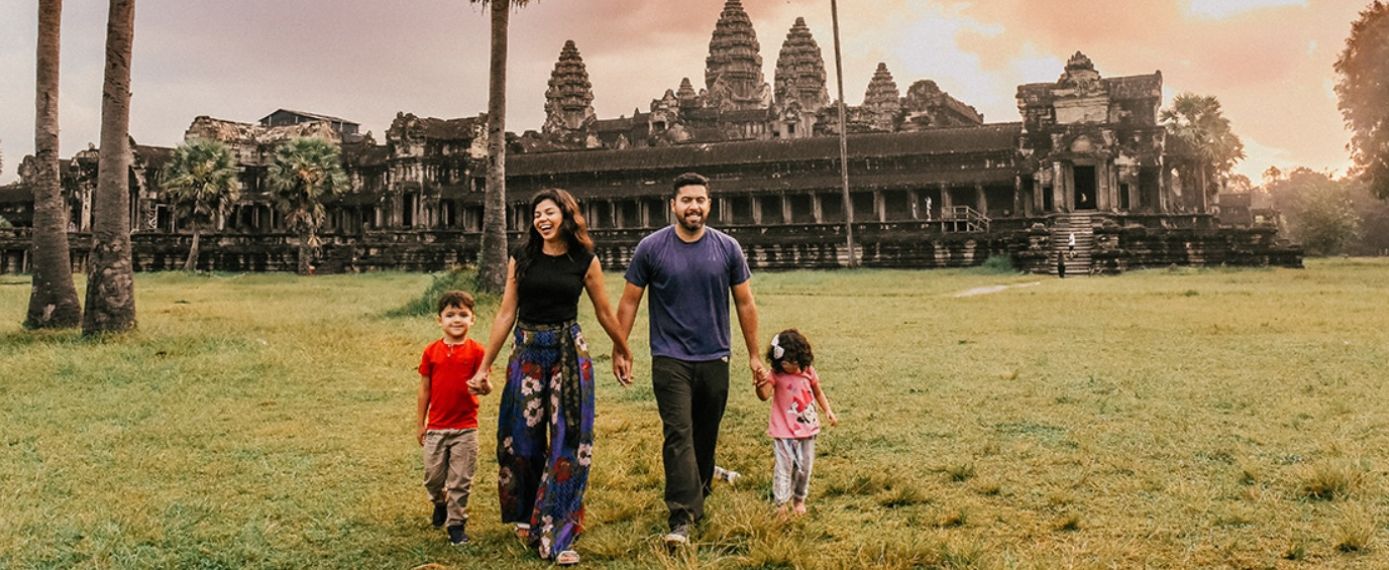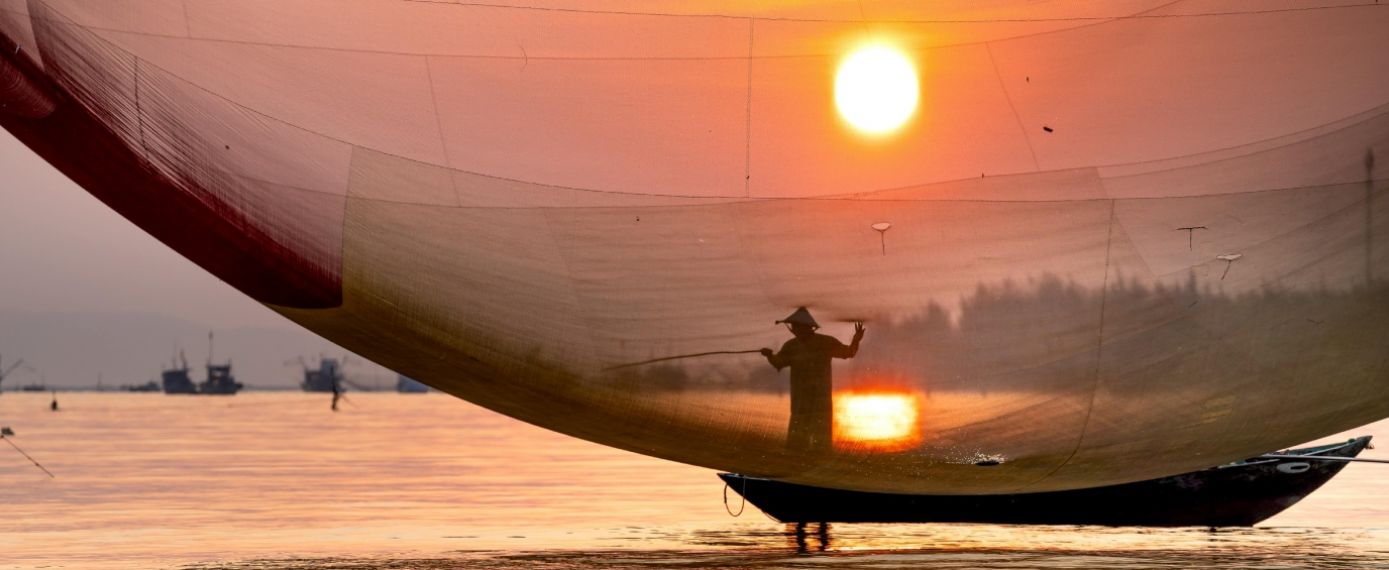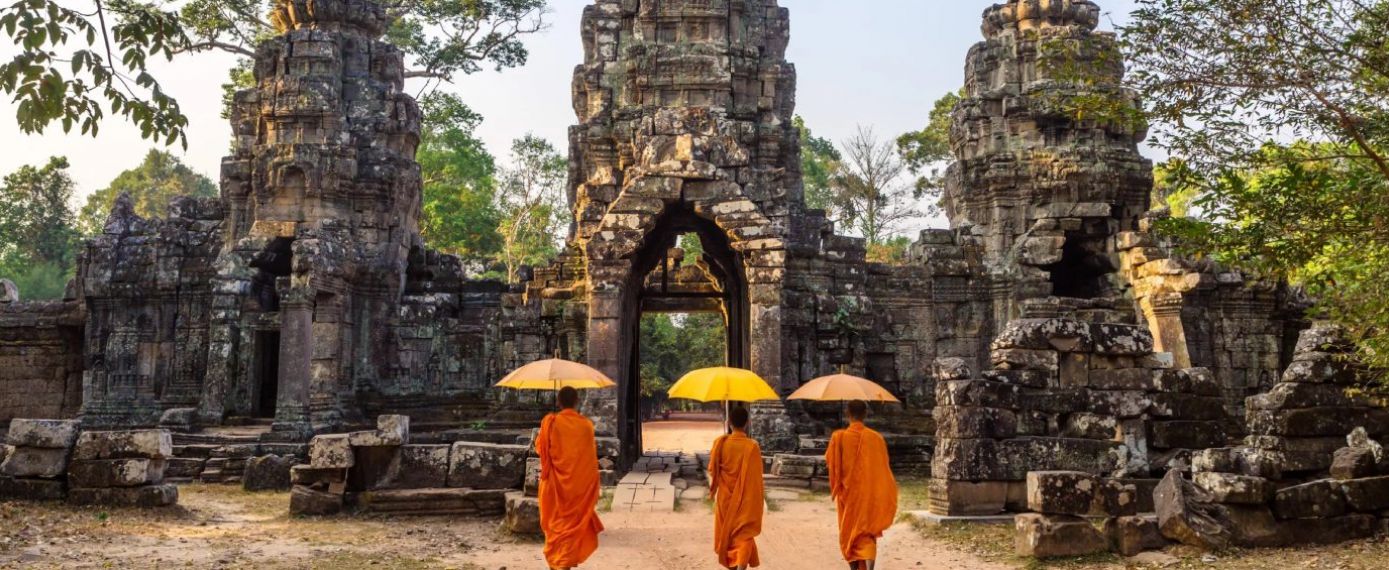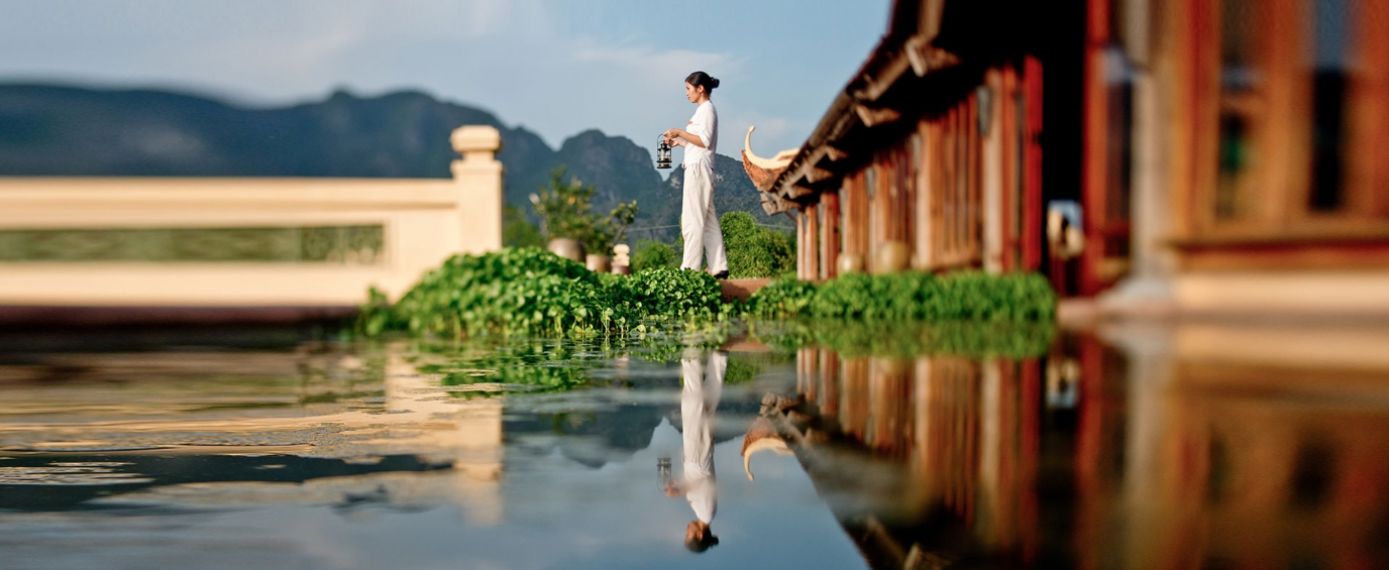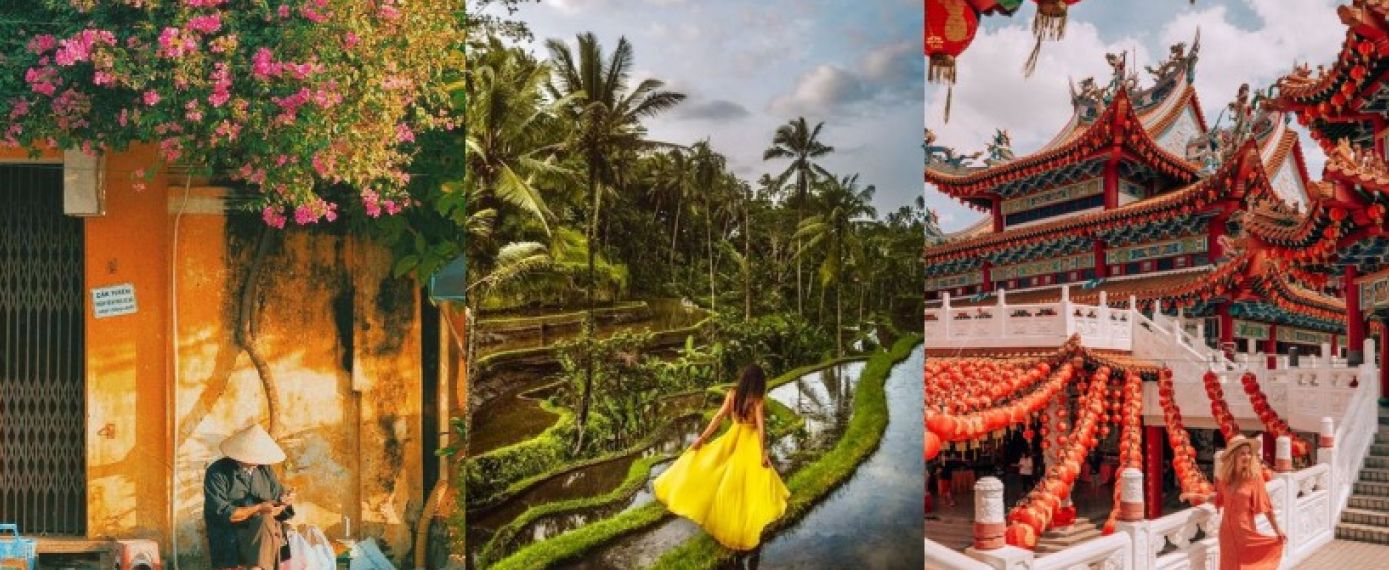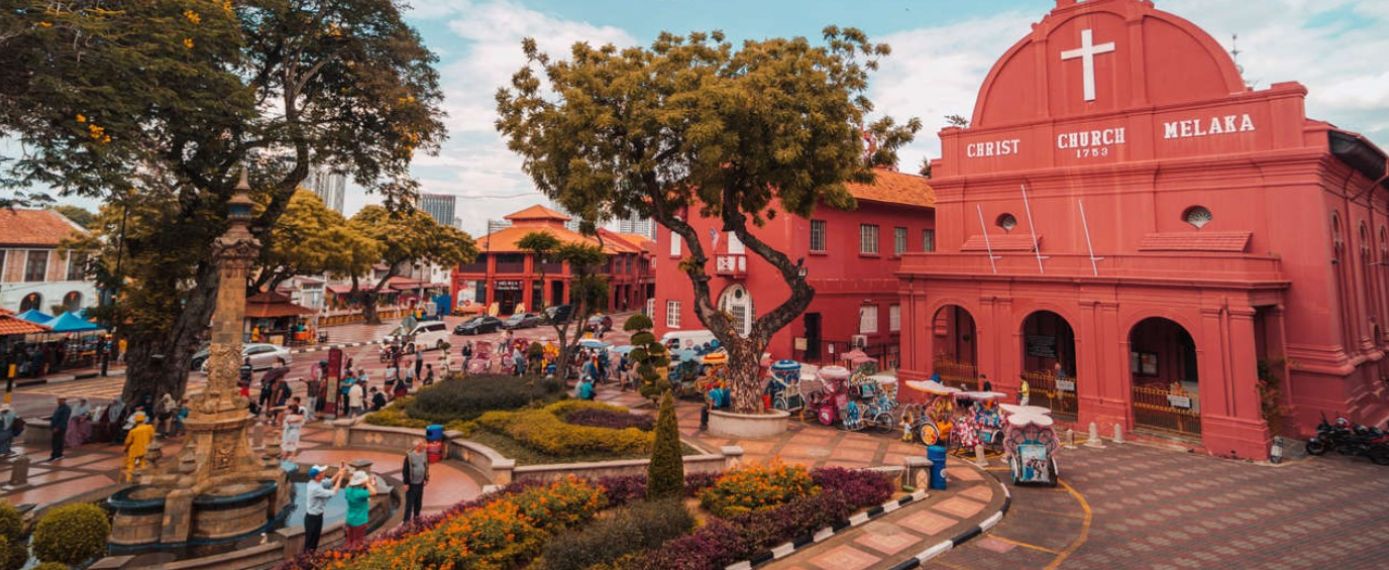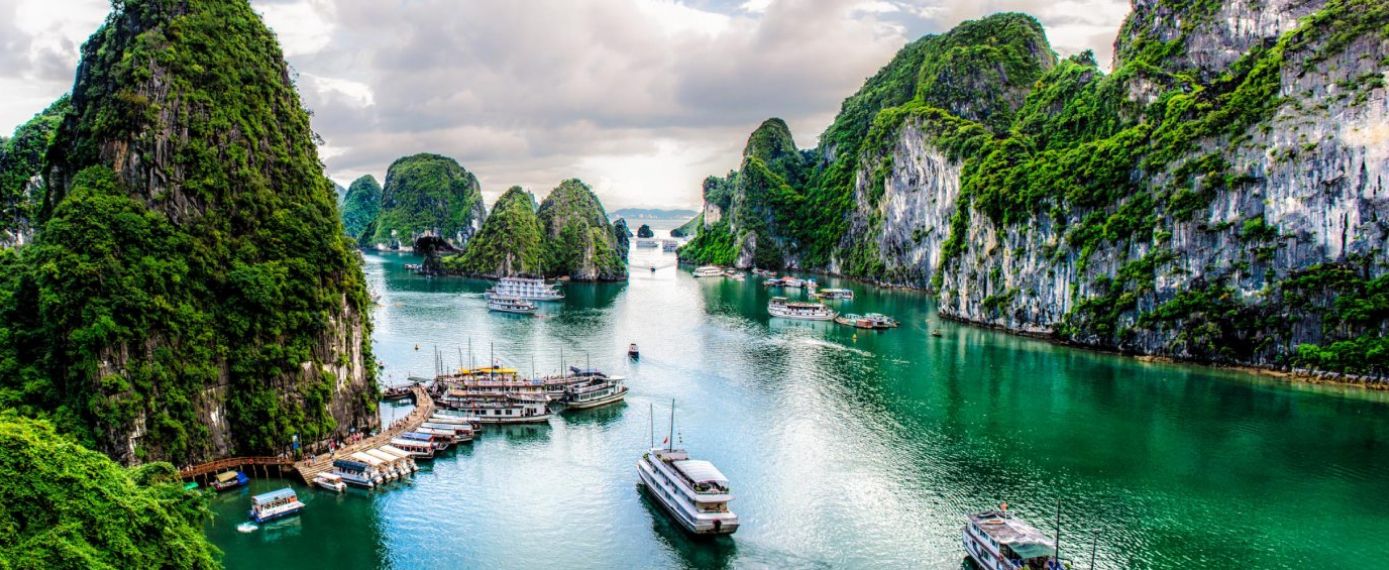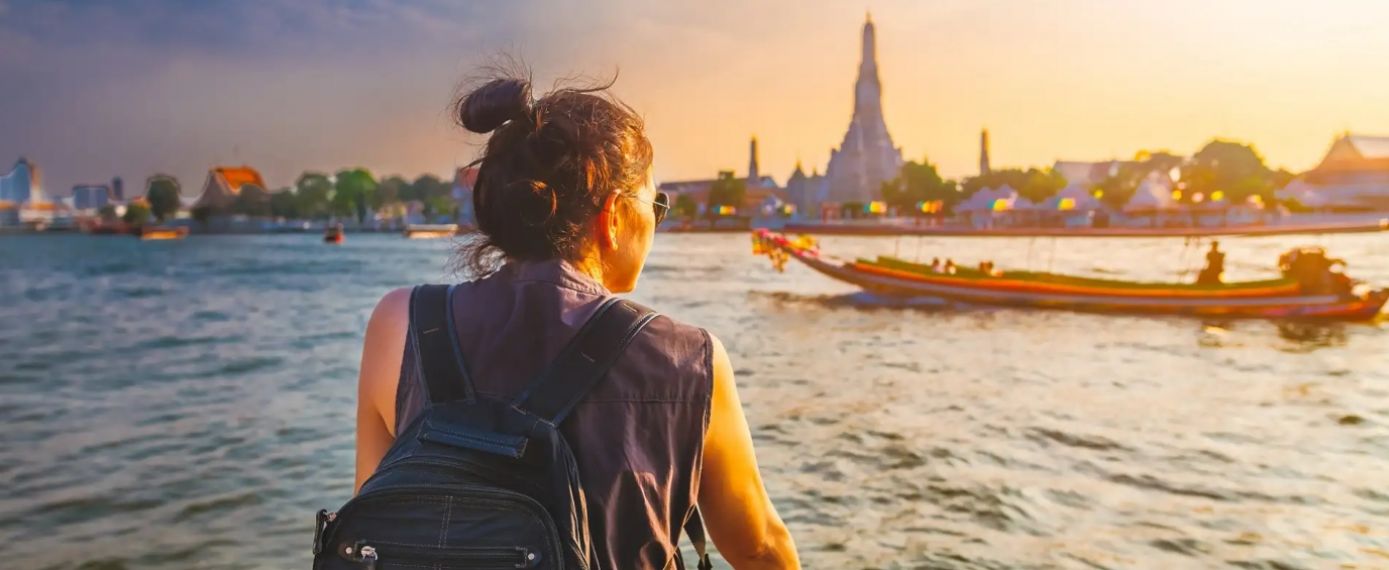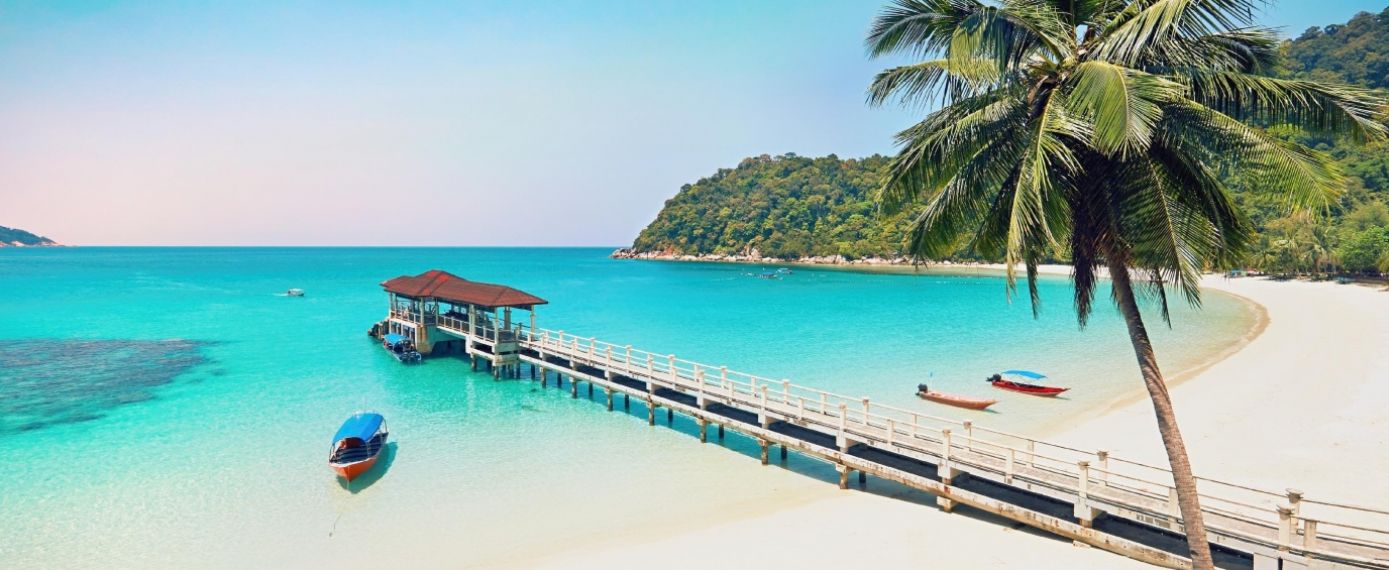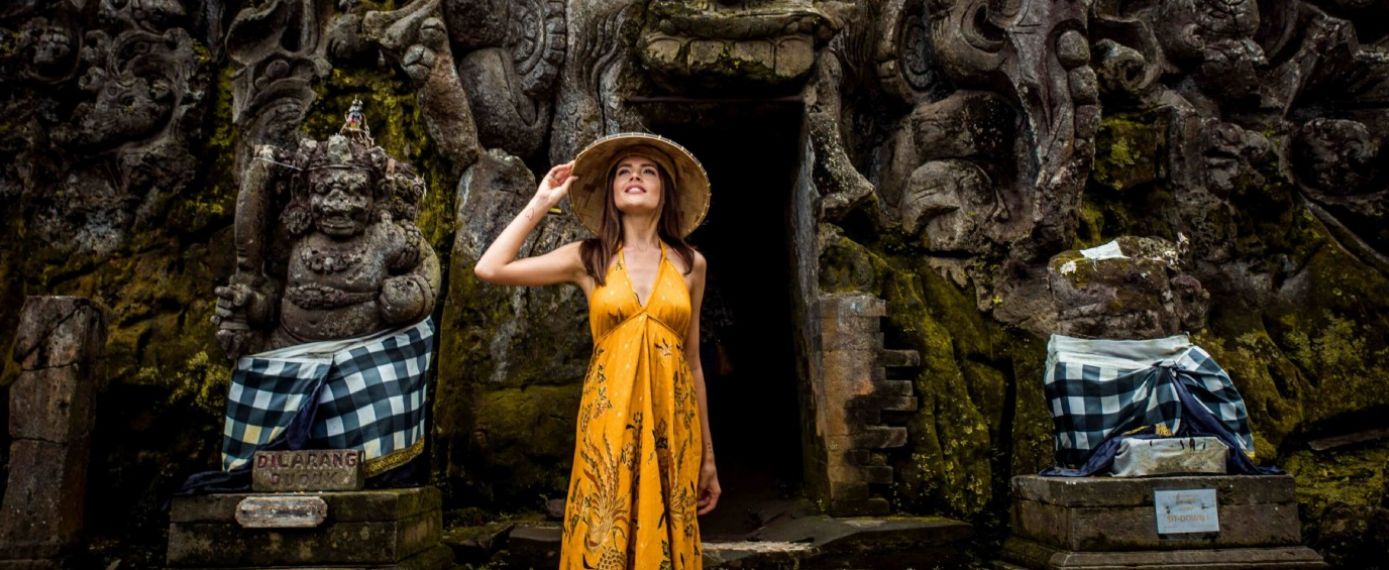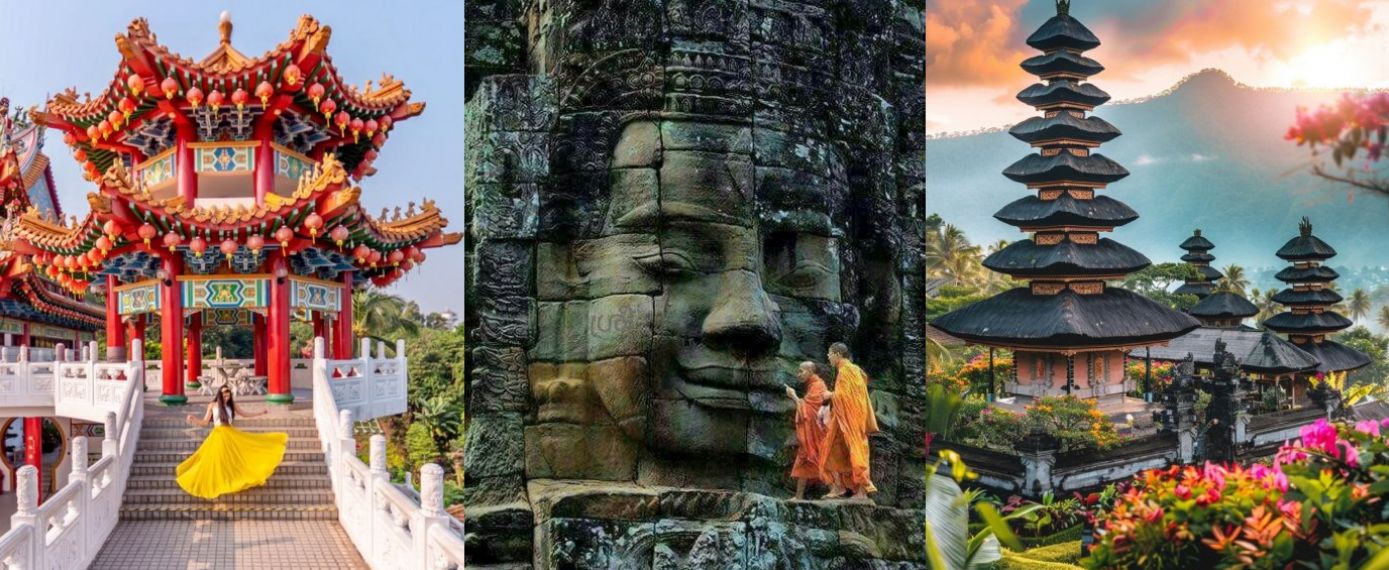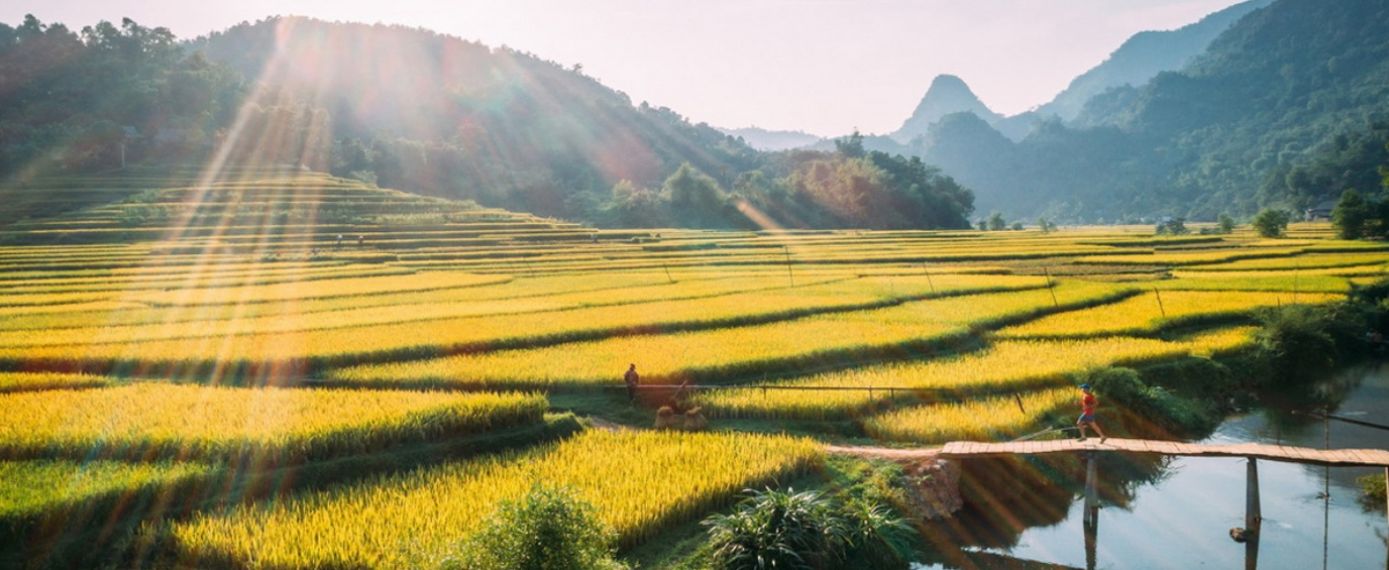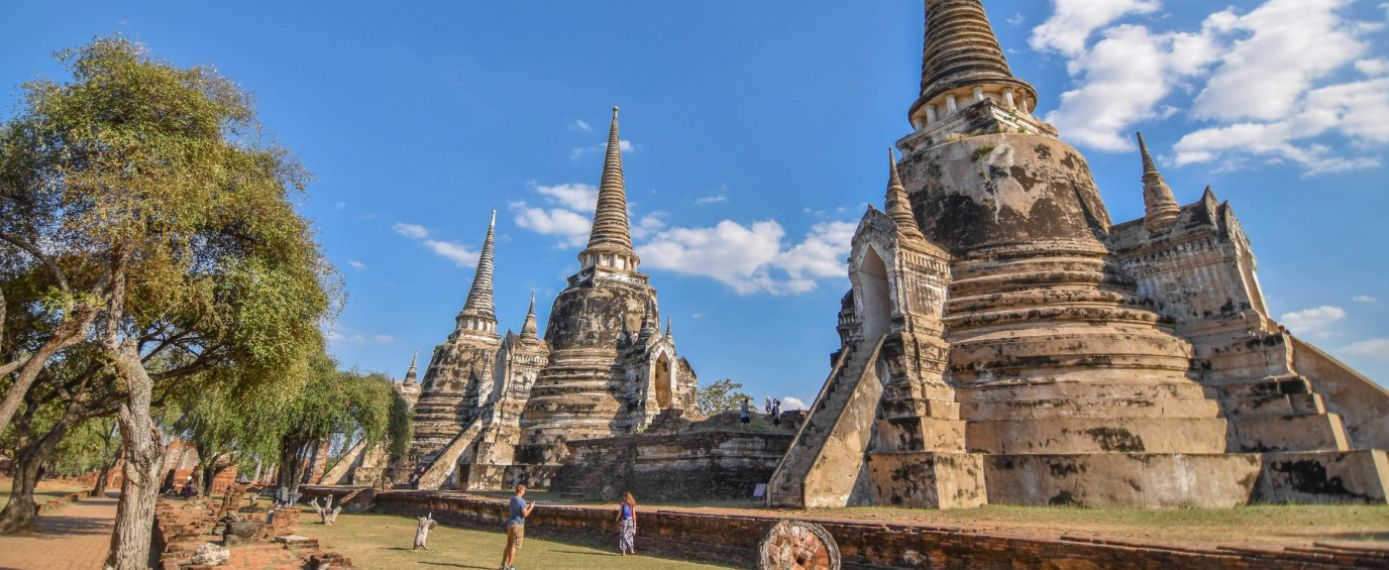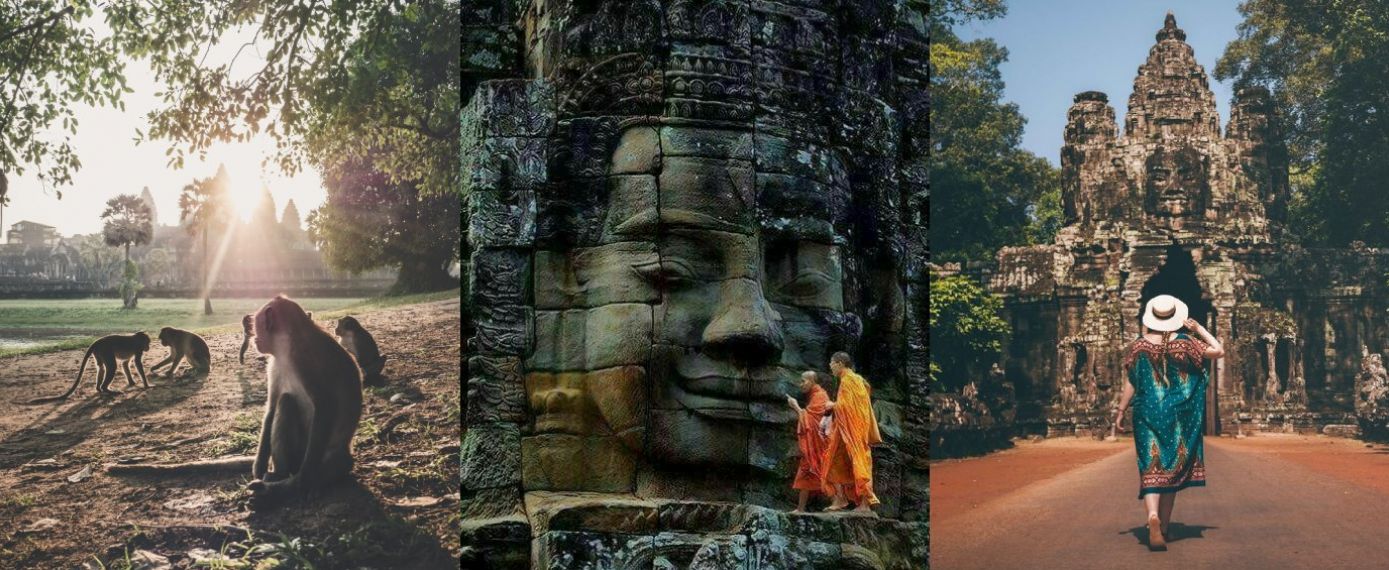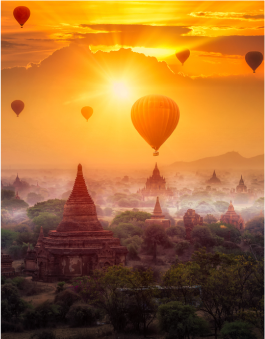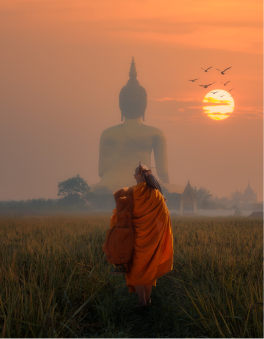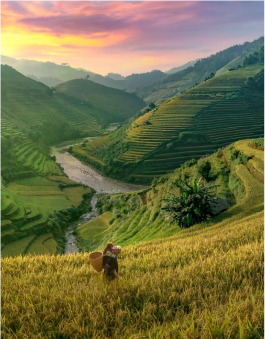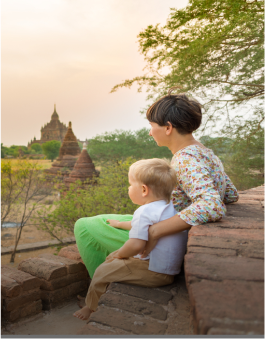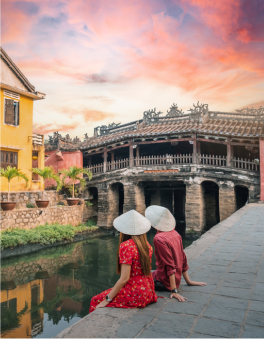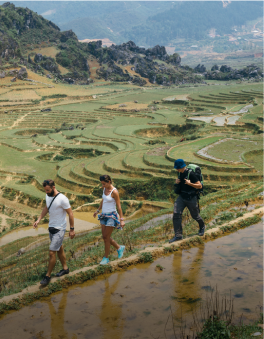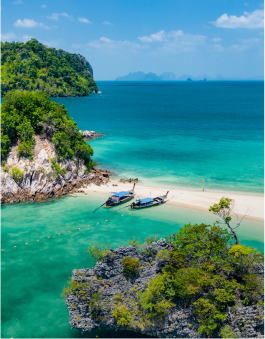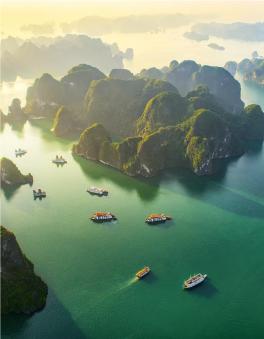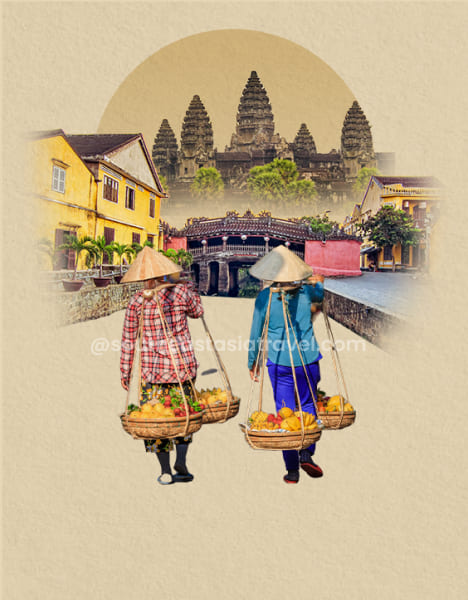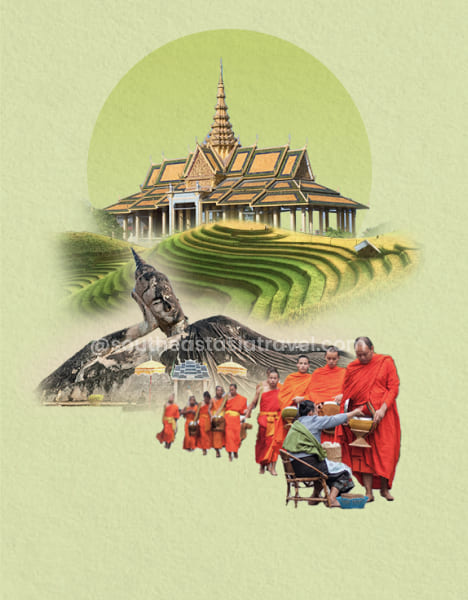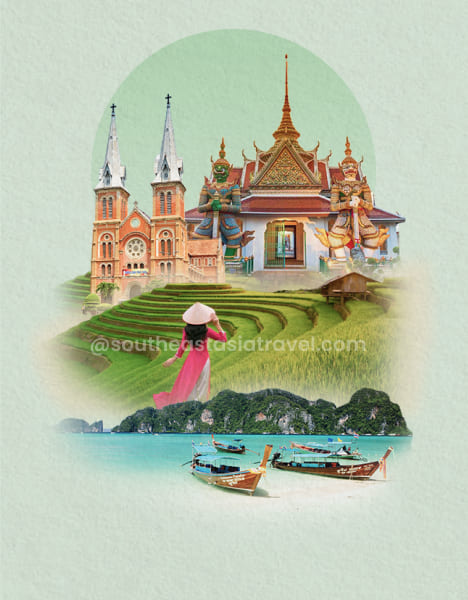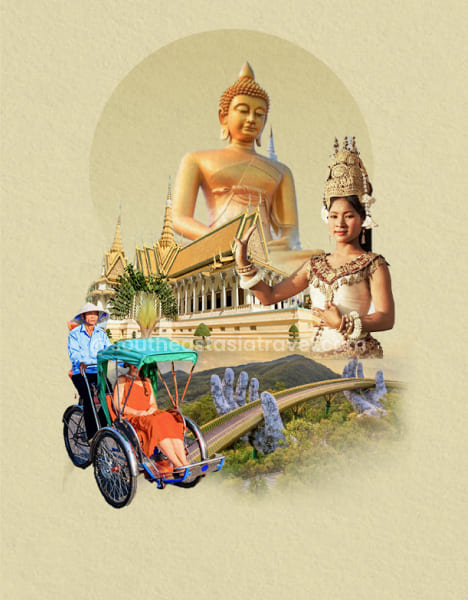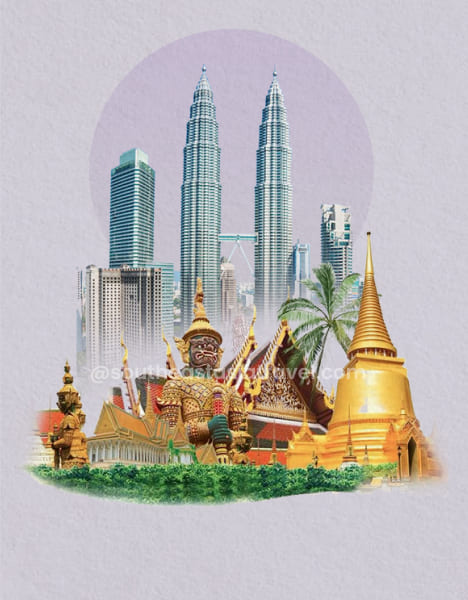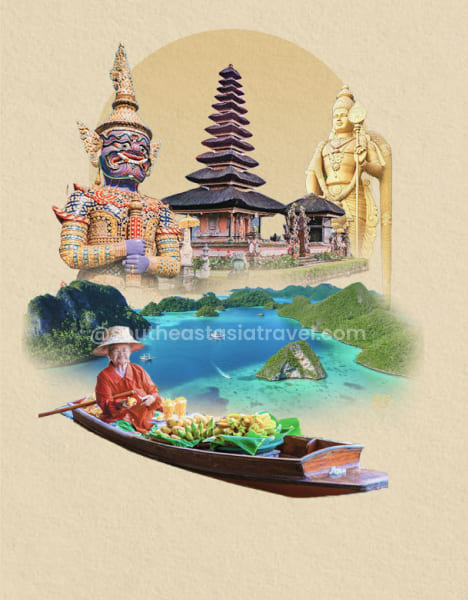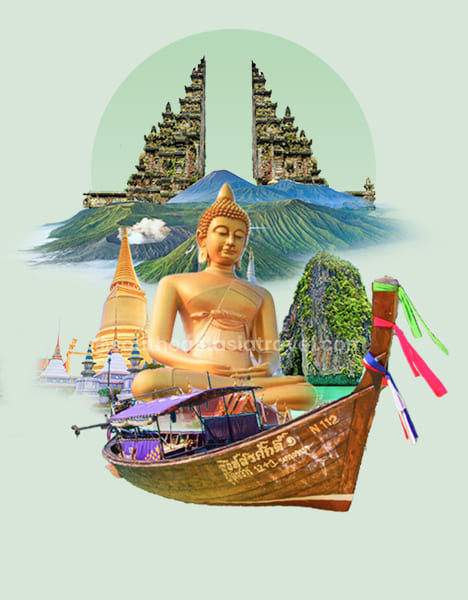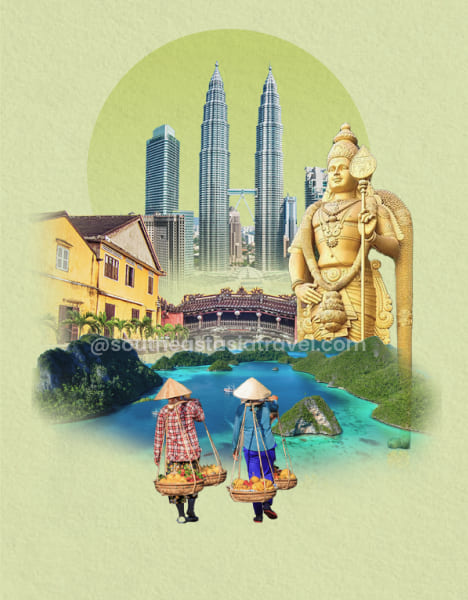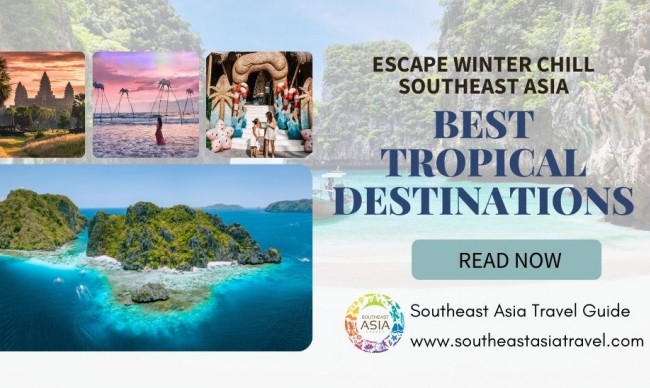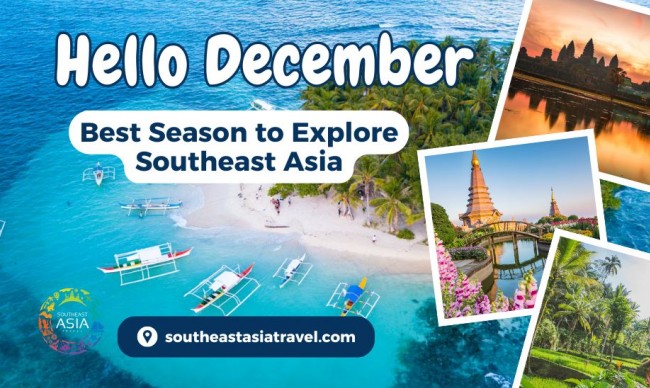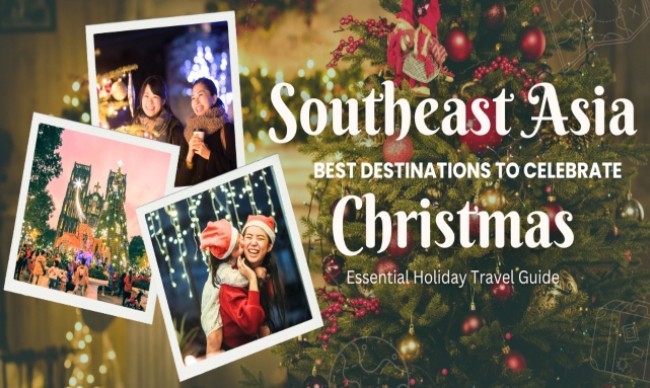
Best Tailor-Made Private Southeast Asia Tours

100% Bespoke Private Tours
As local Southeast Asia travel experts with 15 years' experience, we create your own personalized Southeast Asia Tour, tailored to your specific interests, tastes and your wish list. Just tell us what you want and we will look after every detail and arrange all the services to make sure your holiday will be stress-free.

Flexible, Private Guide & Driver
Flexibility is a top priority of all the tailor made Southeast Asia tours. With private guides, vehicles and drivers, it is so easy for you to experience the real local life at your own pace. The schedule start and end times each day will be adjusted according to your wishes.

Handpicked Accommodation
We select different types of accommodation in great Southeast Asia locations, with outstanding services to help you get the most out of your visit. From modern to local boutique hotels, the choice is completely up to you - just let us know what you are looking for, and we will find suitable options.

24/7 Professional Support Team
Your tailor-made journey will be taken care of by a local team; not just your private guides and drivers, but also your own travel specialist and operators in each region. This round-the-clock support helps give you the best Southeast Asia holiday experiences.
Best Southeast Asia Tour Operator & Travel Company
Southeast Asia Travel is an award-winning travel company specializing in bespoke, private and luxury tour packages across Vietnam, Laos, Cambodia, Thailand, Singapore, Malaysia, Indonesia, Myanmar, the Philippines and beyond. With over 15 years of industry expertise, we have guided more than 30,000 travelers on unforgettable journeys through the heart of Southeast Asia. Every Southeast Asia Tour we create is fully customized to reflect your interests, whether you seek hidden gems, iconic landmarks or personalized experiences. With our tailored approach and commitment to excellence, your journey with Southeast Asia Travel will be seamless, enriching and truly unforgettable for a lifetime.
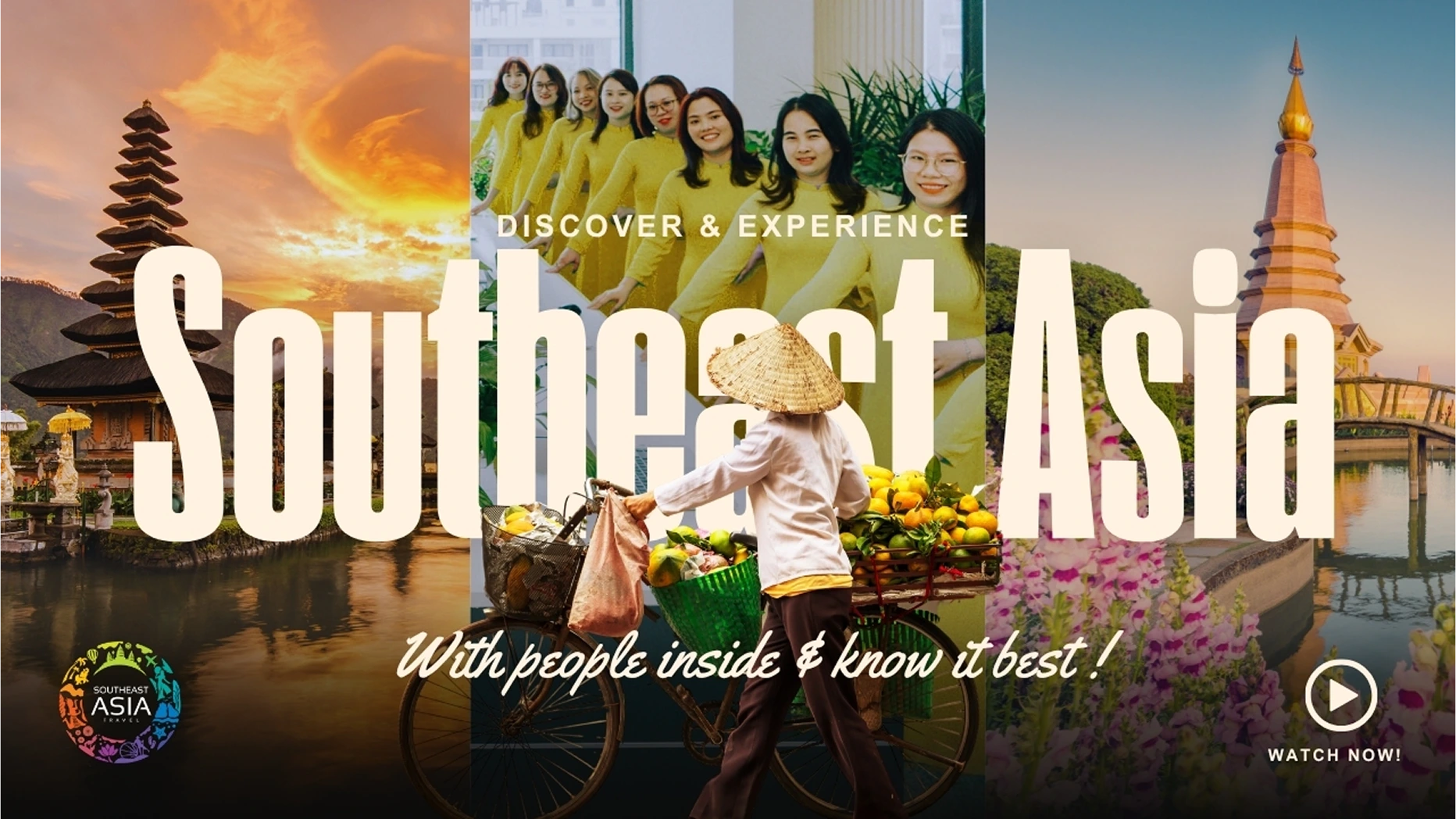

Proud to be recommended by The Telegraph, The Washington Post , The Epoch Times, World Travel Awards... & Official member of ASTA#900385282 , ATTA#852025, FTA#4092797 & International Tour License #01-2750/GPLHQT
Trending Southeast Asia Destinations
Southeast Asia Tours offer stunning destinations with rich culture, vibrant cities, lush landscapes, and diverse cuisine. It’s a paradise for history, adventure, and relaxation.
Best Southeast Asia Tours
Discover our collection of the best and most popular Southeast Asia tours, featuring breathtaking island-hopping, food adventures, jungle trekking, temple explorations, and city escapes.
Trace the cultural heartbeat of the region on our 25-day Landmarks of Southeast Asia journey, traveling through Cambodia, Thailand, Laos, and Vietnam. This heritage-rich itinerary connects you with the ancient kingdoms, sacred temples, historic capitals, and timeless landscapes. From the monumental splendor of Angkor and the royal legacies of Ayutthaya to the spiritual calm of Luang Prabang and the dramatic limestone wonders of Halong Bay and Ninh Binh, each destination offers immersive cultural encounters and authentic local experiences, revealing the enduring traditions, artistry, and living history of Southeast Asia.
Only From $4375/person
All Inclusive ServiceThis Tour
Over 28 unforgettable days, travel through the ancient heritage and untouched natural wonders of Southeast Asia. Begin amidst Singapore’s fusion of modern innovation and multicultural heritage before uncovering the spiritual and historical treasures of Cambodia, from sacred temple ruins to meaningful elephant encounters in Siem Reap. Continue north to Thailand, where the cool mountain air of Doi Inthanon National Park and vibrant markets awaken your sense of adventure. In Malaysia, explore the melting pot of cultures, spices, and colonial charm, then cross over to the Philippines for pure paradise, from the surreal Chocolate Hills of Bohol to the turquoise lagoons of El Nido’s hidden islands, where each day feels like a postcard come to life.
Only From $7705/person
All Inclusive ServiceThis Tour
This 30-day itinerary is well designed for those seeking not just a tour but a shared experience, where golden beaches, tranquil waters, and vibrant cultures set the stage for meaningful time with loved ones. Traveling through Malaysia, Vietnam, and Thailand, you'll uncover a string of coastal gems and cultural treasures, from the heritage-rich streets of Penang to the island beauty of Phuket. Enjoy romantic cruises on Halong Bay’s emerald waters, unwind in the ancient town of Hoi An, and savor quiet moments in the serene tropics of Kota Kinabalu. Southeast Asia invites you to slow down, reconnect, and create unforgettable memories in some enchanting coastal corners.
Only From $5730/person
All Inclusive ServiceThis Tour
Best Southeast Asia Tours by Country
Explore our suggestions for the best Southeast Asia tours by country, whether you are planning to visit a specific country or create a multi-country itinerary to connect various destinations. Click each Southeast Asia Tour country tab to view more tour ideas
This is a journey for those who seek authentic encounters, breathtaking scenery, and a deeper connection to the heart of Southeast Asia. Traveling through Vietnam, Cambodia, Thailand, and Malaysia over 26 unforgettable days, you'll experience everything from the bustling cities of Hanoi and Bangkok to the peaceful landscapes of the Mekong Delta and Halong Bay. While iconic landmarks and historic sites are highlights throughout, the journey places special emphasis on nature and wildlife - particularly in Chiang Mai, where you'll connect with elephants in ethical sanctuaries, and in Kota Kinabalu, where rainforest trails and river safaris bring you face-to-face with Borneo’s unique ecosystems.
Only From $4940/person
All Inclusive ServiceThis Tour
Set off on a 20-day cross-cultural expedition that weaves through the rich cultural landscapes, diverse traditions, and natural wonders of Indonesia, Malaysia, and Thailand. Venture deep into the heart of Sumatra, where orangutans roam free in Gunung Leuser National Park, misty volcanoes rise over Berastagi, and ancient Batak heritage thrives on the shores of Lake Toba. Cross into the historic melting pot of Penang, then on to the modern energy of Kuala Lumpur. As the journey unfolds, follow the cultural thread north to the timeless allure of Bangkok, where tradition and innovation live side by side.
Only From $5800/person
All Inclusive ServiceThis Tour
Uncover the rich tapestry of Southeast Asia on this 17-day journey through Cambodia, Thailand, and Malaysia. Explore the poignant history of Phnom Penh, stand in awe before the ancient wonders of Angkor in Siem Reap, and dive into the vibrant energy of Bangkok. Then head south to Malaysia’s dynamic capital, Kuala Lumpur, before relaxing in the coastal charm and natural beauty of Kota Kinabalu. This carefully crafted adventure covers both cultural discovery with tropical relaxation - an unforgettable escape through the heart and soul of the region.
Only From $3230/person
All Inclusive ServiceThis Tour
42 days of our journey through Southeast Asia’s living heritage tour unveil the timeless charm and cultural richness of Indonesia, Malaysia, Singapore, and Cambodia. From the artistic heritage of Yogyakarta to the remote beauty of Balikpapan, Indonesia reveals a world where history and spirituality intertwine. Continue through Malaysia’s vibrant cities and colonial gems like Kuala Lumpur, Melaka, and Kota Kinabalu before experiencing the cosmopolitan elegance of Singapore. Conclude your journey in Cambodia, where the ancient grandeur of Siem Reap, the community warmth of Banteay Chhmar, and the wilderness of Botum Sakor National Park bring the region’s living heritage to life. We meticulously design this extraordinary itinerary to provide enriching local encounters, exquisite cuisine, hand-picked accommodations, and the insights of expert local guides.
Only From $10802/person
All Inclusive ServiceThis Tour
Starting in Bangkok and ending in Phnom Penh, this 26-day tour takes you on an incredible adventure through Thailand, Malaysia, and Cambodia, with cultural discovery, natural beauty, and local connection. Wander through the sacred temples of Chiang Mai, explore the vibrant streets of Kuala Lumpur, stand in awe before the majestic Angkor Wat, and experience life in the rural Banteay Chhmar community. Cruise through the wilderness of Botum Sakor National Park, uncover hidden gems in Battambang, and finally, unwind on the serene beaches of Koh Rong Sanloem. From ancient history to tropical paradise, this journey invites you to slow down, dive deep, and connect with the timeless spirit of Southeast Asia.
Only From $5148/person
All Inclusive ServiceThis Tour
Interested in the rich heritage and beautiful islands of Southeast Asia? Set off on a 38-day cultural and coastal odyssey through Thailand, Malaysia, Singapore, and the Philippines, an adventure that blends iconic cities, historic heartlands, and pristine tropical escapes. You will experience the vibrant streets of Bangkok, the ancient wonders of Sukhothai, the flavorful charm of Penang, and the natural splendor of Kota Kinabalu before heading to sleek, modern Singapore. Fly into the Philippines, where your final chapter unfolds across El Nido’s dramatic limestone cliffs, Bohol’s serene landscapes, and Cebu’s coastal energy.
Only From $9265/person
All Inclusive ServiceThis Tour
This travel package is a fun-filled adventure across Malaysia, Indonesia, and Thailand that allows you to discover the three countries' hidden gems and significant attractions, as well as their dynamic culture. From the buzzing Kuala Lumpur to the majestic Ijen Volcano, from the culturally rich Ubud to the historical Kanchanaburi, all of these sites have exciting adventures and vacations to offer, so this trip lets you to have a great time at all of them. Malaysia's towers and highlands, Indonesia's stunning islands, and Thailand's outstanding culture all provide an enjoyable sojourn and the opportunity to make lasting moments with your loved ones.
Only From $4176/person
All Inclusive ServiceThis Tour
Ready for a family journey filled with wonder and discovery? This 26-day adventure through Southeast Asia covers ancient marvels with tropical escapes. Begin in Siem Reap, where temple ruins spark young imaginations, then unwind on the sandy shores of Koh Rong Sanloem. Explore the rich history of Phnom Penh, then dive into the vibrant energy of Bangkok and the cultural charm of Chiang Mai. In Kuala Lumpur, city lights meet family fun, while Kota Kinabalu and the cool highlands of Ranau offer rainforest trails and mountain magic. From temples to tropics, you’ll get shared stories, wide-eyed discoveries, and treasured memories made together.
Only From $5070/person
All Inclusive ServiceThis Tour




Southeast Asia Tours 26 - 30 Days
Explore the vibrant cultures, stunning landscapes, and rich histories of Southeast Asia on an unforgettable 26-30 day tour. This immersive journey covers multiple countries, offering a perfect blend of adventure, relaxation, and cultural discovery...
Welcome to Southeast Asia, the land of wonders and surprises! Let’s start your discovery of this wonderful region with our 4-week-long tour package. Start in the vibrant city of Kuala Lumpur; you’ll then indulge in the verdant greenery of the Cameron Highlands, witness an awe-inspiring sunrise over Mount Bromo, explore the ancient Thai capital in Ayutthaya, leisurely cruise the calm waters of Halong Bay, and yes, bask in the sun on the sandy beaches of Bali Island. Whatever you yearn for, this Southeast Asia trip will definitely be beyond your imagination.
Only From $5740/person
All Inclusive ServiceThis Tour
Embark on the journey of a lifetime through the vibrant cultures, breathtaking landscapes, and timeless traditions of Southeast Asia. Over 30 unforgettable days, you'll explore five of the region’s most captivating countries, Thailand, Vietnam, Cambodia, Malaysia, and Singapore, each offering its own unique charm and unforgettable experiences. Wander through the bustling streets of Bangkok, uncover ancient wonders in Siem Reap, and immerse yourself in the serenity of Halong Bay. From the cool highlands of Cameron to the historic streets of Penang, and from the sleek skyline of Singapore to the cultural fusion of Kuala Lumpur, every stop promises thrills, discovery, and moments that will last forever. Join us, and let every day bring a new story.
Only From $6750/person
All Inclusive ServiceThis Tour
Explore the calm allure of Siem Reap and behold the magnificent Angkor Wat in Cambodia. Venture into Malaysia's rich cultural diversity, from picturesque Penang to the vibrant Kuala Lumpur. Witness the awe-inspiring natural wonders of Indonesia, from the unique volcanic experiences in Bromo and Ijen to the fascinating island of Bali with gorgeous beaches and charming heritage. Conclude your amazing journey in Vietnam, with its authentic vibes of the Mekong Delta, bustling streets of Hanoi, and breathtaking scenery of Halong Bay. This 30-day comprehensive itinerary offers a perfect blend of relaxation, local discovery, and cultural immersion.
Only From $6150/person
All Inclusive ServiceThis Tour
Southeast Asia Tours 18 - 26 Days
Discover the heart of Southeast Asia on an 18-26 day tour filled with iconic sights, local flavors, and cultural treasures. Ideal for travelers seeking a rich, multi-country experience with a perfect balance of exploration and leisure.
See the best of the best Southeast Asia in this adventuring 19-day tour. Go through many sites of interest such as historic museums in Hanoi, the world-famous Angkor Wat complex, the vibrant Chao Phraya River, etc. Fall in love with this land while discovering deep down into the culture and natural beauty along the way you passing through. Get impressive views and feel the authentic peaceful rural life. Take the chance to meet local people and admire their hardworking characteristics and hospitability. Travel across many exciting and glorious lands to have a full diverse look and experience that you will never forget.
Only From $3040/person
All Inclusive ServiceThis Tour
18 Days of pure discovery! This spectacular journey will take you through Southeast Asia’s most iconic gems. Sail through the stunning waters of Halong Bay, wander the lantern-lit streets of Hoi An, dive into the energy of Hanoi and Ho Chi Minh City, and cruise the lush Mekong Delta. Then, jet off to dazzling Kuala Lumpur before soaking up the beauty of Bali, from the cultural heart of Ubud to the volcanic landscapes of Kintamani and the breezy beaches of Sanur. Culture, cuisine, nature, and adventure - all in one unforgettable trip!
Only From $2880/person
All Inclusive ServiceThis Tour
Begin your adventure in Vietnam with vibrant city tours in Hanoi and Ho Chi Minh City, peaceful countryside cycling in Hoi An, and an inspiring overnight cruise in Halong Bay. Discover Thailand's cultural hotspots, from bustling Bangkok to the heritage treasures of Ayutthaya and Kanchanaburi. Then travel to Singapore to see its modern cityscape and architectural landmarks on a signature Duck tour. This carefully designed 22-day itinerary provides the ideal balance of cultural immersion, urban exploration, and natural grandeur for visitors looking for a condensed yet thorough experience of Southeast Asia's endless charms. The following schedule is for your inspiration. All can be tailor-made!
Only From $5588/person
All Inclusive ServiceThis Tour
Southeast Asia Tours 12 - 18 Days
Experience the highlights of Southeast Asia in 12-18 days, perfect for travelers wanting a deep yet time-efficient adventure. Journey through diverse landscapes, vibrant cities, and ancient traditions across multiple countries.
Embark on a fantastic 15-day journey through Vietnam and Cambodia, exploring the region’s most captivating destinations. Start in Hanoi, Vietnam’s vibrant capital, where you will weave through the historic Old Quarter on a cyclo before embarking on a breathtaking cruise through iconic Halong Bay. Next, head to Central Vietnam, where you will cycle through picturesque rural villages and enjoy fun moments in the enchanting water coconut forest. Then experience the vibrant energy of Ho Chi Minh City, spending two nights soaking up the city's modern charm after a scenic day trip to the floating markets of the Mekong Delta. Beyond Vietnam, your adventure will extend to Cambodia’s must-see treasures, Siem Reap and Sihanoukville. Admire the awe-inspiring Angkor Wat, a UNESCO-listed wonder, and relax on Sihanoukville's pristine beaches, where the clear waters invite relaxation and serenity.
Only From $2220/person
All Inclusive ServiceThis Tour
Thailand and Malaysia make the perfect travel duo—vibrant, diverse, and full of surprises! Over 18 incredible days, you’ll wander through the cultural gems of Chiang Mai and Chiang Rai, dive into the energy of Bangkok, soak up the charm of Penang and Ipoh, breathe in the cool air of the Cameron Highlands, and end with a stylish city escape in Kuala Lumpur. From golden temples and buzzing street markets to lush tea plantations and mouthwatering cuisine, this journey has the ideal combination of culture, nature, and fun. Let’s go!
Only From $3240/person
All Inclusive ServiceThis Tour
Malaysia, a diverse country renowned for its wonderful architectural wonders, abundant cultural landmarks and historical sites, is the starting point of this 17-day journey. The adventure will bring you to Penang, a melting pot of religion and cultures, passing through the vibrant city of Langkawi and the modern cityscape of Kuala Lumpur. Then travel to Vietnam, where you’ll soak in the bustling hub of Hanoi, witness the breathtaking natural scenery of Halong Bay, and experience a more traditional way of life in the Mekong Delta. Join us and enjoy a sojourn of amazing travel destinations in Malaysia and Vietnam.
Only From $2644/person
All Inclusive ServiceThis Tour
Southeast Asia Tours 8 - 12 Days
Embark on a captivating 8-12 day tour of Southeast Asia, ideal for a quick yet enriching getaway. Explore iconic landmarks, vibrant cultures, and stunning natural beauty in a compact itinerary.
Get ready for a mesmerizing journey through two of Southeast Asia’s most captivating destinations, Thailand and Indonesia! This 10-day adventure starts in the vibrant city of Bangkok, where you’ll explore iconic temples and bustling local markets, then step back in time with a visit to the historic ruins of Ayutthaya. Next, fly to Bali and discover the cultural charm of Ubud and the stunning views of Kintamani before unwinding on the peaceful beaches of Sanur. A perfect mix of culture, nature, and relaxation!
Only From $1850/person
All Inclusive ServiceThis Tour
This hassle-free travel itinerary, with the most classic attractions in Cambodia, Malaysia, and Indonesia, is a perfect choice for those seeking the charms of these three Southeast Asia countries. You will witness the breathtaking Angkor Wat in Cambodia and immerse yourself in the tranquility of Siem Reap. Then fly to Kuala Lumpur to discover cultural diversity and modern architectural wonders. Conclude your amazing journey in Bali Island, with its gorgeous natural marvels and colorful culture. This thorough itinerary provides an ideal balance of history, culture, and natural beauty.
Only From $1920/person
All Inclusive ServiceThis Tour
Begin a colorful 12-day tour across two intriguing Southeast Asian countries, beginning in Bangkok, the buzzing capital city of Thailand. Explore its renowned landmarks, including the Grand Palace and Wat Arun, and experience the unique floating market of Damnoen Saduak. Next, fly to Chiang Rai, best known for the iconic Golden Triangle and unique-designed temples. Then, head to Chiang Mai, the cultural hub of northern Thailand with ancient temples, herds of elephants, and spectacular natural scenery. Finally, wrap off your trip in Singapore, a vibrant city-state noted for its modern skyline and cosmopolitan past. Visit Merlion Park, explore bustling Chiantown, and relax in the lovely Gardens by the Bay.
Only From $2580/person
All Inclusive ServiceThis Tour
Southeast Asia Tours < 8 Days
Enjoy a taste of Southeast Asia in under 8 days with a short but unforgettable journey through its vibrant cities and cultural gems. Perfect for a quick escape, this tour offers rich experiences in a limited timeframe.
See the best of Vietnam’s northern mountains with this 5-day tour package including breathtaking destinations like Hanoi, Ninh Binh, Pu Luong, and Mai Chau. Journey from the modern capital Hanoi to the rice paddies and limestone karsts of "Halong on Land" in Ninh Binh before heading to the untouched highlands of Pu Luong and Mai Chau, where you may witness the distinctive customs of minority tribes in mountainous areas. This one-of-a-kind exploration also consists of many active experiences, including walking, cycling, trekking, boating.
Only From $760/person
All Inclusive ServiceThis Tour
Let’s embark on a wonderful five-day tour around central Thailand, a place rich in history, culture, and magnificent landscapes. From the busy streets of Bangkok to the peaceful ambience of Ayutthaya and the vibrant trading scene of a Thai floating market, this itinerary is designed to help you see the best of Thailand in a limited time. Whether you're a first-time or regular visitor, get ready to enjoy a memorable experience in the Land of Smiles!
Only From $840/person
All Inclusive ServiceThis Tour
During this 5-day tour, visitors will have a chance to set foot in amazingly beautiful temples in Angkor area including Angkor Wat, Angkor Thom, Ta Prohm, etc. Moreover, tourists will be able to explore one of the greatest human's civilizations, Khmer's civilization. Khmer Empire with long last history, great power, massive and subtle structures will fascinate your curiosity and desire of exploring. Also, you will have a glimpse at floating villages of Tonle Sap Lake for better understanding about the land and the people of Cambodia.
Only From $710/person
All Inclusive ServiceThis Tour
Southeast Asia Travel & Tours
What are Southeast Asia Tours?
Southeast Asia, nestled in the southeastern corner of the Asian continent, is divided into two distinct regions: the mainland and the maritime. The continental area encompasses Vietnam, Laos, Cambodia, Thailand, peninsular Malaysia and Myanmar, while the island region includes Indonesia, East Malaysia, the Philippines, Singapore, Brunei and Timor-Leste. Celebrated for its vibrant cultural mosaic, tropical climate, and deep historical roots, Southeast Asia offers something for every traveler - whether you're drawn to its rich heritage, breathtaking landscapes, thrilling adventures, dynamic lifestyles, or mouthwatering cuisine.
Inspired by the region’s landscapes and nature, Southeast Asia tours are tailor-made travel experiences that immerse you in the rich tapestry of culture, landscapes, and history across the region. Tailored to your personal preferences, each tour highlights the distinct charms that have put these countries on the world map. From the majestic Angkor temples in Cambodia and the ancient ruins of Ayutthaya in Thailand, to Vietnam’s wartime legacy at the Cu Chi Tunnels and the surreal Chocolate Hills of the Philippines - every destination tells a story. Add to that the vibrant city life of Kuala Lumpur in Malaysia, the adventurous pursuits of Bali and Palawan, and the delicious food of Luang Prabang in Laos, and you have an itinerary as diverse as the land itself.
In general, Southeast Asia tours are various in budget and duration, from backpacker tours and group tours to customized private tours and free & easy tours, offering a wide range of choices based on what visitors are looking for.
Southeast Asia Private Tours
Southeast Asia Private Tours are exclusive travel experiences designed for you and your own companions, adapting personalized desires such as your own space, flexibility, customized pace, and interests. This kind of tour is very different from group tours, which one will share the vehicles and costs with other people.
Advantages of Southeast Asia Private Tours:
- Free to choose your own start/end dates, activity pace, and attractions.
- Easy to adjust plans on the fly (within reason).
- Taken care of by a private guide with deep knowledge of the destination.
- Travel in private vehicles (car, van, boat whenever possible) for comfort and efficiency.
- Free to spend more time at a site or skip something.
- Meals, rest stops, and experiences can be tailored to your vibe.
- Higher level of personal service, often more luxurious than group tours.
Disadvantages of Southeast Asia Private Tours:
- The cost is usually higher than joining a group tour. Nevertheless, the bigger your private group is, the lower the price per person is.
- Less social since there will be only you and your companions in your private vehicle.
- Planning can take more back-and-forth before making a decision about what you want to see.
- Private tours sometimes have stricter terms & conditions.
For all the reasons mentioned above, Southeast Asia Private Tours are stress-free, relaxing, and ideal for special occasions like honeymoons, anniversaries, or family trips including children or senior people.
Southeast Asia Group Tours
This type of tour is organized trips for a group of people, often strangers, traveling together on a pre-planned itinerary in Southeast Asia that includes transportation, accommodation, activities, and local tour guides. They can be various in style, size, length, and cost, from luxury journeys to budget-friendly adventures.
Southeast Asia Backpacker Tours
Also called a Southeast Asia backpacking tour, this is a form of travel focusing on a low budget, which is quite popular with young people. The common features of this traveling type are concentrating on experiences over luxury, flexible and adventurous itineraries, using public transportation, minibuses, or even hitchhiking (in some cases), accommodating in hostels, camping sites, and homestays, including a lot of outdoor activities like trekking, hiking, snorkeling, swimming...
Southeast Asia Free & Easy Tours
Free and easy tours in Southeast Asia are semi-organized travel experiences that give you a mix of structure and freedom. They typically include the essentials like accommodation, some transport, and maybe a few activities, but leave most of your schedule open for you to explore on your own terms.

From the countless tailor-made tours we have created for our clients over the years, we have carefully researched and selected the best, each with its own unique features, making them truly unforgettable. Here are top travel experiences that create our Best Southeast Asia tours:
Southeast Asia tours include diverse itinerary across cultures & landscapes
Southeast Asia captivates with its unique diversity, becoming the top choice for travelers craving vibrant experiences. The best tours will blend a wide variety of natural landscapes - from the dynamic metropolises of Bangkok and Hanoi to the tranquil coastlines of Phuket and Phu Quoc, from the lush rainforests of Malaysia to the misty mountains of Laos. To truly get a feel for the cultural richness of the region, tours often include visits to temples, historical sites and cultural centers, offering insights into each country’s unique heritage.
Southeast Asia tours reflect fascinating local experiences
For meaningful local interactions, some itineraries may emphasize cultural immersion through homestays, cooking classes and visits to bustling markets - creating authentic connections that leave lasting impressions.
Southeast Asia tours can be combined with culinary exploration
Southeast Asia is renowned for its vibrant and diverse cuisine, offering a plethora of opportunities to immerse your self in local flavors and culinary traditions. Many Southeast Asia tours incorporate specialized itineraries focused on food, combining sightseeing with hands-on cooking classes, visits to bustling markets, street food tours and opportunities to sample local specialties. Unique culinary traditions influenced by local ingredients, cooking methods and cultural practices in each country will be unforgettable travel experiences that awaken all your senses.
Southeast Asia tours showcase stunning nature and endless adventure opportunities
Southeast Asia boasts a stunning array of landscapes - from idyllic beaches and dense jungles to majestic mountains and vibrant coral reefs - making it an ideal playground for outdoor lovers. Whether you love hiking in remote highlands, diving in crystal clear waters, or enjoying the region’s rich cultural and culinary heritage, there's something for every type of traveler. Our Best Southeast Asia tours can be customized to suit your interests - whether it's a relaxing beach vacation, an adrenaline-pumping adventure, or a nature-filled cultural exploration journey tailored just for you.

Best time to take Southeast Asia Tours
It is important to choose the right time to explore Southeast Asia. While the region is beautiful year-round, Best Southeast Asia tours are often tailored to the best seasons to avoid extreme heat, heavy rains or overcrowded attractions. Here are our suggestions for your reference:
Best time to visit Vietnam
Vietnam's climate varies significantly from north to south, resulting from its diverse geographical character. While Northern Vietnam has a cold winter from December to February, both Central and Southern Vietnam are warmer and have sunshine for outdoor activities.
During spring (March-April) and autumn (September-November), it is quite convenient to explore the whole country even though there are potential rains and typhoons in the Central of Vietnam. For summertime (May-August), the weather in Vietnam is hot and humid from North to South, perfect for family vacations and for anyone looking for a beach stay.
Best time to visit Cambodia
Cambodia has a tropical climate featuring two distinct rainy and dry seasons. The dry season is from November to February with cool weather and from March to May with hot days. This season has little to no rain and a lot of sunshine, suitable for outdoor and adventure activities. In the rainy season, from June to October, it rains almost every afternoon. Nevertheless, the landscape is spectacular with lush green paddies and rainforests.
Best time to visit Laos
Laos similarly has a tropical climate, with two distinct wet and dry seasons. Nevertheless, it is a landlocked country. Hence, the weather system is relatively straightforward compared to other countries in the region. The dry season in Laos is from October to April, featuring little rain and sunny and cool temperatures, especially in the mountainous areas. The rainy season is from May to September, which is hot, humid, and daily rain, often in the afternoon or evening. The landscape will be amazing during this time, but some rural roads can get muddy or flooded.
Best time to visit Thailand
Thailand has a tropical climate, making it great for all-year-round travel. Nevertheless, if you prefer a beach holiday, the best time to visit is during the dry and sunny season between November and April.
The rainy season starts in May, with the wettest period starting in August and lasting until the end of October. During this time, the rains tend to come in short, heavy bursts, so hiking becomes difficult, and some itineraries may be affected. The good news is that the seasons alternate on the east and west coasts of Thailand, so as long as you do your research, you can always find a sunny and dry beach.
Best time to visit Malaysia
Malaysia has a classic equatorial climate and stable weather systems all year round. Although there are still two seasons (rainy and dry), temperatures vary very little, making it ideal for beach holidays, island hopping, and jungle adventures at any time of the year.
Due to its distinct geography, Malaysia has different rainy seasons between the east and west coasts. While the east coast experiences its rainy season from November to February, the west coast has its rainy season from April until October. That means there is always something to enjoy across Malaysia, from beach holidays on the coast to exploring rainforests and cities of nearby islands.
Best time to visit Indonesia
Indonesia is a year-round destination with a tropical climate divided into two seasons: the dry season from May to September and the monsoon season from October to April. During the dry season, the weather is warm and sunny and there is little rain, ideal for beach holidays, diving, hiking, and island-hopping in most parts of the country.
During the monsoon season, the weather is hot, humid, and rainy, which can affect travel plans and make some areas more difficult to access. Nevertheless, Raja Ampat and the Maluku islands remain potential destinations for snorkeling and diving during the monsoon season due to their equatorial climate. Unlike other areas with distinct wet and dry seasons, Raja Ampat and the Maluku islands have relatively stable weather patterns, with minimal variations in temperature and rainfall.
Best time to visit the Philippines
The Philippines has a tropical climate all year round but is still divided into dry and rainy seasons. The dry season lasts from November to April, when the weather is warm and dry, ideal for outdoor adventures, beach holidays, and exploring the country's natural beauty.
During the rainy season from May to October, you can still enjoy hot sunny days with fewer crowds and lush green landscapes as the rain is intermittent and rarely affects travel plans. Nevertheless, be aware that tornadoes can occur during the months of August through October, causing road closures and flight cancelations. The good thing is that Palawan and southern Visayas are less likely to experience typhoons than other parts of the country.
What you can expect from Southeast Asia Tours
Southeast Asia is a treasure trove of unforgettable experiences - from ancient temples to tropical islands, from bustling cities to peaceful villages. Here is a handpicked list of the best experiences that can be expected from our Best Southeast Asia Tours:
- Experience a day in Hanoi, the capital city of Vietnam, to discover the major landmarks of the city, such as Hoa Lo Prison Museum, Temple of Literature, Ngoc Son Temple...
- Hike in the most remote part of Sapa area in Vietnam for a real adventure and great opportunities to experience the natural life of ethnic minority groups living in the mountains such as Hmong, Red Dzao, Tay, Giay...
- Wander down the old streets of Hoi An in the central Vietnam, admiring the French & Asian-style houses, shutters, and colors.
- Have a half day out of Ho Chi Minh City visiting Cu Chi Tunnels, the legendary tunnel system during the Vietnam War, or spend a day in the city touring the historical sites such as Reunification Palace, War Remnants Museum...
- Wander the UNESCO old town of Luang Prabang in Laos to admire the mix of Buddhist and French colonial architecture.
- Explore the magnificent ancient Angkor temples in Siem Reap, Cambodia, to learn about the fascinating history and architecture of this remarkable archaeological site.
- Have a city tour in Bangkok, the capital city of Thailand, to explore all the major attractions, including the Grand Palace, Wat Pho, Wat Arun, Wat Phra Kaew...
- Take a train ride on the Death Railway of Kanchanaburi province, a part of central Thailand, passing three stations and admire the spectacular scenery en route
- Experience a day to discover the major landmarks in Kuala Lumpur, the capital city of Malaysia, including Chan See Shu Yuen Temple (Buddhist Temple), China Town, Sri Maha Mariamman Temple (Hindu Temple), Jamek Mosque, Sultan Abdul Samad Building...
- Take a guided tour to Batu Caves in Malaysia to unveil the mysteries of a series of natural limestone caves formed over 400 million years ago.
- Watch the sunrise at Borobudur Temple in Yogyakarta, Java Island, Indonesia, and admire the view from the top of the temple surrounded by mist and high hills, creating an unforgettable panorama.
- Spend days exploring Tana Toraja in Sulawesi Island, Indonesia to witness the exotic funeral rituals of the Torajan ethnic group, take picturesque hiking tours and stay in remote villages
- Explore history at Intramuros, the ancient walled city in the Philippines, to learn about the country's history. Built during the Spanish colonial period, this well-preserved city still retains many historical monuments along with wonderful architecture, making it a cultural heritage.
- Cruise along the waters of Halong Bay in Northern Vietnam, the World Heritage Site with thousands of majestic limestone peaks and islets rising dramatically out of the sparkling emerald waters of the bay.
- Experience a leisurely row boat journey to Tam Coc Caves in Ninh Binh, Northern Vietnam, passing numerous rice paddies, karst-mountains and cave formations
- Take a boat trip through the small waterways of the Mekong River in Southern Vietnam to experience the old-world river life of the area.
- Observe the majestic Komodo dragons in their only inhabitant in the world, Komodo National Park. Located within the Lesser Sunda Islands, the park includes three larger islands of Komodo, Padar, and Rinca, and 26 smaller islands.
- Explore the spectacular Chocolate Hills in Bohol, Philippines, a unique natural wonder with hundreds of conical and dome-shaped mounds rising from the plains, ideal for hiking and stunning photography.
- Have a picnic lunch at Kuang Si Falls, a famous nature landscape with forest trails in Luang Prabang, Northern Laos
- Hike in one of Doi Inthanon National Park's nature trails in Chiang Mai, Northern Thailand, or swim and picnic beneath one of the glissading waterfalls of this park, such as Wachirathan, Mae Klang, Sirithan, or Siribhume waterfalls...
- Interact with the elephants in one of the sanctuaries, such as Elephant Nature Park, Elephant Jungle Sanctuary, Lanna Kingdom Elephant Sanctuary, or Elephant Retirement Park, in Chiang Mai province of Northern Thailand.
- Explore a vast number of stunning islands in Thailand, such as Phuket, Koh Samui, Koh Phi Phi, Koh Lanta..., ideal destinations for swimming, snorkeling, and scuba diving.
- Snorkel and scuba dive in the turquoise waters of Gili Trawangan Island in Lombok, Indonesia, to see Hawksbill sea turtles, green turtles, and a myriad of colorful fish.
- Climb Mount Bromo in East Java, Indonesia, and walk on the majestic crater rim for breathtaking lunar views.
- Enjoy a great vacation in tropical paradises of the Philippines, such as Siargao, Boracay, El Nido, and Coron, for surfing, island hopping, caving, rock climbing, and more.

Most Popular Destinations of Southeast Asia Tours
Southeast Asia has a myriad of dazzling destinations, some of which are always on the top of every traveler’s wish list. These are the most popular destinations in the region for our Best Southeast Asia Tours. Each place offers its own flavor of adventure, culture and natural beauty.
Hanoi
Located on the banks of the Red River, Hanoi is the capital of Vietnam, a fascinating blend of old and new, Asia and Europe. Once a crossroads between East and West, Hanoi still maintains a charming balance between retaining its original charm of history and rich culture and adapting to contemporary values from around the world. The face of Hanoi includes villas from the former French colonial period, iconic old apartment buildings, tree-lined boulevards, a world of cafes, some of the great cuisine of northern Vietnam, and an unforgettable colorful and bustling street life. Hanoi is also home to one of Asia’s strongest indigenous culinary traditions, with vibrant food markets and a savory street food culture, as well as plenty of five-star international dining options.
Halong Bay
Halong Bay, recognized as a World Heritage Site by UNESCO in 1994, is located 170 km east of Hanoi. The bay comprises three neighboring bays: Halong Bay, Lan Ha Bay, and Bai Tu Long Bay, although Halong Bay is certainly the most famous and best known of the three. Widely considered a natural wonder of the world, this UNESCO World Heritage Site is breathtaking, with thousands of majestic limestone islands rising dramatically from the bay's sparkling emerald waters. This is a must-see destination in Vietnam where you can soak up the sunset from the deck of a cruise ship and fall asleep to the gentle sound of waves lapping against the boat.
Ninh Binh
Ninh Binh is a beautiful plain in the Red River Delta in northern Vietnam. The landscape here is famous for its rugged limestone peaks rising from flat rice fields and peaceful streams winding through this stunning landscape. About 1.5 hours to 2 hours drive from Hanoi, Ninh Binh was the ancient capital in the 10th to 11th centuries and is now a paradise for nature lovers. Take your time to explore the rice fields, ancient temples and pagodas by walking, cycling or taking a gentle boat ride through the network of waterways that open up to lakes with towering limestone-mountains above. While a day trip to Ninh Binh from Hanoi is easy, staying a few days means you will get to explore this fascinating and charming region in more depth
Sapa
Perched atop the Hoang Lien Son mountain range, Sapa is a former French hill town founded in the late 1880s in northwest Vietnam, overlooking the terraced rice fields of the Muong Hoa Valley. At 1,500m, this small town is close to the Chinese border and offers some of Vietnam's best hikking routes to suit all levels, from easy to more challenging routes. Famous for its diverse culture, Sapa is home to a number of ethnic minority groups such as H'mong, Dao "Yao", Giay, Tay..., each group has its own distinct customs, costumes and languages. As a popular resort destination, Sapa is attractive all year round thanks to its cool weather and stunning mountainous scenery. In particular, this is the only place in Vietnam where it snows in winter.
Hoi An
One of the oldest cities in Asia, Hoi An ancient town is located in central Vietnam and was recognized as a World Heritage Site by UNESCO in 1999. Thanks to its incredibly well-preserved heritage architecture, Hoi An has an irresistible charm with its distinctive ochre facades, quaint riverside promenades, walking streets, and hundreds of colorful lanterns that light up the town every evening, making it a popular attraction for both domestic and international visitors. One of the most favorite destinations in Vietnam, this quaint town is the perfect place to visit the old houses of the former Chinese community, sample a variety of cuisines, cycle along the alleys and lanes, and further afield to explore the surrounding countryside.
Ho Chi Minh City
Commonly known as Saigon, Ho Chi Minh City is the largest city and the financial and economic capital of Vietnam. It is a city full of surprises, with chaotic traffic mixed with peaceful temples, parks, eclectic cafes, and countless neighborhoods tucked away in small alleys. While symbols of the past, such as the ornate Saigon Opera House, the Hôtel de Ville, the former French city hall, and the wide boulevards leading to the Saigon River are reminders of the French colonial era. Concrete evidence of Chinese influence is found in Cho Lon district, the city's Chinatown, with its bustling markets, ancient temples, and unique architecture that showcase the millennia-old fusion of Vietnamese and Chinese cultures.
The Mekong Delta
The Mekong Delta neighbors Ho Chi Minh City, making it close enough to visit on a day tour. Explore the waterways, mangrove forests, and lush green rice fields where life is governed by the ebb and flow of Southeast Asia’s most iconic river, the Mekong. For an immersive experience, we recommend spending one or two nights in one of the riverside towns or taking a longer trip to travel by boat down the Mekong into Cambodia.
Siem Reap
Undoubtedly, Siem Reap is at the top of the must-visit list in Cambodia. Nevertheless, this charming town has emerged as a world-class destination in its own right thanks to a superb selection of restaurants, cafes, and bars. Beyond the town center lie the floating villages on Tonlé Sap Lake, adventure activities such as quad biking and ziplining, and cultural pursuits such as cooking classes and martial arts courses.
Luang Prabang
Luang Prabang is a historic city that once served as the capital of the Kingdom of Laos. At the meeting point of the Mekong and Nam Khan rivers, this town stands in front of a backdrop of a magnificent hilltop temple. Luang Prabang is perhaps one of Indochina’s most alluring towns. Very walkable-friendly, it is wrapped in an uncommon peace and spirituality that reaches well beyond its over three dozen Buddhist temples.
Pakse
Located in the confluence of the Se Done and Mekong rivers, Pakse is the most important economic and tourism center of southern Laos. It is also the perfect base for exploring the famous Bolaven Plateau. This is a stunning park with numerous waterfalls and coffee and tea plantations, making it one of the most beautiful places in Laos. You can visit the Bolaven Plateau as part of an organized tour or by renting a scooter or tuk-tuk.
Bangkok
Bangkok, a bustling capital, is a must-see city with a network of canals and rivers meandering through neighborhoods and past golden temples. These waterways are also home to many of Bangkok’s famous floating markets, with royal palaces and awe-inspiring temples along the riverbanks. Tucked away amidst glass skyscrapers are an abundance of food and wet markets, incredible parks, and some of the most mesmerizing Buddhist temples in Thailand.
Chiang Mai
Chiang Mai is a charming city with a perfect blend of the laid-back north, incredible mountains, and an array of historically rich architecture. Surrounded by the time-worn walls of Lanna, the old city of Chiang Mai is home to stunning aged structures, some of which are over 700 years old. With its balance between tradition, culture, and affordability, there are few other cities like this.
Chiang Rai
Chiang Rai is the place to explore the Golden Triangle on the borders of Thailand, Laos, and Myanmar. The city is also home to a few museums dedicated to local heritage, culture, and art. Markets and a night bazaar offer food, handicrafts, souvenirs, and free cultural performances. The agricultural lands, plantations, scenic villas, and beautiful mountain ranges make this a renowned place to visit.
Phuket
Phuket is famous for its many beautiful beaches located mainly on its western coast and also because of the excursions it offers to nearby islands. This island has a very well-structured infrastructure, plenty of beach resorts, a very varied cuisine offering, and plenty of leisure activities.
Kuala Lumpur
Any journey to Malaysia should start in Kuala Lumpur, the nation’s capital and largest city. The mix of Malaysian, Chinese, and Indian influences means there is no shortage of culinary delights in this city. The cultural diversity is a big part of Kuala Lumpur's allure. Explore the city and its numerous cultures on foot or via the city’s extensive train network.
Melaka
Melaka is a historic port city formerly known as Malacca. Now it is very famous for its colorful heritage buildings and fun cultural attractions. This quaint city is best explored on foot to experience the contrasts between colonial Portuguese ruins, British-era buildings, and a dense Chinatown, which have all contributed to Melaka being inscribed on the UNESCO World Heritage List in 2008.
Penang
Penang is an island off the coast of the Malaysian peninsula famous for its historic George Town and rich culinary diversity. Take a trishaw ride weaving past smoky Cantonese kitchens, blue-hued mansions from the 19th century, and the remnants of the British colonial past. It is no wonder the city exudes a unique charm not found anywhere else.
Kota Kinabalu
Kota Kinabalu is the capital of Sabah, a state located in the northern part of Borneo. It is a great starting point to visit the beautiful islands in the area, as well as a chance to conquer Mount Kinabalu, the highest climbable mountain in Southeast Asia, at an altitude of almost 4,100m above sea level. Kota Kinabalu is also a great base to set off for white-water rafting, wildlife cruises, and jungle adventures.
Bali Island
Bali is Indonesia’s most famous destination, a world-renowned island charm with different kinds of amazing beaches, lush mountainous terrains and magnificent rice terraces. The culture of Bali is a fascinating blend of Hinduism and traditional Balinese values.
Java Island
Java is a volcanic island near Bali. This geographic and economic center of Indonesia is home to more than half of the entire population. It is best known for active volcanoes, ancient temples, lakes, beaches, hills and tea plantations. Start at the capital city of Jakarta and head east to Yogyakarta, Surabaya and Mount Bromo with many exciting destinations in between.
Komodo Island
Take a boat trip from Labuan Bajo, the main harbor town in the west of Flores Island, to Komodo Island, a UNESCO World Heritage site famous for its namesake Komodo dragons, the largest living lizards in the world. It is also home to clear turquoise waters, endless blue skies, green hills, and striking pink sands creating a truly unique destination.
Sulawesi Island
Sulawesi is a strangely shaped island next to Borneo. Its cultural rituals attracts great attention. High in the hills of Sulawesi lies Tanah Toraja, an area famed for awe-inspiring landscapes and architecture, beautiful vast rice paddies, its elaborate funeral rituals and burial customs. The island is also a legendary destination for diving and snorkeling, especially off the volcanic northern peninsula.
Manila
Manila is the Philippines' bustling capital city located on the island of Luzon. It is the starting point for all visitors before jumping off to other areas of the country by air or by boat. As a melting pot of cultures with multiple Spanish and Chinese influences, Manila is full of things to see and do, making it a lively destination to explore.
El Nido
El Nido covers an area of about 400 square kilometers at the northern tip of Palawan Island, featuring striking limestone cliffs, mesmerizing lagoons, and endless beaches in between azure waters. It is the launch pad for the daytime excursions to the surrounding limestone islands of the stunning Bacuit Bay archipelago, such as Shimizu, Cadlao, Dilumacad, and Matinloc... Sea kayaking is an eco-friendly way of exploring each island. Snorkeling and scuba diving are the top activities on the bucket list of many travelers, thanks to the abundant marine life and coral reefs around most of the islands.
Bohol
Bohol, the roughly circular and mid-sized island in the Central Philippines, is a destination that seamlessly blends natural beauty, rich history, and captivating culture. It is home to one of the country's most iconic landmarks: the Chocolate Hills. This geological site is composed of more than a thousand perfectly cone-shaped hills that turn brown during the dry season, resembling a giant box of chocolates. Climb up to the viewing platform for panoramic views that will leave you in awe.
Siargao
Siargao, a stunning teardrop-shaped island off the northeastern coast of the Mindanao Region, is renowned as the surfing capital of the Philippines. Its global fame soared when Conde Nast Traveler readers named it the Best Island in the World in 2019. With its 48 islands and islets divided into nine municipalities, Siargao is home to one of the world's most renowned and challenging surfing waves. While Cloud 9 is the iconic surf spot that put Siargao on the map, it still has so much more to uncover, from cave exploration and rock climbing to kayaking, paddleboarding, and island hopping.

Best Southeast Asia tours by durations - Some of typical schedules
Southeast Asia offers an incredible variety of cultural and landscape experiences, so the length of your trip will depend on how deep you want to dive. Whether you're looking for a short trip or a longer adventure, here’s a guide to help you choose the right trip length for your itinerary.
A suggestion for a Best Southeast Asia tour of two weeks
During your two weeks in Southeast Asia, focus on one or two neighboring countries to save time traveling from one destination to another, which will help you enjoy your time most effectively. A good way to pair countries is to consider based on your interests and desires for a diverse yet cohesive itinerary. Here are some options to consider:
Vietnam and Cambodia Tour
Located on the Indochina Peninsula, Vietnam and Cambodia are close neighbors sharing a border and connected by the Mekong River, the longest in Southeast Asia. The two countries can easily be combined by road with a starting point in Vietnam and an ending point in Phnom Penh, the capital of Cambodia, from Chau Doc by speedboat, from Tay Ninh by public bus, or even from Ho Chi Minh City by a week-long luxury cruise.
Vietnam and Thailand Tour
Both Vietnam and Thailand are known as friendly and affordable destinations. While Vietnam is rich in cultural heritage and beautiful landscapes such as Hanoi's Old Quarter Streets, Hue Imperial City, and Hoi An Ancient Town, the natural beauty of the karst limestone mountains in Halong Bay and the terraced rice fields in Sapa... Thailand is attractive with the bustling urban life of Bangkok, the pristine beaches of Phuket and Krabi, the mountains of Chiang Mai, and the dense forest of Khao Sok National Park... Although not sharing a border, it is still very easy to combine Vietnam and Thailand in one trip through direct flights from major cities in Thailand, such as Bangkok, Phuket, and Chiang Mai to main sites in Vietnam, such as Hanoi, Ho Chi Minh City, and Da Nang.
Vietnam and Malaysia Tour
Connected by numerous direct flights between major cities, Vietnam and Malaysia are a great combination for a two-week visit to Southeast Asia. While Islam is the most widely practiced religion in Malaysia, Vietnam has a diverse culture with 54 ethnic groups with different beliefs and religions, as well as a rich religious heritage influenced by Buddhism, Confucianism, and Taoism. Boasting long white sand beaches, clear blue waters, and tropical islands, both Vietnam and Malaysia are perfect for water activities such as swimming, snorkeling, scuba diving, kayaking, and surfing.
Thailand and Cambodia Tour
As two neighboring countries, Thailand and Cambodia are easily combined during a visit to Southeast Asia. While Cambodia is famous for the Angkor Archaeological Park, which contains the magnificent remains of several ancient capitals of the Khmer Empire from the 9th to the 15th centuries, Thailand is a destination for adventure and relaxation with its dense jungles, white coral-sand beaches, clear blue waters, and tropical islands such as Phuket, Koh Samui, and Koh Phi Phi... Thailand is also a good choice for partygoers with a vibrant nightlife culture, especially in Bangkok and the southern islands.
Thailand and Malaysia Tour
Thailand and Malaysia are two beautiful countries in Southeast Asia with diverse landscapes that offer unique experiences for visitors. Although these two countries share a border, their cultures are very different. While Malaysia is a melting pot of Malay, Chinese, and Indian cultures, offering a unique blend of traditions, festivals, and architectural styles. Thailand is a Buddhist country that boasts magnificent temples, royal palaces, and vibrant festivals. Boasting dense jungles, long white sand beaches, clear blue waters, and tropical islands, both Thailand and Malaysia are destinations for outdoor activities such as hiking, swimming, snorkeling, scuba diving, kayaking, and surfing.
Thailand and Indonesia Tour
Indonesia and Thailand are two gems of Southeast Asia, each with its own charm, captivating travelers from all over the world. While Islam is the most widely practiced religion in Indonesia, Buddhism is the largest religion in Thailand, and the Thai nation is home to many beautiful temples and shrines. Unlike Thailand, the only country in Southeast Asia never to have been colonized by a European power, Indonesia was significantly influenced by the colonial period, primarily by the Dutch, who ruled the archipelago for over 300 years (1600-1945). Therefore, remnants of this period can be found everywhere in Indonesia. However, what makes Indonesia the most famous country in the world is Komodo National Park, a magical kingdom where visitors can admire the majestic Komodo dragons in their natural habitat.
Please refer to some of our Southeast Asia two-week tours as follows:
- The Quintessence of Vietnam - 15 days
- Grand Tour of Laos - 14 days
- A beauty trail of Thailand - 13 days
- Wonders of West Malaysia - 14 days
- Highlights of Sulawesi, Java and Bali Islands - 14 days
- Memorable Family Vacation in the Philippines - 15 days
- Vietnam & Cambodia: A Spectacular Adventure - 15 days
- Incredible Vietnam & Thailand - 15 days
- Fabulous Pieces of Malaysia and Vietnam - 14 days
- Exclusive Discovery in Cambodia and Thailand - 15 days
- Best of Thailand and Bali Island - 16 days
- Amazing Thailand & Malaysia - 10 days

A suggestion for a Southeast Asia tour of three weeks
During your three weeks in Southeast Asia, focus on three or four countries to get a deeper experience of each country's culture, cuisine, and attractions. This is also a good way to avoid feeling rushed when traveling from country to country. Depending on your travel style, consider some of these combinations:
Option 1: Classic Southeast Asia Tour Covering Thailand, Cambodia, and Vietnam
The classic Southeast Asia tour is a great choice for first-time visitors, providing a comprehensive introduction to the region's diverse cultures, landscapes, and attractions. This type of tour usually focuses on popular countries such as Thailand, Vietnam, and Cambodia, which are easy to travel to and enjoy.
An itinerary of three weeks might include a city tour in Bangkok, a visit to Thailand's famous floating markets and train market, a day trip to Ayutthaya Historical Park before heading to Chiang Mai to visit cultural sites, elephant sanctuaries, and stunning temples. Fly to Hanoi, the capital of Vietnam, to learn about the city's millennial history and take an overnight cruise on Halong Bay. Travel to the south of Vietnam with a stop in Hoi An Ancient Town. This is a great place to get some clothes made and relax on the beach. Spend a few days in Ho Chi Minh City, Southern Vietnam, and explore the peaceful Mekong Delta. Escaping from the hustle and bustle of the city will be a great way to calm your mind. From Ho Chi Minh City, take a flight to Siem Reap in Cambodia. Enjoy a great adventure to explore the magnificent temples, ancient ruins, and stunning landscapes of Angkor Archaeological Park. Experiencing local life in a floating village on Tonle Sap Lake will be very memorable.
Option 2: A Southeast Asia Adventure & Beach Holiday Covering Thailand, Indonesia, and the Philippines
Thailand, Indonesia, and the Philippines are a great mix of culture, nature, and adventure, perfect for those who love a blend of bustling cities, vibrant culture, island-hopping, and stunning beaches.
Start your adventure in Bangkok with a visit to Thailand's famous floating markets and train market, a few days in Kanchanaburi then enjoy a beach break in Phuket. Fly to Bali Island of Indonesia to explore Balinese culture in Ubud. Take a jeep ride through the black sand lava fields of Mount Batur in Kintamani, admire the picturesque Gate of Heaven in Candidasa, hop on a boat in Lovina to watch dolphins, and have some free days on Sanur beach.
From Bali Island, fly to Manila, the capital of the Philippines. After a relaxing night at this stopover, fly to Siargao Island in the southeastern Philippines. Experience an island-hopping tour and spend a day exploring the unique beauty and charm of the island. Following some days on the beach of Siargao, fly to Cebu, a tropical urban hub located in the Central Visayas region, to learn about its rich history dating back to the Spanish colonial era.
From Cebu, take a ferry to Bohol Island. Bohol is home to one of the country's most iconic landmarks, the Chocolate Hills, and one of nature’s most adorable creatures, the tiny Philippine tarsier. Alternatively, take a day to explore Balicasag Island, a great place to catch the mesmerizing sight of playful dolphins leaping through the water, swim with turtles, snorkel with colorful fish, and relax on the beach.
Option 3: A Southeast Asia Off-the-beaten-path Covering Vietnam, Cambodia, and Laos
For those looking for hidden gems, authentic culture, and pristine landscapes, an off-the-beaten-path tour of Vietnam, Cambodia, and Laos is perfect. This trip will take you beyond the popular tourist spots to explore remote villages, breathtaking nature, and rich local traditions. Not for travelers who enjoy luxury or the hustle and bustle of the city, but for those who want to explore untouched landscapes, interact with local communities, and immerse themselves in nature without the crowds.
An adventure through Vietnam, Cambodia, and Laos might include an overnight cruise on Lan Ha Bay, a quieter and more isolated part of the famous Halong Bay, a hike to the remote villages of the Muong Hoa Valley in Sapa, and a visit to the cave of Prehistoric Man in Cuc Phuong National Park of Ninh Binh. Travel to the south of Vietnam with a stop in Hoi An Ancient Town. This is a great place to get some clothes made and relax on the beach. Spend a few days in Ho Chi Minh City, Southern Vietnam, and immerse yourself in the peaceful atmosphere of the Mekong Delta to escape the hustle and bustle of city life.
From Ho Chi Minh City, take a flight to Siem Reap City in Cambodia. Enjoy a great adventure to explore the magnificent temples, ancient ruins, and stunning landscapes of Angkor Archaeological Park. Take a fantastic hike in Phnom Kulen National Park, then experience local life in a floating village on Tonle Sap Lake before continuing our visit to Luang Prabang, a small but vibrant town in central northern Laos. Take a boat trip to visit Pak Ou Caves and enjoy a picnic trip to Kuangsi Waterfalls in Luang Prabang.
Option 4: A Southeast Asia Cultural Exploration in Modern Cities like Singapore, Malaysia, and Thailand
A trip to the modern cities of Singapore, Malaysia, and Thailand is excellent for travelers who want to explore the modern side of Southeast Asia while still experiencing its rich culture, history, and traditions. Compared to other cities in the region, cities in Singapore, Malaysia, and Thailand are vibrant, diverse, and full of contrasts. Each city has a unique mix of futuristic skyscrapers, historic neighborhoods, high-tech infrastructure, and thriving cultural scenes.
Of the three countries, Singapore is a great starting point thanks to its world-class airport, convenient transportation, safety, and multicultural atmosphere. Home to Chinese, Malay, and Indian communities, the destination's diversity is reflected in its cuisine, festivals, and the coexistence of Hindu temples, mosques, Christian churches, and Buddhist pagodas within the confines of a city.
From Singapore, fly to Kuala Lumpur, the capital of Malaysia. Visit Batu Caves, a Hindu temple that combines interesting natural scenery with a major place of worship and some outstanding views. Travel to George Town in Penang, an old town with a unique mix of colonial architecture, street art, and Chinese temples. Join a food tour to explore the colorful streets lined with street food stalls and sample the authentic flavors of this culinary paradise.
Continue the visit to Bangkok, the capital of Thailand. Visit one of Thailand's famous floating markets and a train market, then take a day trip to Ayutthaya Historical Park before flying to Chiang Mai. Explore the cultural sites, elephant sanctuaries, and stunning temples of this northern region. End your trip with a beach break in Phuket, a great place to relax on the beach, join in island-hopping tours and enjoy water activities like swimming, snorkeling, and scuba diving on day trips.
Please refer to some of our Southeast Asia three-week tours as follows:
- Thailand Vietnam Cambodia Tour Package - 20 days
- Vietnam Cambodia Thailand Tour Package - 20 days
- Discover the Treasures in Southeast Asia - 19 days
- Discover the Marvels of Southeast Asia - 19 days
- Jewel of Indochina Tour - 21 days
- Indochina Heritage Journey - 20 days
- Singapore, Malaysia & Thailand Adventure - 15 days
- Amazing Singapore, Malaysia & Thailand - 21 days
A suggestion for a Southeast Asia tour of one month
This 4-week Southeast Asia trip gives travelers enough time to explore multiple countries, balancing culture, adventure, beaches, and city life. The best itinerary will depend on your travel style, but here are two great options based on different travel preferences:
Option 1: Classic Highlights Tour of Southeast Asia, Ideal for a First Trip to Southeast Asia, Including Thailand, Cambodia, Vietnam, Malaysia, and Singapore
You can start your trip from Bangkok, Thailand, to visit the famous floating market and train market, take a day trip to Ayutthaya Historical Park before heading to Chiang Mai to visit cultural relics, elephant sanctuary, and beautiful temples. Fly to Phuket for a beach getaway before traveling to Siem Reap, Cambodia.
Enjoy a great adventure to explore the magnificent temples, ancient ruins, and stunning landscapes of Angkor Archaeological Park. Take a fantastic hike in Phnom Kulen National Park, then experience local life in a floating village on Tonle Sap Lake before continuing our visit to Ho Chi Minh City, Vietnam. Spend a few days in Ho Chi Minh City, then immerse yourself in the peaceful atmosphere of the Mekong Delta to escape the hustle and bustle of city life.
Travel to Northern Vietnam with a stop in Hoi An Ancient Town. This is a great place to get some clothes made and relax on the beach. Stop in Hanoi, Vietnam's capital, to learn about the city's millennial history and take an overnight cruise on Halong Bay.
From Hanoi, fly to Kuala Lumpur, the capital of Malaysia. Visit Batu Caves, a Hindu temple that combines interesting natural scenery with a major place of worship and some outstanding views. Travel to George Town in Penang, an old town with a unique mix of colonial architecture, street art, and Chinese temples. Join a food tour to explore the colorful streets lined with street food stalls and sample the authentic flavors of this culinary paradise.
End your visit with a stop in Singapore, a small island city known for its convenient transportation, safety and multicultural atmosphere. Home to Chinese, Malay, and Indian communities, the destination's diversity is reflected in its cuisine, festivals, and the coexistence of Hindu temples, mosques, Christian churches, and Buddhist pagodas within the city limits.
Option 2: An Off-the-beaten-path Adventure in Southeast Asia for Nature and Culture Lovers, Including Vietnam, Cambodia, Laos, Thailand, and Indonesia
A four-week trip to Vietnam, Cambodia, Laos, Thailand, and Indonesia might include an overnight cruise on Lan Ha Bay, a quieter and more isolated part of the famous Halong Bay, a hike to the remote villages of the Muong Hoa Valley in Sapa, and a visit to the cave of Prehistoric Man in Cuc Phuong National Park in Ninh Binh. Travel to the south of Vietnam with a stop in Hoi An Ancient Town. This is a great place to get some clothes made and relax on the beach. Spend a few days in Ho Chi Minh City, Southern Vietnam, and immerse yourself in the peaceful atmosphere of the Mekong Delta to escape the hustle and bustle of city life.
From Ho Chi Minh City, take a flight to Siem Reap City in Cambodia. Enjoy a great adventure to explore the magnificent temples, ancient ruins, and stunning landscapes of Angkor Archaeological Park. Take a fantastic hike in Phnom Kulen National Park, then experience local life in a floating village on Tonle Sap Lake before continuing your visit to Luang Prabang, a small but vibrant town in north-central Laos. Take a boat trip to visit Pak Ou Caves and enjoy a picnic trip to Kuangsi Waterfalls in Luang Prabang.
Continue to visit Bangkok, the capital of Thailand. Visit one of Thailand's famous floating markets and a train market, then take a day trip to Ayutthaya Historical Park before enjoying a beach break in Phuket. Fly to Bali Island of Indonesia to explore Balinese culture in Ubud. Take a jeep ride through the black sand lava fields of Mount Batu in Kintamani, admire the picturesque Gate of Heaven in Candidasa, hop on a boat in Lovina to see dolphins, and have some free days on Sanur beach.
Please refer to some of our Southeast Asia One-month tours as follows:
- Southeast Asia Odyssey - 30 days
- Beyond Borders: Southeast Asia - 30 days

How Much for a Southeast Asia Tour Package?
The cost of a Southeast Asia package tour varies depending on duration, destination and desired comfort level. Here's a breakdown to help you estimate potential costs:
Economy Southeast Asia Tours
Price Range: US$180 - US$220 per day (per person)
A budget tour of Southeast Asia offers travelers an economical way to experience the region's rich culture, landscapes, and cuisine. For this type of budget-friendly tour, it will focus on hostels, guesthouses, or budget hotels. A cost-effective way to travel between cities is to use local transportation such as buses or trains to save costs. Although many major attractions are included, some optional activities may incur additional fees.
Deluxe Southeast Asia Tours
Price Range: US$230 - US$280 per day (per person)
A deluxe tour of Southeast Asia offers travelers an immersive experience, combining cultural richness with premium accommodations and exclusive activities. The cost of such tours usually includes 4-star accommodation, private transportation, professional guides, and exclusive experiences. However, longer trips that include multiple countries or remote locations may increase costs due to additional transportation and logistics requirements.
Luxury Southeast Asia Tours
Price Range: from US$320++ per day (per person)
A luxury tour of Southeast Asia offers a unique experience combining cultural immersion with 5-star accommodation, private transportation, professional guides, and exclusive experiences. For this type of tour, the quality and exclusivity of the accommodation significantly impact the total cost.
Factors Affecting Southeast Asia Tour Prices
Duration: Longer trips will naturally cost more.
Destination: Some countries and cities within Southeast Asia are more expensive than others.
Accommodation: Budget hostels, mid-range hotels, or luxury resorts will significantly impact the price.
Activities and Tours: Optional excursions and activities can add to the overall cost.
Travel Style: Backpacking, group tours, or private tours will have different price points.
Time of Year: Peak season (especially during holidays) can lead to higher prices.
Where to Stay for Your Southeast Asia Trip
While traveling in Southeast Asia, the accommodation will vary depending on your budget, travel style and preferred experience. Accommodations range from budget hostels to luxury resorts, offering options for all travelers. Here’s a breakdown by category and country:
Vietnam
Hanoi
3-star Bonsella Hotel - 03 Bao Khanh Street, Hoan Kiem District, Hanoi
4-star Tirant Hotel - No 38 Gia Ngu Street, Hoan Kiem District, Hanoi
5-star Hotel de l'Opera Hanoi - 29 Trang Tien Street, Hoan Kiem District, Hanoi
Halong Bay
4-star Sena Cruise
4-star Peony Cruise
5-star Orchid Classic Cruise
Hoi An
3-star Emerald Hoi An Riverside Resort - 127 Ngo Quyen, Minh An, Hoi An, Quang Nam
4-star Vinh Hung Riverside Resort & Spa - 111 Ngo Quyen Street, An Hoi Islet, Hoi An, Quang Nam
5-star Hotel Royal Hoi An - Gallery - 39 Dao Duy Tu Street, Hoi An, Quang Nam
Ho Chi Minh City
3-star Sanouva Saigon Hotel - 175 Ly Tu Trong Street, Ben Thanh, District 1, Ho Chi Minh City
4-star Liberty Central Saigon Citypoint - 59 Pasteur Street, Ben Nghe, District 1, Ho Chi Minh City
5-star Hotel Majestic Saigon - 1 Dong Khoi Street, Ben Nghe, District 1, Ho Chi Minh City
Cambodia
Siem Reap
3-star Amber Angkor Villa - 603, Street Wat Bo, Siem Reap
4-star Somadevi Angkor Resort & Spa - 9V64+268, Sivatha Blvd, Mondol II, Svay Dangkum, Siem Reap
5-star Borei Angkor Resort & Spa - No. 0369, National Road 6, Banteay Chas, Siem Reap
Laos
Luang Prabang
3-star Sunrise Garden House - Chaotonkham Road Ban Thongchaleurn, Town Center, Luang Prabang
4-star The Belle Rive Boutique Hotel - 99 Baan Phonehueang, Luang Prabang
5-star Rosewood Luang Prabang - Ban Nadueay Village, Luang Prabang
Thailand
Bangkok
3-star Silom Serene Hotel - 7 Soi Pipat (Silom Soi 3), Silom Road, Silom, Bangrak, Bangkok
4-star Mercure Sukhumvit 11 - 18 Soi Sukhumvit 11 Sukhumvit Road Klongtoey Nua Wattana, 10110 Bangkok
5-star Anantara Riverside Bangkok Resort - 257/1-3 Charoennakorn Road, Thonburi, Bangkok 10600
Chiang Mai
3.5-star Amora Tapae Hotel Chiang Mai - 22 Chaiyapoom Road, Changmoi Muang, Chiang Mai
4-star Amata Lanna Village - 8 Jai Keaw Rd., T.Nhonghoi, A.Muang, Chiang Mai
5-star Na Nirand Romantic Boutique Resort - 1/1 Soi 9, Charoenprathet Road, Tambon Changklan, Amphoe Muang, Chiang Mai
Chiang Rai
3-star Wiang Inn Hotel Chiang Rai - 893 Phaholyothin Road, Chiang Rai
4-star Le Patta Chiang Rai Hotel - 610 Phaholyothin Road, T.Wiang A. Muang Chiang Rai
5-star The Riverie by Katathani - 1129 Kraisorasit Rd, Vieng District, Muang, Chiang Rai
Phuket
4-star Chanalai Garden Resort - 111 Ngo Quyen Street, An Hoi Islet, Hoi An, Quang Nam
4-star The Leaf on The Sands - 40, Moo 6, Kukkak, Takuapa, Phang Nga 82220
5-star Le Meridien Phuket Beach Resort - 29 Soi Karon Nui, Karon, Phuket
5-star Katathani Phuket Beach Resort - 14 Kata Noi Road, Kata Noi Beach, Karon, Phuket
Malaysia
Kuala Lumpur
3-star Hilton Garden Inn - 449, Jalan Tuanku Abdul Rahman, Kuala Lumpur
4-star The Kuala Lumpur Journal Hotel - No 30 Jalan Beremi, Kuala Lumpur
5-star Hilton Kuala Lumpur - 3 Jalan Stesen Sentral KL Sentral Train Station, Kuala Lumpur
Penang
4-star Bayview Hotel Georgetown Penang - 25-A Farquhar Street, George Town, Penang Island
4.5 PARKROYAL Penang Resort - Batu Ferringhi Beach, Batu Ferringhi, Penang Island
5-star Eastern & Oriental Hotel - 10, Lebuh Farquhar, George Town, Penang Island
Indonesia
Bali
3-star The Evitel Resort Ubud - Jalan Monkey Forest, Ubud, Kecamatan Ubud, Kabupaten Gianyar, Bali
4-star KajaNe Mua - Jl. Monkey Forest No.20, Ubud, Kecamatan Ubud, Kabupaten Gianyar, Bali
4-star The Sankara Resort Ubud by Pramana - Banjar Kumbuh, Desa Mas, Ubud, Gianyar, Bali
5-star Visesa Ubud Resort - Jl. Suweta, Bentuyung Sakti, Ubud, Gianyar, Bali
Yogyakarta
3-star Ibis Styles Yogyakarta - Jl. Dagen No.109, Sosromenduran, Gedong Tengen, Kota Yogyakarta
4-star Gallery Prawirotaman Hotel - Jl. Prawirotaman 2 No.839 B, Brontokusuman, Kec. Mergangsan, Kota Yogyakarta
5-star Hyatt Regency Yogyakarta - Jl. Palagan Tentara Pelajar, Panggung Sari, Sariharjo, Kec. Ngaglik, Yogyakarta
Jakarta
3-star Swiss-Belinn Airport Jakarta – Jl. Husein Sastranegara, Sentra Benda No. 9, Jakarta
4-star Santika Premiere Slipi Hotel Jakarta - Jl. AIPDA K.S. Tubun No. 7 Slipi, Jakarta
5-star Fraser Residence Sudirman - Jl. Setiabudi Raya, No.9, Jakarta Selatan
The Philippines
Manila
3-star City Garden Hotel Makati - 7870 Makati Avenue corner Durban St.Poblacion Makati City, Makati, NCR, 1210, Philippines
3.5-star Coro Hotel - 8436 Kalayaan Ave., Brgy. Poblacion, Makati, Philippines 1210
4-star Valero Grand Suites by Swiss-Belhotel Makati - 152 Valero Street, Salcedo Village, Makati City, Makati, Philippines
El Nido
3-star S Resort El Nido - Rizal Street, El Nido, Palawan Island 5313 Philippines
3-star Sea Cocoon Hotel - Calle Real, Barangay Masagana, El Nido 5313, Palawan, Philippines
4-star Seda Lio - Lio Tourism Estate, Bgy. Villa Libertad, El Nido, Palawan 5313, Philippines
Bohol
3-star Mithi Resort & Spa - Anos Fonacier Circumferential Rd Bingag Elementary School, Dauis 6339 Philippines
4-star Best Western Plus The Ivywall Resort Panglao - Alona Beach, Panglao, Bohol 6340 Philippines
4-star Bluewater Panglao Beach Resort - Sitio Daorong, Barangay Danao, Panglao Island, Bohol, Philippines 6340
Siargao
3-star Siargao Island Villas - Barangay Tourism Road Brgy. Catangnan, General Luna, Mindanao 8419 Philippines
3-star Reef Beach Resort - Tourism Rd Catangnan, Catangnan, Mindanao 8419 Philippines
4-star The Ohm Siargao Resort - Tourism Rd Catangnan, Barangay Sta. Ines, General Luna, Mindanao 8419 Philippines

Must-try Food for your Southeast Asia Vacation
Southeast Asia is a dream destination for food enthusiasts, offering an exciting and diverse culinary landscape filled with bold flavors and distinctive dishes shaped by a rich blend of cultures and traditions. Here are some must-try delicacies from the region:
Vietnam
Pho Bo (Beef Noodle Soup) in Hanoi
Hanoi beef noodle soup, known as Phở Bò, is a beloved Vietnamese dish that originated in the capital city of Hanoi. It features a fragrant broth made from simmering beef bones, spices, and herbs for hours, resulting in a rich, savory base. The soup is served with thin rice noodles and tender slices of beef, often accompanied by fresh herbs, bean sprouts, lime, and chili. The balance of flavors—umami, freshness, and a hint of sweetness—makes phở bò a comforting and flavorful meal, enjoyed at any time of day, especially for breakfast. Its iconic status in Vietnamese cuisine makes it a must-try for food lovers.
Banh Mi (Bread) in Hanoi or Hoi An
Bánh mì is a Vietnamese sandwich that blends French influence with local flavors, featuring a light, crispy baguette filled with a variety of savory ingredients. Typically, it includes meats such as grilled pork, chicken, or pâté and is topped with fresh herbs, pickled vegetables, cucumber, and a dash of chili. The contrast between the crunchy, airy bread and the flavorful fillings makes bánh mì a delicious and satisfying street food enjoyed throughout Vietnam. Its versatility allows for endless variations, making it a beloved snack or meal for any time of day.
Bun Bo (Hue Beef Noodle Soup) in Hue
Bún bò Huế is a flavorful and aromatic Vietnamese noodle soup that hails from Hue. Known for its rich and spicy broth, it is made by simmering beef bones with lemongrass, shrimp paste, and chili, resulting in a deep, complex flavor profile. The dish features rice noodles (bún) and a combination of tender beef, often including slices of shank, brisket, and sometimes pork, along with fresh herbs and vegetables. The addition of lime and chili gives it a zesty and spicy kick, making bún bò Hue a satisfying and bold dish beloved throughout Vietnam. Its distinctive taste and heat set it apart from other Vietnamese noodle soups like Pho.
Com Tam (Broken Rice) in Ho Chi Minh City
Cơm tấm, or “broken rice,” is a much-loved Vietnamese dish in the southern region made from fractured rice grains that were once considered imperfect but have become a cherished staple. Typically served with grilled pork, often in the form of a juicy pork chop (sườn nướng), it’s accompanied by a variety of toppings such as shredded pork skin, pickled vegetables, and a fried egg. The dish is often garnished with fresh herbs and served with a side of fish sauce for dipping. Cơm tấm is known for its satisfying combination of textures—tender rice, smoky meat, and crispy accompaniments—making it a comforting and flavorful meal enjoyed by locals and visitors alike.
Cambodia
Amok Trey
Amok Trey is a traditional Cambodian dish that features fish cooked in a rich, aromatic curry. The name "Amok" refers to the cooking technique, where ingredients are steamed or simmered in a fragrant mixture, while "Trey" means fish in Khmer. The dish is typically made with freshwater fish, such as catfish or tilapia, which is marinated in a flavorful blend of coconut milk, lemongrass, turmeric, garlic, kaffir lime leaves, and other spices. The fish mixture is often placed in a banana leaf cup and steamed to perfection, resulting in a smooth, creamy texture with a slightly tangy, fragrant taste. Amok Trey is often served as a part of a larger feast, offering a balance of rich, savory, and aromatic flavors that are a hallmark of Cambodian cuisine. It is considered one of the country's most iconic and beloved dishes, often enjoyed during special occasions and celebrations.
Nom Banh Chok
Nom Banh Chok is a beloved Cambodian dish often enjoyed for breakfast, offering a fresh and vibrant combination of flavors. It consists of rice noodles topped with a fragrant green curry sauce made from lemongrass, turmeric, and kaffir lime, giving the dish a bright and aromatic profile. The sauce typically includes fish, usually freshwater varieties like snakehead or catfish, which is blended into the curry base. The dish is garnished with a variety of fresh herbs and vegetables, such as cucumber, bean sprouts, banana flowers, and mint, creating a refreshing contrast to the rich curry. Nom Banh Chok is often served with a side of lime wedges and chili, allowing diners to adjust the taste to their liking.
Laos
Khao Niew - Sticky Rice
Khao Niew, or sticky rice, is a fundamental part of Lao cuisine and culture, often referred to as the "soul food" of Laos. Made from glutinous rice, it is unique for its sticky, slightly chewy texture, which is achieved through steaming rather than boiling. The rice is typically served in small woven bamboo baskets, and it plays a central role in nearly every Lao meal. It is often paired with spicy dips like jaew (spicy dipping sauce) or served alongside grilled meats, fish, and fresh herbs. Beyond its everyday use, Khao Niew is also central to important cultural rituals and festivals in Laos, symbolizing community and tradition.
Larb - Minced Meat Salad
Larb, or laap, is a vibrant and flavorful minced meat salad that is a beloved dish in Lao cuisine. Traditionally made with minced chicken, beef, pork, or fish, Larb is a perfect balance of savory, spicy, tangy, and aromatic flavors. The meat is usually cooked or sometimes served raw (especially in northern regions), then mixed with fresh herbs such as cilantro, mint, and green onions. The dish is seasoned with lime juice, fish sauce, and a generous amount of toasted rice powder, which adds a distinctive nutty crunch. Fresh chilies and garlic give it heat, while the zing of lime and the umami of fish sauce create a tantalizing contrast. Larb is often served with khao niew to help balance the intense flavors, along with fresh vegetables and herbs like lettuce, cabbage, and cucumber, which provide a refreshing bite.
Thailand
Pad Thai - Thai Fried Noodles
Pad Thai is one of Thailand's most iconic dishes, beloved for its perfect balance of sweet, sour, salty, and umami flavors. This stir-fried noodle dish is made with rice noodles tossed in a tangy tamarind-based sauce, along with tofu, shrimp or chicken, scrambled eggs, and bean sprouts. Garnished with crushed peanuts, lime wedges, and sometimes chili flakes, it has a delightful crunch and zesty freshness. Served hot from street carts or upscale restaurants, Pad Thai is a must-try dish that showcases the essence of Thai cuisine.
Tom Yum Goong - Spicy Shrimp Soup
Tom Yum Goong is a classic Thai soup known for its bold, aromatic flavors and vibrant taste. This hot and sour dish features succulent shrimp, fragrant herbs like lemongrass, kaffir lime leaves, and galangal, all simmered in a flavorful broth. A balance of lime juice, fish sauce, and chili paste creates its signature tangy and spicy profile. Often garnished with fresh cilantro, Tom Yum Goong is a comforting yet invigorating dish that captures the heart of Thai cuisine. It's a favorite among locals and tourists alike.
Kao Niew Ma Muang - Mango Sticky Rice
Kao Niew Ma Muang, or Mango Sticky Rice, is a favorite Thai dessert that perfectly combines sweetness and texture. Its main ingredient is soft and fragrant sticky rice cooked with coconut milk, paired with slices of ripe, juicy mango. A drizzle of sweetened coconut cream and a sprinkle of toasted sesame seeds or mung beans add a touch of richness and crunch. Simple yet indulgent, Kao Niew Ma Muang is a delightful treat that highlights the natural flavors of fresh Thai mangoes and the country's culinary love for balance and harmony.
Malaysia
Nasi Lemak (Rice)
Commonly considered as Malaysia’s national dish, nasi lemak consists of fragrant rice cooked in coconut milk, served with sambal (spicy chili paste), crispy anchovies, peanuts, boiled eggs, and cucumbers. The dish is beloved by all local Malaysians, and it comes in two varieties: the simple street version, packed in a banana leaf and designed to be taken quickly, and the more "upmarket" version served on a plate in restaurants. Often accompanied by fried chicken or beef rendang, it’s a must-try for breakfast or any time of the day.
Char Kway Teow (Stir-fried Noodles) - Penang
This local dish is Chinese-Malaysian stir-fried noodles, a popular street food from Penang. Char kway teow features flat rice noodles stir-fried with prawns, cockles, bean sprouts, eggs, and soy sauce in a hot & smoky wok. Its rich, savory flavor makes it a favorite among locals and visitors alike. Char kway teow may differ in each region, and different cities provide a slightly different mix of the ingredients, with each one adding local flavor. Though the dish is definitely Penang Island’s icon, where you can literally find char kway teow anywhere you look for food.
Laksa (Rice Noodle Soup)
Laksa is a dish of rice noodle soup available in several regions across Malaysia. There are two different kinds of laksa, curry laksa and Assam laksa. Assam laksa is noodles in murky brown fish-based broth, tangy and spicy, while curry laksa features a creamy and flavorful coconut-based soup. Though one of Malaysia's most unique gastronomic experiences, its strong and sour flavor may not appeal to everyone. But if you're familiar with these flavors, laksa will definitely be delightful for your meal in Malaysia.
Indonesia
Nasi Goreng
Nasi Goreng is a beloved fried rice dish in Indonesia, often enjoyed as a meal at any time of day. Made with leftover rice, it’s stir-fried in a wok with a variety of ingredients like garlic, shallots, chilies, and soy sauce. The dish is typically topped with a fried egg and accompanied by savory sides like prawn crackers, pickles, or satay. Nasi Goreng's unique taste comes from its balance of sweet, salty, and spicy flavors, with each region adding its own twist. Whether enjoyed as a street food snack or a home-cooked meal, Nasi Goreng is a true Indonesian comfort food.
Sate
Sate (or Satay) is another popular dish in Indonesia, consisting of skewered and grilled meat, typically served with a rich, savory peanut sauce. It’s made from various types of meat, including chicken, beef, goat, or even fish, marinated in a blend of spices such as turmeric, garlic, and lemongrass, then grilled over an open flame to perfection. The dish is often served with rice cakes or steamed rice and sometimes accompanied by a tangy dipping sauce or spicy sambal. Sate is a beloved street food across Indonesia, enjoyed for its smoky flavor, tender texture, and the irresistible combination of sweet and savory tastes.
Rendang
Rendang is a rich and flavorful Indonesian dish that originates from the Minangkabau ethnic group of West Sumatra. It consists of tender chunks of beef slow-cooked in a fragrant mixture of coconut milk, lemongrass, garlic, ginger, and a blend of spices such as turmeric, cinnamon, and cloves. The slow-cooking process allows the meat to absorb all the spices, becoming incredibly tender and infused with a deep, savory taste. The dish often goes along with steamed rice and is known for its complex balance of spicy, sweet, and savory flavors. Rendang is a beloved national dish, frequently enjoyed during special occasions and family gatherings, and has earned international acclaim for its rich taste and unique cooking technique.
The Philippines
Adobo
Adobo stands as one of the most cherished and iconic dishes in Filipino cuisine, celebrated for its harmonious fusion of sour, salty, and savory flavors. Its versatility shines through in the variety of ingredients used. This rich and hearty dish is crafted by marinating and slowly simmering meat, typically chicken or pork, in a flavorful mix of vinegar, soy sauce, garlic, bay leaves, and black peppercorns, resulting in a deeply satisfying meal.
Lechon
Lechon, the slow-roasted whole pig, is a celebrated centerpiece of Filipino festivities, symbolizing joy, prosperity and unity. Whether at birthdays, fiestas, weddings or grand holiday gatherings, its presence signifies abundance and communal spirit. With its irresistibly crispy skin and succulent, flavorful meat, Lechon has earned its place as a beloved dish among Filipinos and food enthusiasts worldwide.
Sinigang
Sinigang is a cherished and widely loved dish in the Philippines, praised for its distinct balance of sour and salty flavors. Its versatility allows for a variety of proteins and vegetables to be incorporated, making it adaptable to different tastes. This comforting soup is made by simmering meat - usually pork, shrimp or beef - along with fresh vegetables in a fragant broth infused with tamarind, calamansi, green mango or other souring ingredients, creating a flavorful and satisfying meal.

Local Festivals and Events
Southeast Asia is celebrated for its dazzling and dynamic festivals, offering a sensory extravaganza like no other. These events are brimming with color, energy, and deep-rooted traditions, creating unforgettable experiences. Many festivals seamlessly weave together religious, cultural, and seasonal influences, making them both unique and captivating. Here are some of the most spectacular celebrations you won’t want to miss:
Vietnam
Vietnamese Lunar New Year
The Vietnamese Lunar New Year, known as Tết Nguyên Đán or simply Tết, is the most significant holiday in Vietnam, marking the beginning of the lunar calendar year. Typically celebrated in late January or early February, Tết is a time for family reunions, honoring ancestors, and welcoming the new year with hopes of prosperity, health, and happiness.
The preparations for Tết are elaborate, with families cleaning and decorating their homes to sweep away bad luck and make room for good fortune. People often buy new clothes, give gifts, and prepare a variety of traditional foods, such as bánh chưng (square sticky rice cakes with pork and mung beans) in the north and bánh tét (cylindrical rice cakes) in the south. These foods symbolize the earth and the heavens, reflecting the deep respect for ancestors and the natural world.
On Tết, it is customary for younger people to visit their elders and offer well-wishes, often with the giving of lì xì, red envelopes filled with money, symbolizing good luck and prosperity. Parades, lion dances, and fireworks are common, filling the streets with vibrant colors and sounds.
Tết is not just a celebration of the new year but a time for reflecting on the past, honoring family bonds, and wishing for a fresh start. It is a time when the whole country, from rural villages to bustling cities, comes alive with joy, unity, and anticipation for the year ahead.
Mid-Autumn Festival
The Mid-Autumn Festival, known as Tết Trung Thu in Vietnam, is a cherished celebration that takes place on the 15th day of the 8th lunar month, generally in September or October. This festival is particularly significant for children, as it is a time for families to come together, celebrate the harvest, and enjoy sweet treats. Often referred to as the "Children's Festival," Tết Trung Thu is a joyful occasion marked by lantern parades, traditional performances, and the giving of mooncakes.
The centerpiece of the festival is the mooncake (bánh trung thu), a round pastry filled with various fillings like lotus seed paste, red bean paste, and salted egg yolks. These cakes are regularly exchanged as gifts among family members, friends, and business associates as a symbol of unity and prosperity. Colorful lanterns, ranging from simple paper designs to intricate, illuminated figures, are carried by children during lively processions, filling the streets with light and energy.
In addition to the delicious food and vibrant festivities, Tết Trung Thu has deep cultural significance, symbolizing the full moon and the spirit of gratitude for a bountiful harvest. It is also a time for telling traditional stories, such as the legend of the Moon Goddess, and for honoring family and community ties.
Cambodia
Chol Chnam Thmay - Khmer New Year
Chol Chnam Thmay is the Cambodian New Year, a vibrant and joyous celebration that marks the arrival of the traditional Khmer New Year, usually celebrated from April 13 to 15. The holiday is a time for families to come together, honor their ancestors, and welcome the new year with hopes for prosperity, health, and happiness. The celebrations are rooted in ancient customs and involve a blend of religious, cultural, and social activities.
One of the most significant aspects of Chol Chnam Thmay is the Pagoda Visit, where Cambodians visit local temples to make offerings to monks and pray for blessings. This is often followed by the Buddhist ritual of washing statues to symbolize purification for the year ahead. Traditional games and activities, such as bos angkunh (a game involving small stones) and chol chhoung (a throwing game), are commonly enjoyed, especially by teens and young adults.
Family gatherings are a key part of the festivities, with many people returning to their hometowns to spend time with loved ones. The preparation of special foods, like nom ansom (sticky rice cakes wrapped in banana leaves) and sweet treats, adds to the celebratory atmosphere. The pouring of water on each other's hands, a sign of respect and good wishes for the coming year, is also a common tradition during Chol Chnam Thmay.
The New Year celebration is not only a time for joy and reunion but also an occasion to reflect on the past year and seek spiritual renewal, making Chol Chnam Thmay a deeply meaningful and cherished holiday in Cambodian culture.
Pchum Ben - Ancestors’ Day
Pchum Ben is a significant religious and cultural festival in Cambodia, dedicated to honoring and paying respects to deceased ancestors and loved ones. Celebrated over 15 days, usually in September or October, Pchum Ben culminates on the 15th day of the 10th lunar month. The festival is based on Buddhist beliefs, particularly the notion that the spirits of the deceased return to the world during this time to receive offerings of food and prayers from their living relatives.
During Pchum Ben, Cambodians visit local pagodas to make offerings of rice, fruit, and other food items to the monks, who then perform prayers and chants for the departed. These offerings are believed to help alleviate the suffering of spirits in the afterlife and ensure they are reborn in a better state. Many people also take the opportunity to visit family tombs, cleaning and decorating them in honor of their ancestors.
The festival is a time of reflection, reverence, and spiritual renewal. Families come together, often traveling to their ancestral hometowns to celebrate and remember the dead. Traditional foods like num ansom (sticky rice cakes) and prahok (fermented fish paste) are prepared and shared among families. Pchum Ben is an important occasion that reinforces the values of family, respect for ancestors, and the interconnectedness of life and death in Cambodian culture.
Laos
Pi Mai Lao (Lao New Year)
Pi Mai Lao, or Lao New Year, is the most important and widely celebrated holiday in Laos, marking the beginning of the traditional lunar calendar year. Held annually from April 13 to 15, Pi Mai is a joyful, festive time that blends religious rituals, cultural traditions, and family gatherings. The holiday is deeply rooted in Buddhism, and much of the celebration centers around spiritual practices, such as making offerings at temples and performing acts of merit to bring good fortune for the year ahead.
A key tradition during Pi Mai is the "water festival," where people pour water on Buddha statues to cleanse them and to symbolize the washing away of bad luck and sins. This is often followed by joyous water fights in the streets, with locals and visitors alike dousing each other with water, symbolizing renewal, purification, and the sharing of good luck. Water is also used in another tradition called Sakhuan, where family members and friends gently pour water over each other’s hands in a gesture of respect and to wish for prosperity and happiness.
The holiday is also marked by vibrant celebrations involving traditional Lao music, dance, and feasting. People decorate their homes with flowers and create sand stupas at temples as an offering to the spirits. Food plays a major role in Pi Mai Lao, with festive dishes like khao jee (sticky rice with grilled meats), laap (minced meat salad), and sweets made from coconut milk. People often return to their hometowns to celebrate with family, and Pi Mai is a time for cleaning the home, reconnecting with loved ones, and reflecting on the past year while looking forward to new beginnings.
Boun Bang Fai (Rocket Festival)
Boun Bang Fai, or the Rocket Festival, is one of the most unique and exciting traditional festivals in Laos, celebrated annually in May, just before the start of the rainy season. The festival has deep cultural roots and is linked to the agricultural practices of the Lao people, particularly the importance of the monsoon rains for crop growth. Boun Bang Fai is primarily celebrated in rural areas across Laos, especially in the central and eastern provinces, and serves as both a religious and social occasion to invoke blessings for a bountiful harvest.
The central feature of Boun Bang Fai is the launching of large homemade rockets, often made from bamboo and filled with gunpowder, in an attempt to "launch" the rain and encourage a fruitful rainy season. This dramatic and sometimes explosive spectacle is a mixture of fun and ritual. The rockets are often decorated with bright colors and designs, and the launching events take place in open fields or village areas, drawing large crowds. The more successful the rocket launch, the greater the hope that the rains will come in time to nourish crops like rice, which is the backbone of the Lao economy.
The festival is not only about rockets, though. It is also marked by a range of lively activities, including traditional music, dancing, and a large community feast. People often dress in traditional Lao clothing, and there are beauty contests, parades, and other festivities that bring a joyful and celebratory atmosphere to the villages. Locals also prepare and share special foods, and the festival is a great time for socializing and strengthening community bonds.
Thailand
Songkran Festival (Thai New Year)
When: April 13-15 (officially; celebrations may last longer in some areas)
Highlights: Known as the "Water Festival," it involves water fights, cleansing rituals, and blessings to mark the Thai New Year.
The Songkran Festival is the traditional New Year celebration in Thailand, held annually from April 13 to 15. It is one of the most famous and widely celebrated festivals in the country, known for its joyful and lively atmosphere. The festival marks the end of the dry season and the beginning of the rainy season, symbolizing renewal and purification. Songkran is often associated with water fights, where people splash water on each other in the streets, symbolizing the washing away of bad luck and sins.
The festival also has deep cultural and religious significance. Many Thais visit temples to make merit, offer food to monks, and participate in rituals such as the pouring of water over Buddha statues for blessings. Additionally, families come together to honor their elders, offering them gifts and pouring water over their hands as a sign of respect. While the water fights are the most prominent aspect, Songkran is a time for reflection, family bonding, and celebration of Thai culture.
Loy Krathong
When: November (date varies based on the lunar calendar)
Highlights: Floating small, decorated baskets (krathongs) on rivers and lakes to pay respects to the water goddess and seek forgiveness.
Loy Krathong is an enchanting and significant festival celebrated annually in Thailand, typically in November during the full moon of the 12th lunar month. The name "Loy Krathong" translates to "floating basket," which refers to the central tradition of the festival: releasing decorated floats or "krathongs" onto rivers, canals, or lakes. These krathongs are often made of banana leaves, flowers, candles, and incense and are released into the water to symbolize the letting go of negative emotions, bad luck, and past grievances while seeking blessings for the future.
Loy Krathong is a celebration of gratitude and respect for the water spirits, as water plays an essential role in Thai life and culture. The festival is marked by various activities, including traditional Thai dance, beauty contests, and fireworks. While it is celebrated throughout the country, the best-known Loy Krathong events take place in Chiang Mai, where it coincides with the Yi Peng Lantern Festival.
The festival is a time for reflection, renewal, and connection to nature, making it one of Thailand's most visually striking and culturally significant celebrations.
Yi Peng Lantern Festival
When: Coincides with Loy Krathong (especially in northern Thailand, like Chiang Mai)
Highlights: Releasing sky lanterns into the night sky, symbolizing letting go of misfortune and making wishes.
The Yi Peng Lantern Festival is a spirited and visually alluring event in northern Thailand, particularly in Chiang Mai, during the full moon of the 12th lunar month (usually November). It coincides with the Loy Krathong festival, but Yi Peng is distinct for its emphasis on the release of lanterns (called khom loi) into the sky.
During Yi Peng, thousands of paper lanterns are lit and released into the night sky, creating an awe-inspiring sight as they float upwards, symbolizing the release of past troubles, bad luck, and sins. The act of releasing the lanterns is also believed to bring good fortune, happiness, and a fresh start. People gather in temples, homes, and open spaces to light their lanterns, often with prayers or wishes for the future.
In addition to the lantern releases, the festival features traditional Thai music, dance, and parades. The atmosphere is filled with a sense of peace, renewal, and spirituality, making Yi Peng a truly magical and memorable event. Yi Peng has grown in popularity over the years, attracting tourists from all over the world who come to experience this captivating celebration of light and hope in Thailand's northern cultural heart.
Malaysia
Lunar New Year
Lunar New Year, also known as Chinese New Year, is one of Malaysia's most vibrant and widely celebrated festivals, especially among the Chinese community. Falling in January or February, this festival marks the beginning of the lunar calendar year and is a time for family reunions, cultural traditions, and joyous celebrations. Preparations begin weeks in advance, with homes cleaned and decorated with red lanterns, banners, and lucky symbols to welcome prosperity and ward off bad luck.
The festivities kick off with a reunion dinner on New Year’s Eve, featuring dishes like yee sang (a prosperity salad) and dumplings, symbolizing wealth and togetherness. Throughout the 15-day celebration, families visit relatives, give ang pao (red envelopes filled with money), and enjoy cultural performances, including lion and dragon dances. The final day, Chap Goh Mei, is marked with lantern festivals and romantic customs. In major cities like Kuala Lumpur and Penang, the streets come alive with fireworks, parades, and temple ceremonies, making Lunar New Year a cultural highlight of any Malaysia tour.
Hari Raya Aidilfitri (Eid al-Fitr)
Hari Raya Aidilfitri, or Eid al-Fitr, is one of the most significant Islamic festivals in Malaysia, marking the end of Ramadan, the holy month of fasting. The celebration begins with prayers at mosques and a joyous breaking of the fast with family and friends. Homes are beautifully decorated with lights, traditional decorations, and ketupat (woven rice cakes), symbolizing blessings and forgiveness.
Traveling to Malaysia during Hari Raya, you may witness families welcome neighbors and travelers alike to share in delicious feasts featuring rendang, satay, lemang (glutinous rice cooked in bamboo), and an array of festive cookies. Many Malaysians return to their hometowns, creating a vibrant and heartwarming atmosphere in rural villages.
Public areas, like malls and streets, are adorned with festive lights and decorations, and cultural events showcase Malay music, dance, and traditions. Hari Raya Aidilfitri offers travelers a unique opportunity to immerse themselves in Malaysia's rich multicultural and religious heritage.
Thaipusam
Thaipusam is a dramatic and colorful Hindu festival celebrated by Malaysia’s Tamil community, honoring Lord Murugan, the god of war and victory. Held in January or February during the full moon, the festival is renowned for its grand processions and intense rituals, particularly at the Batu Caves in Selangor.
Devotees undertake a pilgrimage to the Batu Caves temple, carrying ornate kavadis—decorative frames that may include spikes piercing their skin, as acts of penance and devotion. The 272 steps leading to the temple cave are a sea of vibrant saris, flower garlands, and religious fervor. The festival begins with a chariot procession carrying a statue of Lord Murugan from the Sri Maha Mariamman Temple in Kuala Lumpur to the caves.
Thaipusam is not only a religious event but also a cultural spectacle, offering travelers a chance to witness the unique blend of devotion, endurance, and celebration that defines Malaysia’s Hindu heritage.
Indonesia
Nyepi (Day of Silence)
Location: Bali
Nyepi, also known as the Day of Silence, is a unique and deeply spiritual Hindu celebration observed in Bali as part of the Balinese New Year, based on the Saka calendar. Falling in March or early April, the day is dedicated to self-reflection, purification, and renewal. Nyepi is marked by 24 hours of silence, during which all activities cease, including travel, work, and entertainment. Streets are deserted, and even the airport closes. The day before Nyepi, vibrant Ogoh-ogoh parades take place, where giant demonic effigies are paraded and symbolically burned to drive away evil spirits. On the day itself, Balinese Hindus stay indoors, meditate, and abstain from worldly distractions, creating a rare moment of tranquility across the island. This cultural and spiritual tradition not only highlights the Balinese commitment to harmony and balance but also leaves a lasting impression on visitors who experience its profound atmosphere.
Waisak (Vesak Day)
Location: Borobudur Temple, Central Java
Waisak, also known as Vesak Day, is a significant Buddhist festival celebrated in Indonesia, particularly at the iconic Borobudur Temple in Central Java. This sacred day commemorates three major events in the life of Gautama Buddha: his birth, enlightenment, and passing into Nirvana. Observed during the full moon of May, Waisak is marked by solemn rituals and ceremonies. Thousands of monks and devotees gather to chant prayers, meditate, and perform acts of kindness and charity. A highlight of the celebration is the procession from Mendut Temple to Borobudur, where participants carry a sacred flame, holy water, and Buddhist relics. The event concludes with the release of lanterns into the night sky, symbolizing enlightenment and the aspiration to spread peace.
Ramadan and Eid al-Fitr (Idul Fitri)
Location: Nationwide
Ramadan and Eid al-Fitr, known as Idul Fitri in Indonesia, are among the most significant religious observances for the country's Muslim-majority population. Ramadan is a holy month of fasting, prayer, and reflection, during which Muslims abstain from food, drink, and other indulgences from dawn to sunset. It is a time for spiritual growth, charity, and fostering community bonds.
At the conclusion of Ramadan, the joyous celebration of Idul Fitri marks the breaking of the fast. This festival is characterized by communal prayers, festive meals, and the tradition of silaturahmi, where families and friends visit one another to seek forgiveness and strengthen relationships. Special dishes such as ketupat (rice cakes) and opor ayam (chicken in coconut milk) are prepared, and children often receive gifts or money in brightly colored envelopes. The holiday is also marked by the homecoming tradition (mudik), as millions of Indonesians travel to their hometowns to celebrate with loved ones, reflecting the deep cultural and familial significance of this sacred time.
The Philippines
Sinulog Festival
Location: Cebu City
The Sinulog Festival is one of the most famous and vibrant celebrations in the Philippines, held annually in Cebu City in January to honor the Sto Niño (the Child Jesus). The festival commemorates the historic conversion of the Filipino people to Christianity in the 16th century with a spectacular street parade, where dancers dressed in colorful costumes gracefully perform the Sinulog dance, swaying to the thunderous beat of drums and the resounding chants of “Pit Señor.”
Dinagyang Festival
Location: Iloilo
The Dinagyang Festival is one of the most spectacular and widely celebrated festivals in the Philippines. Held every January in Iloilo City, the festival honors the Sto Niño (Child Jesus) and commemorates the arrival of Malay settlers in Panay, highlighting their harmonious relationship with the indigenous Ati people. The Dinagyang Festival is famous for its exciting street performances, featuring intricate choreography, pounding drums, and acrobatic displays that captivate audiences. Performers wear warrior-inspired costumes intricately crafted with feathers, beads, and indigenous materials, while their bodies are often painted black or bronze as a tribute to the Ati (Aeta) people, the indigenous inhabitants of Panay Island.
Frequently Asked Questions about Southeast Asia Tour Package
What is the best time of year to visit Southeast Asia?
Southeast Asia offers great travel opportunities all year round, thanks to its diverse climate. The mainland region, including Vietnam, Laos, Cambodia, and Thailand, has the most pleasant weather from October to March, with lower humidity and cooler temperatures. Meanwhile, the island nations, including Indonesia, Malaysia, the Philippines, and Singapore, are best visited from April to September, when skies are sunny and the rainy season is less intense. This climate variation across the region ensures that travelers can always find a great Southeast Asia destination, no matter what time of year.
Do I need a visa to travel in Southeast Asia?
Visa regulations in Southeast Asia vary depending on the country and your nationality. Some destinations require travelers to apply for a visa in advance, while others offer visas on arrival or exemptions. To ensure a smooth trip, refer to our visa guide for important details on entry policies, application procedures, and useful travel information for each country.
Do I need any vaccinations before traveling?
For a trip to Southeast Asia, you should be vaccinated against Hepatitis A and B, Typhoid, and Tetanus before traveling. In some areas, additional precautions against malaria or dengue fever may be necessary. To ensure proper protection, consult your healthcare provider or visit a travel clinic before departure.
Can dietary restrictions be accommodated in Southeast Asia tours?
Southeast Asia offers options for travelers with dietary restrictions, including vegetarian, vegan, gluten-free, and allergy-sensitive needs. To ensure a smooth experience, it is recommended that you notify your tour provider in advance so that they can make appropriate arrangements. Countries like Vietnam and Thailand boast vibrant vegetarian and vegan cuisines, while others may require extra planning to accommodate specific dietary preferences.
What is included in a tailor-made tour?
Our tour packages generally cover accommodation, transportation, guided excursions, and selected meals. Exact details of what is included will be outlined in your personalized itinerary.
What types of accommodation do you offer for Southeast Asia tours?
We offer a wide range of accommodation options, from cozy and affordable homestays to high-end luxury hotels. Whether you are looking for a budget vacation or a luxurious retreat, you can choose the perfect place based on your preferences and budget.
Do your Southeast Asia tours include in-tour flights?
Your tour package may include in-tour flights, depending on the itinerary. We will confirm details during the travel planning process.
What transportation options are available during the tour?
Available transportation ranges from private cars and buses to boats, trains, and in-tour flights, depending on the itinerary and the distance between destinations.
What type of travel insurance should I buy for my Southeast Asia trip?
For a trip to Southeast Asia, you should invest in a suitable insurance package that covers medical emergencies, trip cancellations, lost luggage, and unexpected disruptions. Some reputable providers to consider include World Nomads, SafetyWing, Allianz, and AXA.
Is it safe to travel in Southeast Asia?
We truly believe that Southeast Asia is one of the safest regions to explore. Although political unrest can occur from time to time, the most popular destinations are those with welcoming and helpful locals, low crime rates, especially with regard to violent incidents. However, you should always be vigilant, as petty theft and minor crimes can happen anywhere. If safety is your top priority, consider visiting one of the six safest countries in Southeast Asia, including Vietnam, Singapore, Thailand, the Philippines, Indonesia, and Malaysia, or narrow down your options with a list of the safest cities in Southeast Asia.
Can I speak English while traveling in Southeast Asia?
English is commonly spoken in many parts of Southeast Asia, especially in major cities, tourist centers, and international airports. Countries like Singapore, Malaysia, and the Philippines have large English-speaking populations, while destinations like Thailand, Vietnam, and Indonesia can have varying levels of proficiency, especially in rural areas.
What is Wi-Fi like in Southeast Asia?
WiFi accessibility in Southeast Asia varies by country and region. In bustling cities and popular destinations like Bangkok, Singapore, Kuala Lumpur, and Ho Chi Minh City, high-speed and reliable connections are readily available in hotels, cafes, airports, and shopping malls. However, more remote areas and rural destinations often have slower and less stable connections, with mobile data networks acting as the main alternative. To stay connected while you travel, consider purchasing a local SIM card, as many Southeast Asian countries offer affordable prepaid plans with extensive coverage.
What sockets are used in Southeast Asia?
Southeast Asia has a variety of socket types, with Types A, C, and F being the most widely used. To ensure seamless connectivity when traveling across multiple countries, it is best to bring along a universal travel adapter for compatibility with different power outlets.
Can I drink tap water in Southeast Asia?
Tap water in most parts of Southeast Asia is unsafe to use due to aging infrastructure, risk of contamination, and inconsistent water treatment methods. Singapore is an exception, providing clean and drinkable tap water, but in countries like Vietnam, Thailand, Indonesia, and Cambodia, it is best to stick to bottled or filtered water to be safe.

Southeast Asia Tours By Style
Looking for a cultural immersion, a beach escape, or a romantic honeymoon? Explore our diverse Southeast Asia tour styles, tailored to match your interests and create unforgettable travel experiences.
Multi Country Southeast Asia Tours
Journey through Southeast Asia on Multi-Country Southeast Asia Tours that showcase the region's rich heritage, vibrant cultures, and breathtaking landscapes...
Southeast Asia Travel Moments
See Southeast Asia through the eyes of our travelers. These snapshots capture the adventure, joy, and memories shared by our customers as they explore with us. Join the experience!
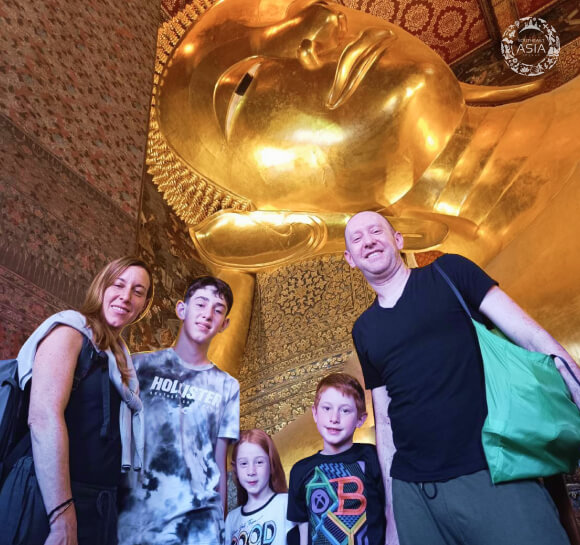
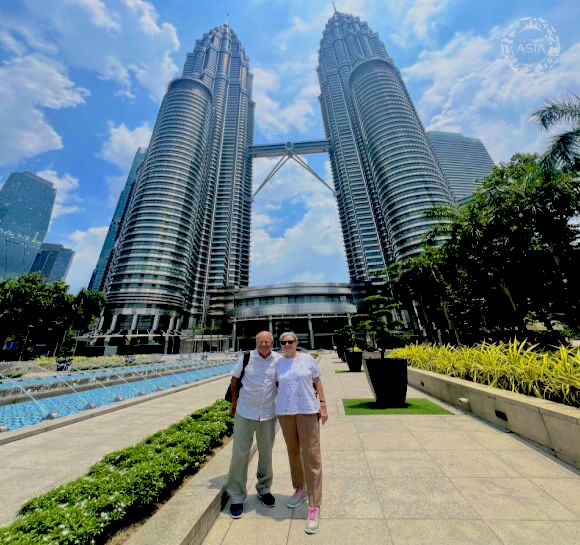
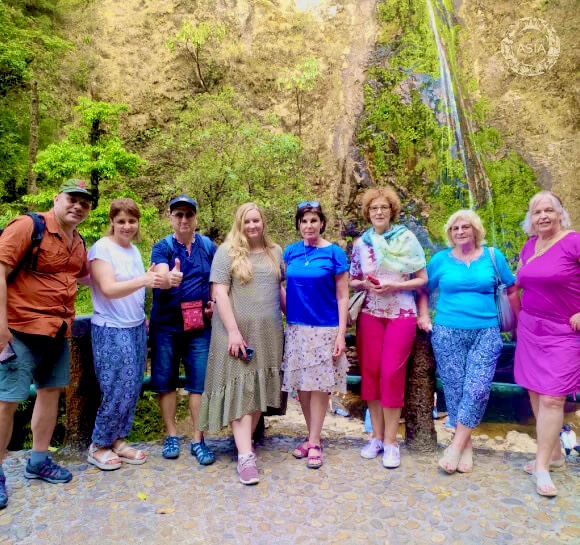

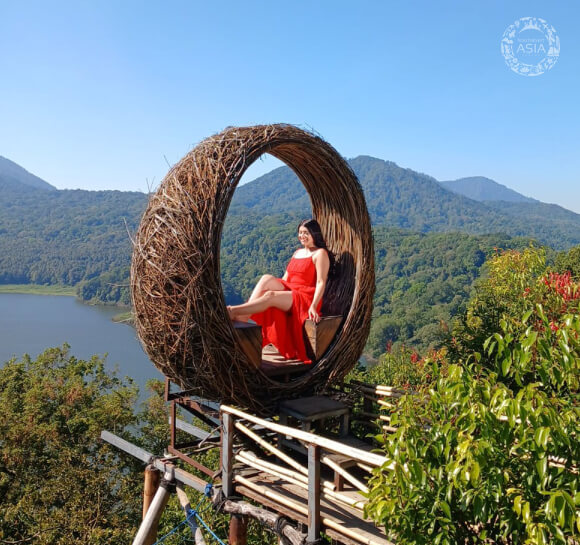
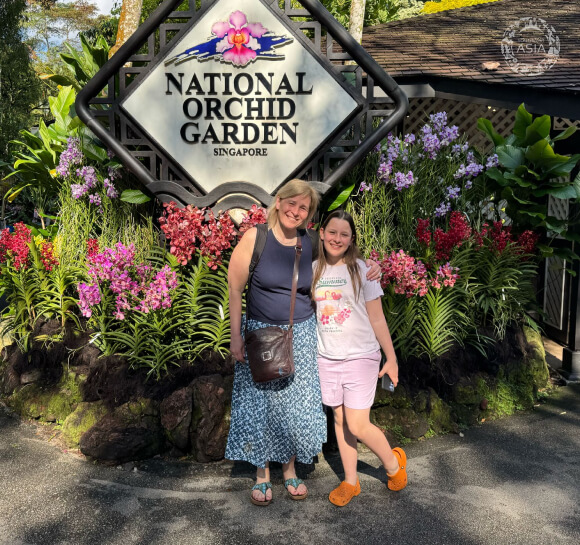
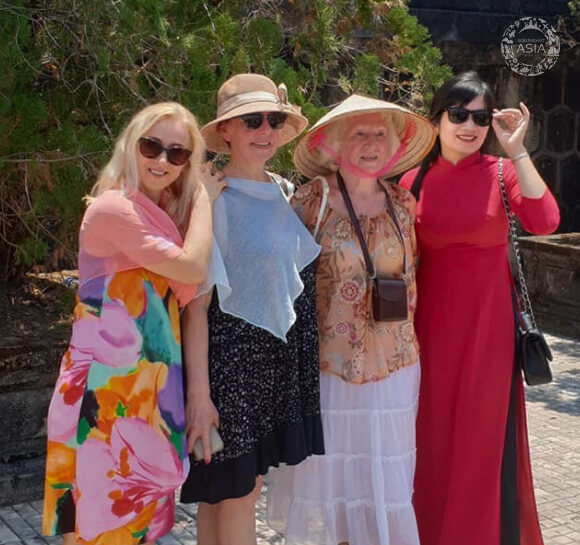
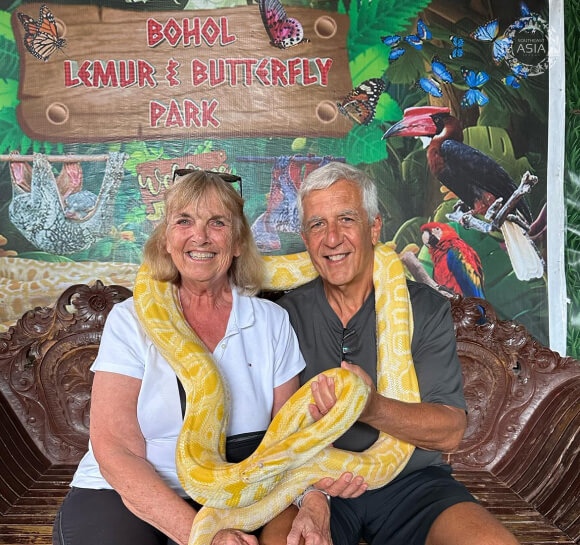
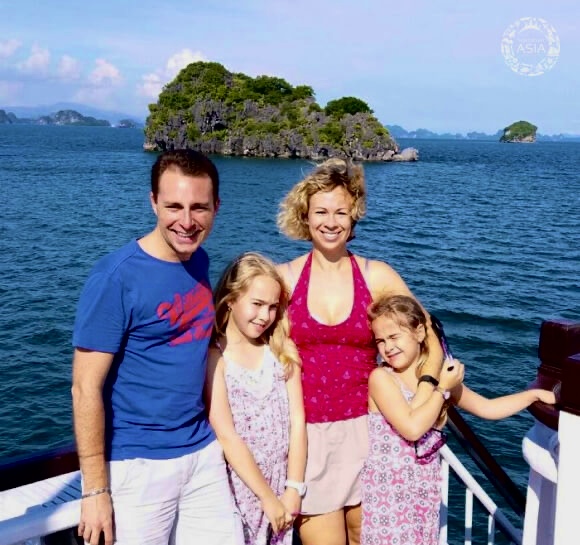
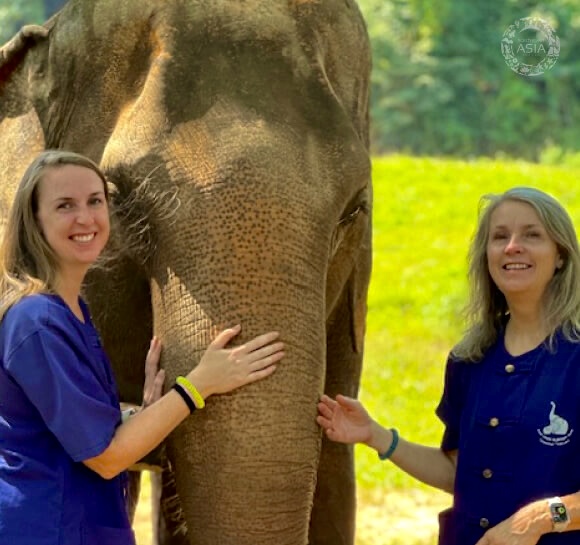
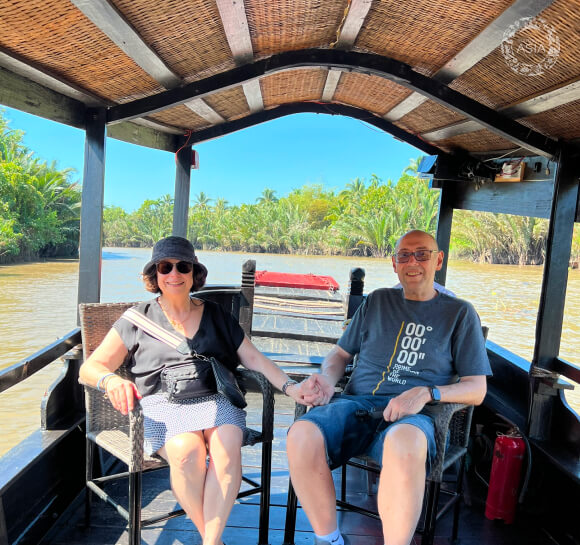
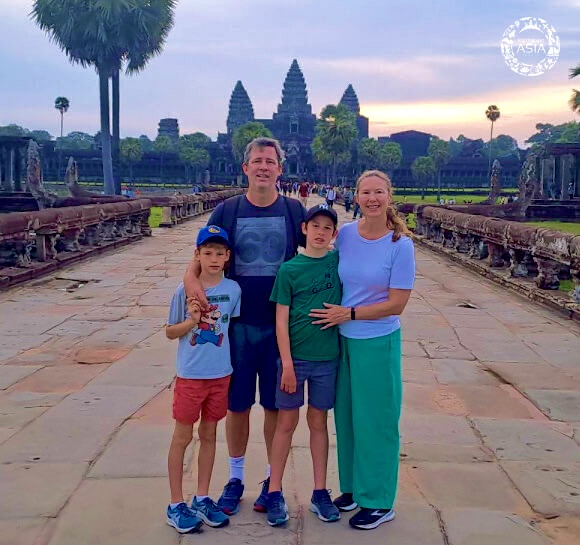














Southeast Asia Travel Guide
Stay inspired with our latest updates on Southeast Asia travel. Find out helpful information on destination highlights, cultural insights, and travel tips to enhance your journey!
Christmas Holiday in Southeast Asia: Festive Events and Tropical Vibes
When winter blankets much of the world in snow, Christmas in Southeast Asia offers a refreshing alternative - warm sunshine, palm-fringed beaches, vibrant cities, and joyful festive events blending...
Escape the Winter Chill: Best Tropical Destinations in Southeast Asia for a December Getaway
When winter winds begin to sweep across the Northern Hemisphere, Southeast Asia transforms into a sun-kissed sanctuary where golden beaches, turquoise waters, and warm breezes await. December...
Hello December: Best Season to Explore Southeast Asia
December marks the beginning of the most travel-friendly months in Southeast Asia. With clear skies, pleasant temperatures, and minimal rainfall across much of the region, this is the perfect time...
Best Southeast Asia Tours Recommended for First-Timers
Southeast Asia is one of the most enchanting regions in the world, with rich cultures, ancient temples, stunning coastlines, and lush landscapes. For first-time travelers, choosing the right...
Best Philippines Tour Packages: 5 Inspiring Itineraries for Your Next Island Escape
With more than 7,000 islands, the Philippines is a tropical wonderland of Southeast Asia, offering a diverse mix of pristine beaches, breathtaking landscapes, rich culture, and warm hospitality. From...
Southeast Asia Travel: Best Destinations to Celebrate Christmas
While Southeast Asia is often associated with tropical beaches and bustling cities, it offers some fantastic destinations to have fun at Christmas, especially for those looking for a unique and...
Christmas Holiday in Southeast Asia: Festive Events and Tropical Vibes
When winter blankets much of the world in snow, Christmas in Southeast Asia offers a refreshing alternative - warm sunshine, palm-fringed beaches, vibrant cities, and joyful festive events blending...
Escape the Winter Chill: Best Tropical Destinations in Southeast Asia for a December Getaway
When winter winds begin to sweep across the Northern Hemisphere, Southeast Asia transforms into a sun-kissed sanctuary where golden beaches, turquoise waters, and warm breezes await. December...
Hello December: Best Season to Explore Southeast Asia
December marks the beginning of the most travel-friendly months in Southeast Asia. With clear skies, pleasant temperatures, and minimal rainfall across much of the region, this is the perfect time...
Best Southeast Asia Tours Recommended for First-Timers
Southeast Asia is one of the most enchanting regions in the world, with rich cultures, ancient temples, stunning coastlines, and lush landscapes. For first-time travelers, choosing the right...
Best Philippines Tour Packages: 5 Inspiring Itineraries for Your Next Island Escape
With more than 7,000 islands, the Philippines is a tropical wonderland of Southeast Asia, offering a diverse mix of pristine beaches, breathtaking landscapes, rich culture, and warm hospitality. From...
Southeast Asia Travel: Best Destinations to Celebrate Christmas
While Southeast Asia is often associated with tropical beaches and bustling cities, it offers some fantastic destinations to have fun at Christmas, especially for those looking for a unique and...
Southeast Asia Travel Brochures
Welcome to our collection of Southeast Asia Travel Brochures - your essential companion for discovering the wonders of this vibrant region. Whether you’re dreaming of the ancient ruins of Angkor, the tropical beaches of Phuket, or the cultural treasures of Bali, our brochures provide detailed travel insights across nearly every Southeast Asian country, including Vietnam, Cambodia, Laos, Thailand, Malaysia, Myanmar, Indonesia, Singapore, and the Philippines. Inside, you’ll find expert tips on the best time to visit, top destinations, travel styles, ideal trip durations, and accommodation options. Local guides on cuisine, festivals, and customs are also included to help you explore with confidence. These Southeast Asia Travel Brochures are designed to inspire and simplify your travel planning, offering the perfect starting point for an exciting and well-prepared adventure. Let your Southeast Asia adventure begin here!

Customize Southeast Asia Tours


Adventure Travel Trade Association


American Society of Travel Agents
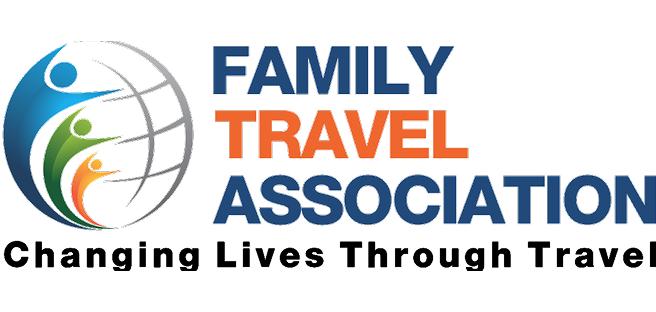
Family Travel Association


TripAdvisor


The guardian


World Travel Awards
ABOUT US
Why Us Trusted Travel Company What Makes Us Different Meet Our Team Southeast Asia Travel Guide Southeast Asia Tour Highlights Pre-departures Deposit & Payment Cancellation Policy Terms and Conditions Contact UsOur Destinations
Vietnam Tours Cambodia Tours Thailand Tours Indonesia Tours Malaysia Tours Philippines Tours Laos Tours Singapore Tours Myanmar ToursMulti-country
Vietnam Cambodia Tours Vietnam Cambodia Laos Tours Vietnam Thailand Tours Vietnam Cambodia Thailand Tours Thailand Malaysia Tours Thailand Malaysia Indonesia Tours Indonesia Thailand Tours Indonesia Malaysia Vietnam Tours Southeast Asia Tours 26 - 30 Days Southeast Asia Tours 18 - 26 Days Southeast Asia Tours 12 - 18 DaysTravel Themes
Best Southeast Asia Tours Southeast Asia Heritage & Culture Tours Southeast Asia Nature & Wildlife Tours Southeast Asia Family Tours Southeast Asia Honeymoon Tours Southeast Asia Adventure & Outdoor Tours Southeast Asia Beach & Island Tours Southeast Asia Cruise Tours Southeast Asia Tours 8 - 12 Days Southeast Asia Tours < 8 DaysSOUTHEAST ASIA TRAVEL COMPANY LIMITED
Southeast Asia Travel is an award-winning travel company specializing in bespoke, private and luxury tour packages across Vietnam, Laos, Cambodia, Thailand, Singapore, Malaysia, Indonesia, Myanmar, the Philippines and beyond. With over 15 years of industry expertise, we have guided more than 30,000 travelers on unforgettable journeys through the heart of Southeast Asia. Every Southeast Asia Tour we create is fully customized to reflect your interests, whether you seek hidden gems, iconic landmarks or personalized experiences.
Read more